Desklib: Online Library for Study Material
VerifiedAdded on 2023/02/06
|33
|12465
|88
AI Summary
Desklib is an online library that offers study material such as solved assignments, essays, and dissertations. It provides a wide range of content for various subjects and courses. Find relevant study material for your college or university.
Contribute Materials
Your contribution can guide someone’s learning journey. Share your
documents today.
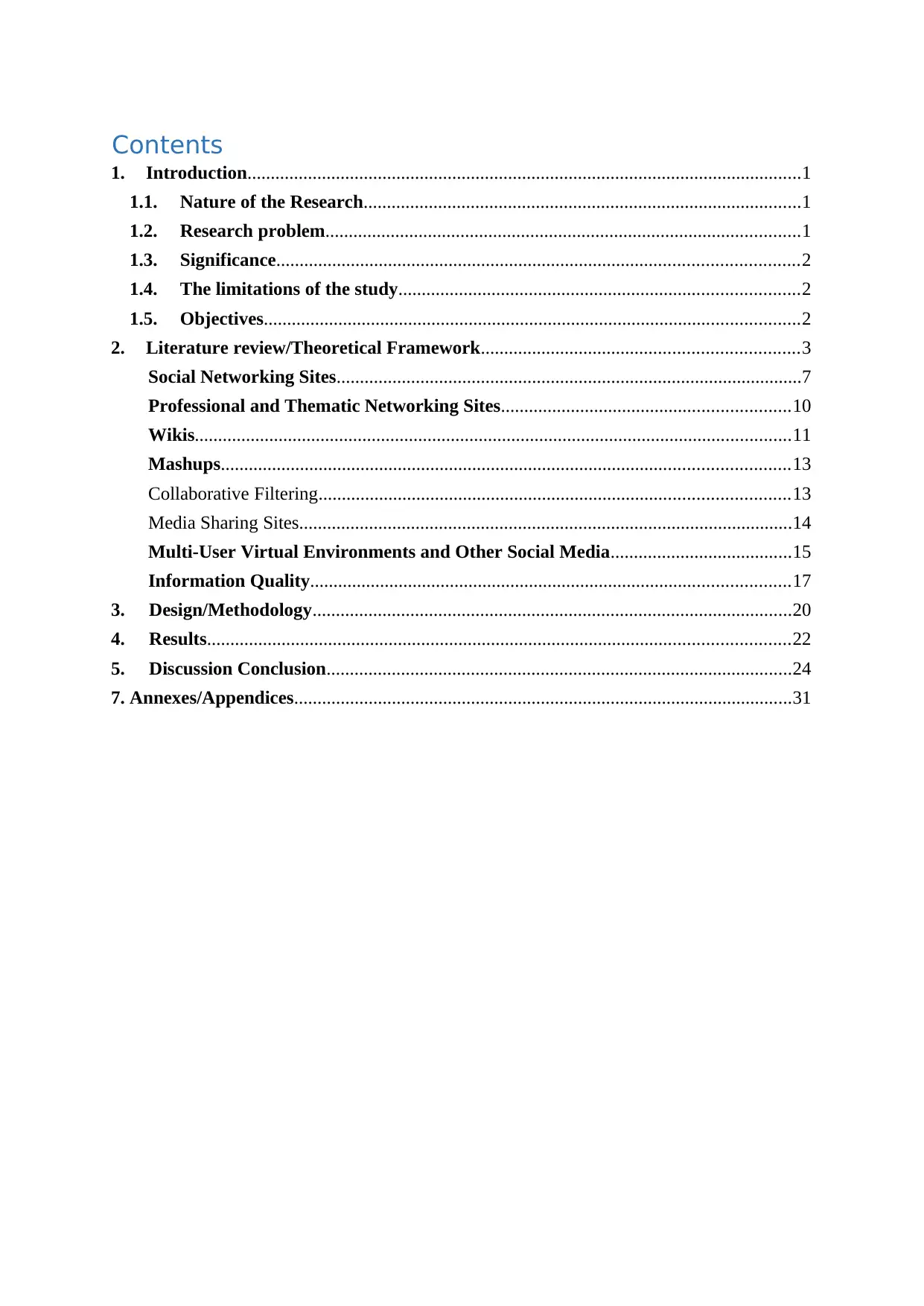
Contents
1. Introduction.......................................................................................................................1
1.1. Nature of the Research..............................................................................................1
1.2. Research problem......................................................................................................1
1.3. Significance................................................................................................................2
1.4. The limitations of the study......................................................................................2
1.5. Objectives...................................................................................................................2
2. Literature review/Theoretical Framework....................................................................3
Social Networking Sites....................................................................................................7
Professional and Thematic Networking Sites..............................................................10
Wikis................................................................................................................................11
Mashups..........................................................................................................................13
Collaborative Filtering.....................................................................................................13
Media Sharing Sites..........................................................................................................14
Multi-User Virtual Environments and Other Social Media.......................................15
Information Quality.......................................................................................................17
3. Design/Methodology.......................................................................................................20
4. Results.............................................................................................................................22
5. Discussion Conclusion....................................................................................................24
7. Annexes/Appendices...........................................................................................................31
1. Introduction.......................................................................................................................1
1.1. Nature of the Research..............................................................................................1
1.2. Research problem......................................................................................................1
1.3. Significance................................................................................................................2
1.4. The limitations of the study......................................................................................2
1.5. Objectives...................................................................................................................2
2. Literature review/Theoretical Framework....................................................................3
Social Networking Sites....................................................................................................7
Professional and Thematic Networking Sites..............................................................10
Wikis................................................................................................................................11
Mashups..........................................................................................................................13
Collaborative Filtering.....................................................................................................13
Media Sharing Sites..........................................................................................................14
Multi-User Virtual Environments and Other Social Media.......................................15
Information Quality.......................................................................................................17
3. Design/Methodology.......................................................................................................20
4. Results.............................................................................................................................22
5. Discussion Conclusion....................................................................................................24
7. Annexes/Appendices...........................................................................................................31
Secure Best Marks with AI Grader
Need help grading? Try our AI Grader for instant feedback on your assignments.
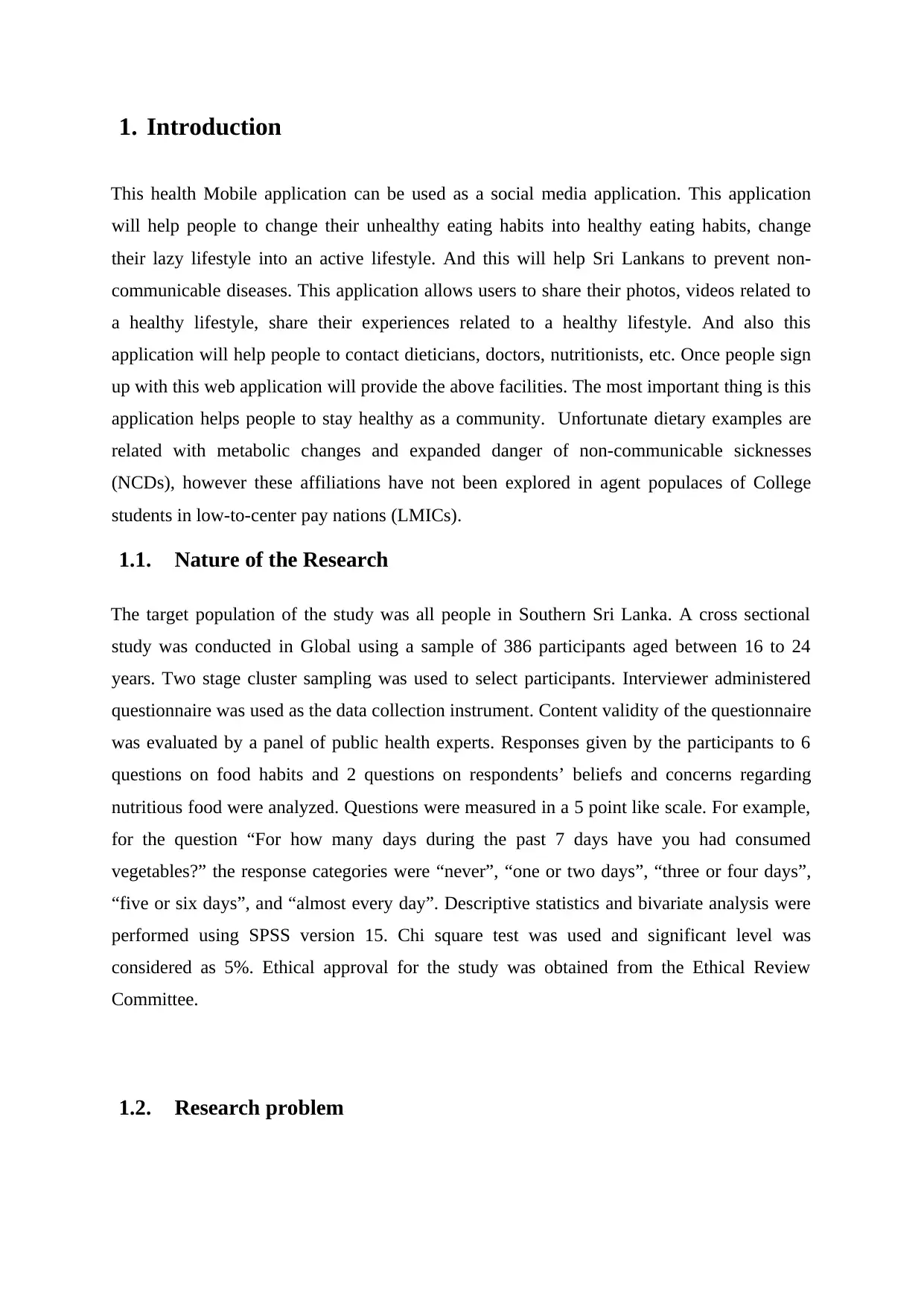
1. Introduction
This health Mobile application can be used as a social media application. This application
will help people to change their unhealthy eating habits into healthy eating habits, change
their lazy lifestyle into an active lifestyle. And this will help Sri Lankans to prevent non-
communicable diseases. This application allows users to share their photos, videos related to
a healthy lifestyle, share their experiences related to a healthy lifestyle. And also this
application will help people to contact dieticians, doctors, nutritionists, etc. Once people sign
up with this web application will provide the above facilities. The most important thing is this
application helps people to stay healthy as a community. Unfortunate dietary examples are
related with metabolic changes and expanded danger of non-communicable sicknesses
(NCDs), however these affiliations have not been explored in agent populaces of College
students in low-to-center pay nations (LMICs).
1.1. Nature of the Research
The target population of the study was all people in Southern Sri Lanka. A cross sectional
study was conducted in Global using a sample of 386 participants aged between 16 to 24
years. Two stage cluster sampling was used to select participants. Interviewer administered
questionnaire was used as the data collection instrument. Content validity of the questionnaire
was evaluated by a panel of public health experts. Responses given by the participants to 6
questions on food habits and 2 questions on respondents’ beliefs and concerns regarding
nutritious food were analyzed. Questions were measured in a 5 point like scale. For example,
for the question “For how many days during the past 7 days have you had consumed
vegetables?” the response categories were “never”, “one or two days”, “three or four days”,
“five or six days”, and “almost every day”. Descriptive statistics and bivariate analysis were
performed using SPSS version 15. Chi square test was used and significant level was
considered as 5%. Ethical approval for the study was obtained from the Ethical Review
Committee.
1.2. Research problem
This health Mobile application can be used as a social media application. This application
will help people to change their unhealthy eating habits into healthy eating habits, change
their lazy lifestyle into an active lifestyle. And this will help Sri Lankans to prevent non-
communicable diseases. This application allows users to share their photos, videos related to
a healthy lifestyle, share their experiences related to a healthy lifestyle. And also this
application will help people to contact dieticians, doctors, nutritionists, etc. Once people sign
up with this web application will provide the above facilities. The most important thing is this
application helps people to stay healthy as a community. Unfortunate dietary examples are
related with metabolic changes and expanded danger of non-communicable sicknesses
(NCDs), however these affiliations have not been explored in agent populaces of College
students in low-to-center pay nations (LMICs).
1.1. Nature of the Research
The target population of the study was all people in Southern Sri Lanka. A cross sectional
study was conducted in Global using a sample of 386 participants aged between 16 to 24
years. Two stage cluster sampling was used to select participants. Interviewer administered
questionnaire was used as the data collection instrument. Content validity of the questionnaire
was evaluated by a panel of public health experts. Responses given by the participants to 6
questions on food habits and 2 questions on respondents’ beliefs and concerns regarding
nutritious food were analyzed. Questions were measured in a 5 point like scale. For example,
for the question “For how many days during the past 7 days have you had consumed
vegetables?” the response categories were “never”, “one or two days”, “three or four days”,
“five or six days”, and “almost every day”. Descriptive statistics and bivariate analysis were
performed using SPSS version 15. Chi square test was used and significant level was
considered as 5%. Ethical approval for the study was obtained from the Ethical Review
Committee.
1.2. Research problem
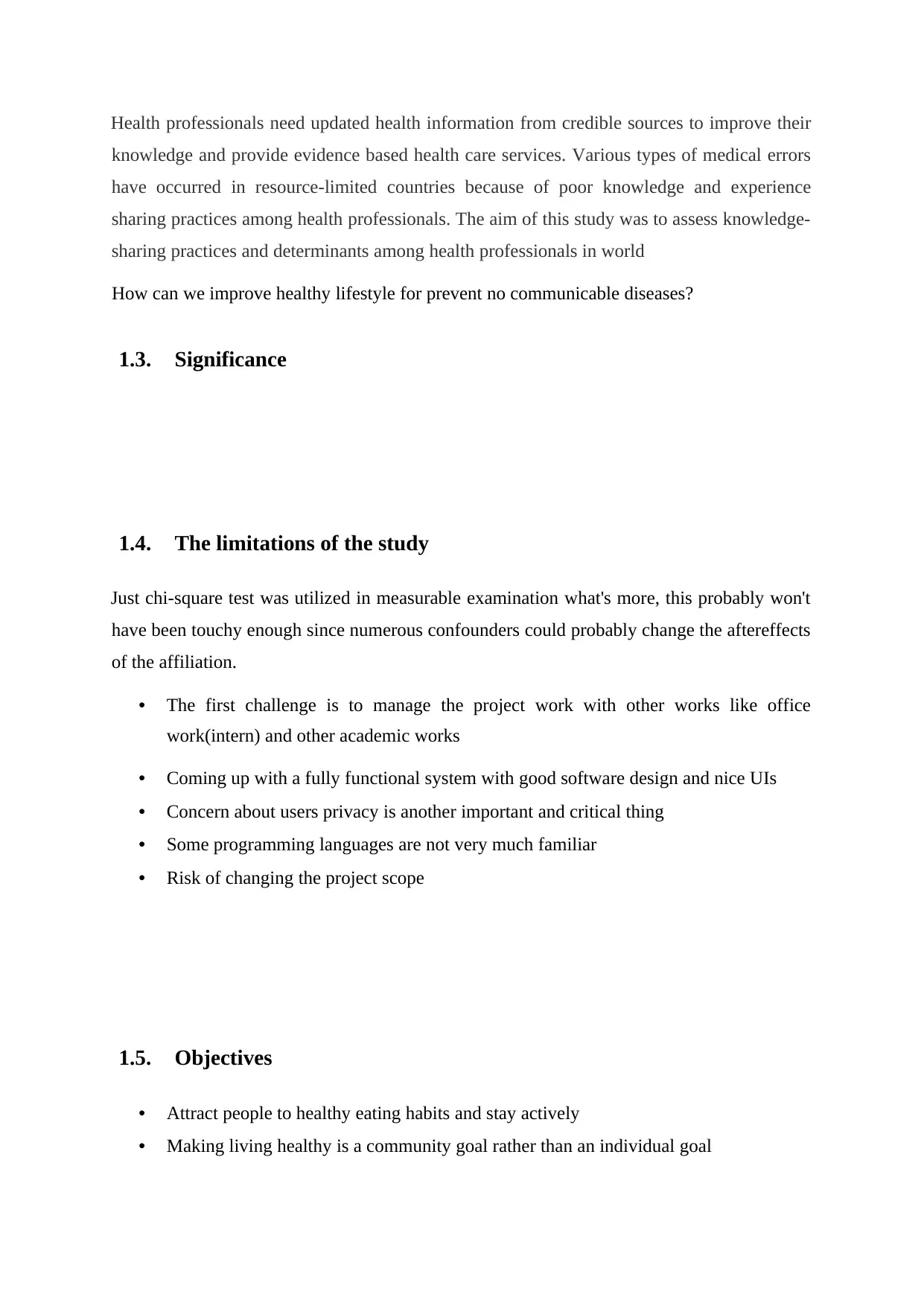
Health professionals need updated health information from credible sources to improve their
knowledge and provide evidence based health care services. Various types of medical errors
have occurred in resource-limited countries because of poor knowledge and experience
sharing practices among health professionals. The aim of this study was to assess knowledge-
sharing practices and determinants among health professionals in world
How can we improve healthy lifestyle for prevent no communicable diseases?
1.3. Significance
1.4. The limitations of the study
Just chi-square test was utilized in measurable examination what's more, this probably won't
have been touchy enough since numerous confounders could probably change the aftereffects
of the affiliation.
• The first challenge is to manage the project work with other works like office
work(intern) and other academic works
• Coming up with a fully functional system with good software design and nice UIs
• Concern about users privacy is another important and critical thing
• Some programming languages are not very much familiar
• Risk of changing the project scope
1.5. Objectives
• Attract people to healthy eating habits and stay actively
• Making living healthy is a community goal rather than an individual goal
knowledge and provide evidence based health care services. Various types of medical errors
have occurred in resource-limited countries because of poor knowledge and experience
sharing practices among health professionals. The aim of this study was to assess knowledge-
sharing practices and determinants among health professionals in world
How can we improve healthy lifestyle for prevent no communicable diseases?
1.3. Significance
1.4. The limitations of the study
Just chi-square test was utilized in measurable examination what's more, this probably won't
have been touchy enough since numerous confounders could probably change the aftereffects
of the affiliation.
• The first challenge is to manage the project work with other works like office
work(intern) and other academic works
• Coming up with a fully functional system with good software design and nice UIs
• Concern about users privacy is another important and critical thing
• Some programming languages are not very much familiar
• Risk of changing the project scope
1.5. Objectives
• Attract people to healthy eating habits and stay actively
• Making living healthy is a community goal rather than an individual goal
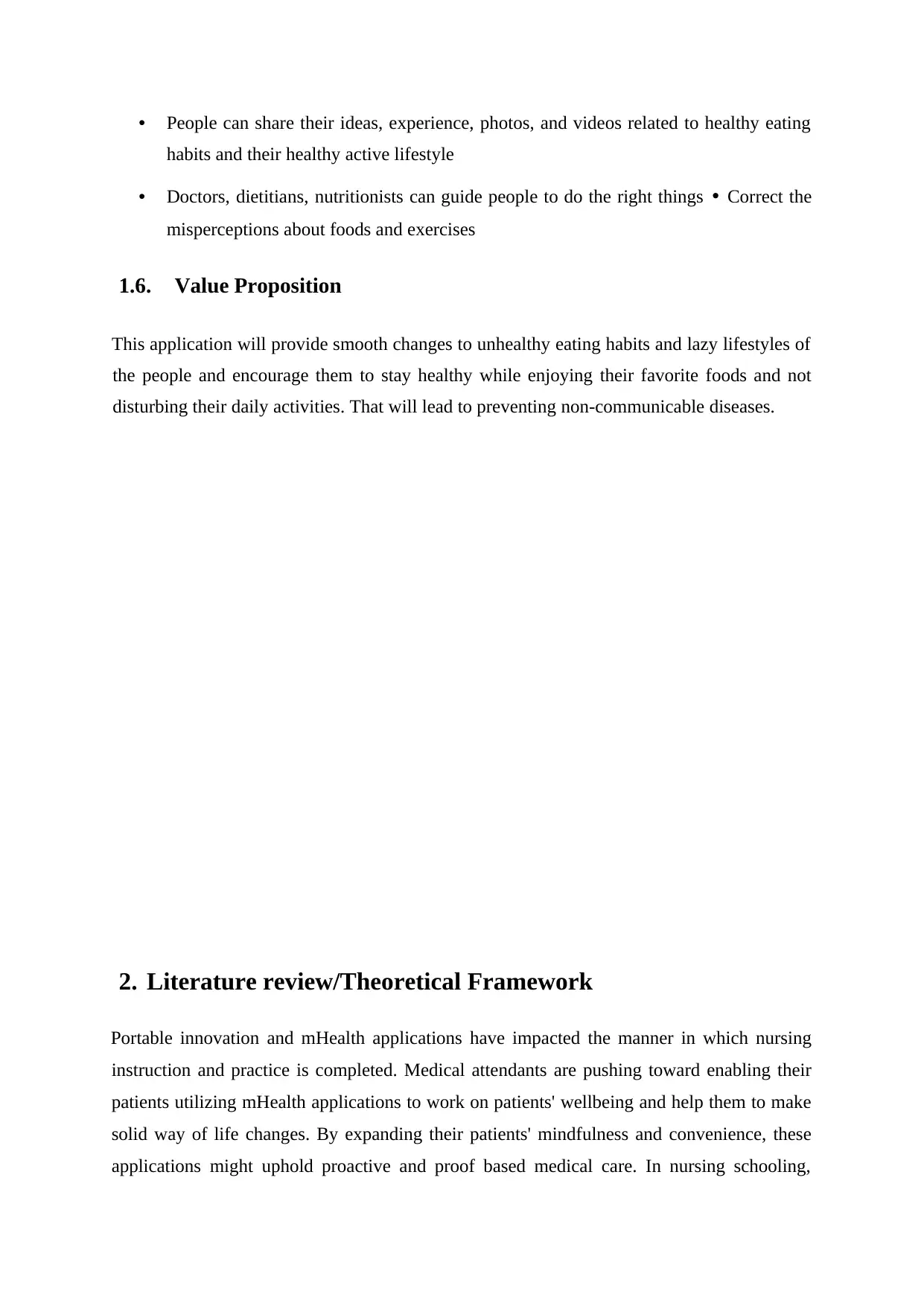
• People can share their ideas, experience, photos, and videos related to healthy eating
habits and their healthy active lifestyle
• Doctors, dietitians, nutritionists can guide people to do the right things • Correct the
misperceptions about foods and exercises
1.6. Value Proposition
This application will provide smooth changes to unhealthy eating habits and lazy lifestyles of
the people and encourage them to stay healthy while enjoying their favorite foods and not
disturbing their daily activities. That will lead to preventing non-communicable diseases.
2. Literature review/Theoretical Framework
Portable innovation and mHealth applications have impacted the manner in which nursing
instruction and practice is completed. Medical attendants are pushing toward enabling their
patients utilizing mHealth applications to work on patients' wellbeing and help them to make
solid way of life changes. By expanding their patients' mindfulness and convenience, these
applications might uphold proactive and proof based medical care. In nursing schooling,
habits and their healthy active lifestyle
• Doctors, dietitians, nutritionists can guide people to do the right things • Correct the
misperceptions about foods and exercises
1.6. Value Proposition
This application will provide smooth changes to unhealthy eating habits and lazy lifestyles of
the people and encourage them to stay healthy while enjoying their favorite foods and not
disturbing their daily activities. That will lead to preventing non-communicable diseases.
2. Literature review/Theoretical Framework
Portable innovation and mHealth applications have impacted the manner in which nursing
instruction and practice is completed. Medical attendants are pushing toward enabling their
patients utilizing mHealth applications to work on patients' wellbeing and help them to make
solid way of life changes. By expanding their patients' mindfulness and convenience, these
applications might uphold proactive and proof based medical care. In nursing schooling,
Secure Best Marks with AI Grader
Need help grading? Try our AI Grader for instant feedback on your assignments.
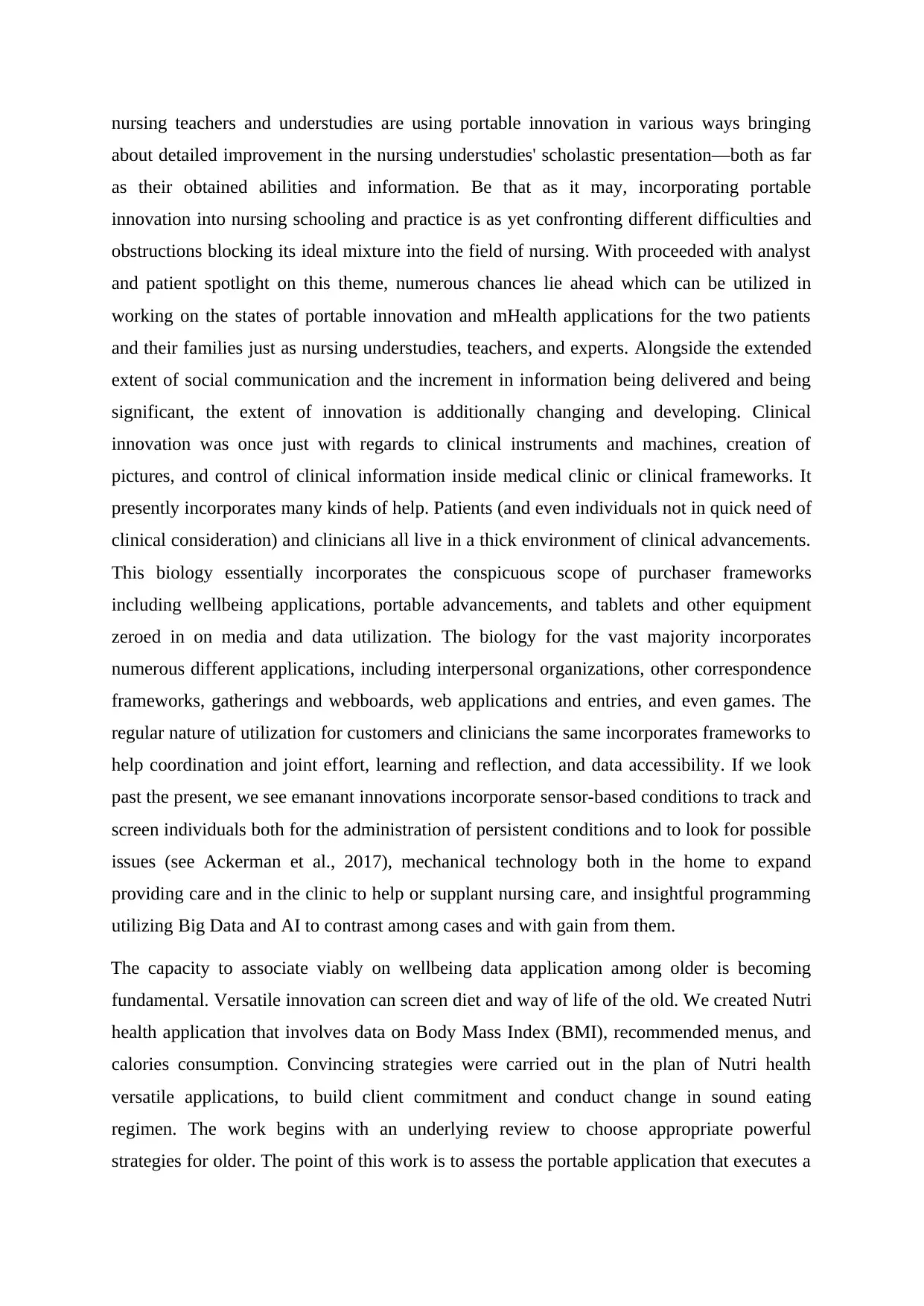
nursing teachers and understudies are using portable innovation in various ways bringing
about detailed improvement in the nursing understudies' scholastic presentation—both as far
as their obtained abilities and information. Be that as it may, incorporating portable
innovation into nursing schooling and practice is as yet confronting different difficulties and
obstructions blocking its ideal mixture into the field of nursing. With proceeded with analyst
and patient spotlight on this theme, numerous chances lie ahead which can be utilized in
working on the states of portable innovation and mHealth applications for the two patients
and their families just as nursing understudies, teachers, and experts. Alongside the extended
extent of social communication and the increment in information being delivered and being
significant, the extent of innovation is additionally changing and developing. Clinical
innovation was once just with regards to clinical instruments and machines, creation of
pictures, and control of clinical information inside medical clinic or clinical frameworks. It
presently incorporates many kinds of help. Patients (and even individuals not in quick need of
clinical consideration) and clinicians all live in a thick environment of clinical advancements.
This biology essentially incorporates the conspicuous scope of purchaser frameworks
including wellbeing applications, portable advancements, and tablets and other equipment
zeroed in on media and data utilization. The biology for the vast majority incorporates
numerous different applications, including interpersonal organizations, other correspondence
frameworks, gatherings and webboards, web applications and entries, and even games. The
regular nature of utilization for customers and clinicians the same incorporates frameworks to
help coordination and joint effort, learning and reflection, and data accessibility. If we look
past the present, we see emanant innovations incorporate sensor-based conditions to track and
screen individuals both for the administration of persistent conditions and to look for possible
issues (see Ackerman et al., 2017), mechanical technology both in the home to expand
providing care and in the clinic to help or supplant nursing care, and insightful programming
utilizing Big Data and AI to contrast among cases and with gain from them.
The capacity to associate viably on wellbeing data application among older is becoming
fundamental. Versatile innovation can screen diet and way of life of the old. We created Nutri
health application that involves data on Body Mass Index (BMI), recommended menus, and
calories consumption. Convincing strategies were carried out in the plan of Nutri health
versatile applications, to build client commitment and conduct change in sound eating
regimen. The work begins with an underlying review to choose appropriate powerful
strategies for older. The point of this work is to assess the portable application that executes a
about detailed improvement in the nursing understudies' scholastic presentation—both as far
as their obtained abilities and information. Be that as it may, incorporating portable
innovation into nursing schooling and practice is as yet confronting different difficulties and
obstructions blocking its ideal mixture into the field of nursing. With proceeded with analyst
and patient spotlight on this theme, numerous chances lie ahead which can be utilized in
working on the states of portable innovation and mHealth applications for the two patients
and their families just as nursing understudies, teachers, and experts. Alongside the extended
extent of social communication and the increment in information being delivered and being
significant, the extent of innovation is additionally changing and developing. Clinical
innovation was once just with regards to clinical instruments and machines, creation of
pictures, and control of clinical information inside medical clinic or clinical frameworks. It
presently incorporates many kinds of help. Patients (and even individuals not in quick need of
clinical consideration) and clinicians all live in a thick environment of clinical advancements.
This biology essentially incorporates the conspicuous scope of purchaser frameworks
including wellbeing applications, portable advancements, and tablets and other equipment
zeroed in on media and data utilization. The biology for the vast majority incorporates
numerous different applications, including interpersonal organizations, other correspondence
frameworks, gatherings and webboards, web applications and entries, and even games. The
regular nature of utilization for customers and clinicians the same incorporates frameworks to
help coordination and joint effort, learning and reflection, and data accessibility. If we look
past the present, we see emanant innovations incorporate sensor-based conditions to track and
screen individuals both for the administration of persistent conditions and to look for possible
issues (see Ackerman et al., 2017), mechanical technology both in the home to expand
providing care and in the clinic to help or supplant nursing care, and insightful programming
utilizing Big Data and AI to contrast among cases and with gain from them.
The capacity to associate viably on wellbeing data application among older is becoming
fundamental. Versatile innovation can screen diet and way of life of the old. We created Nutri
health application that involves data on Body Mass Index (BMI), recommended menus, and
calories consumption. Convincing strategies were carried out in the plan of Nutri health
versatile applications, to build client commitment and conduct change in sound eating
regimen. The work begins with an underlying review to choose appropriate powerful
strategies for older. The point of this work is to assess the portable application that executes a
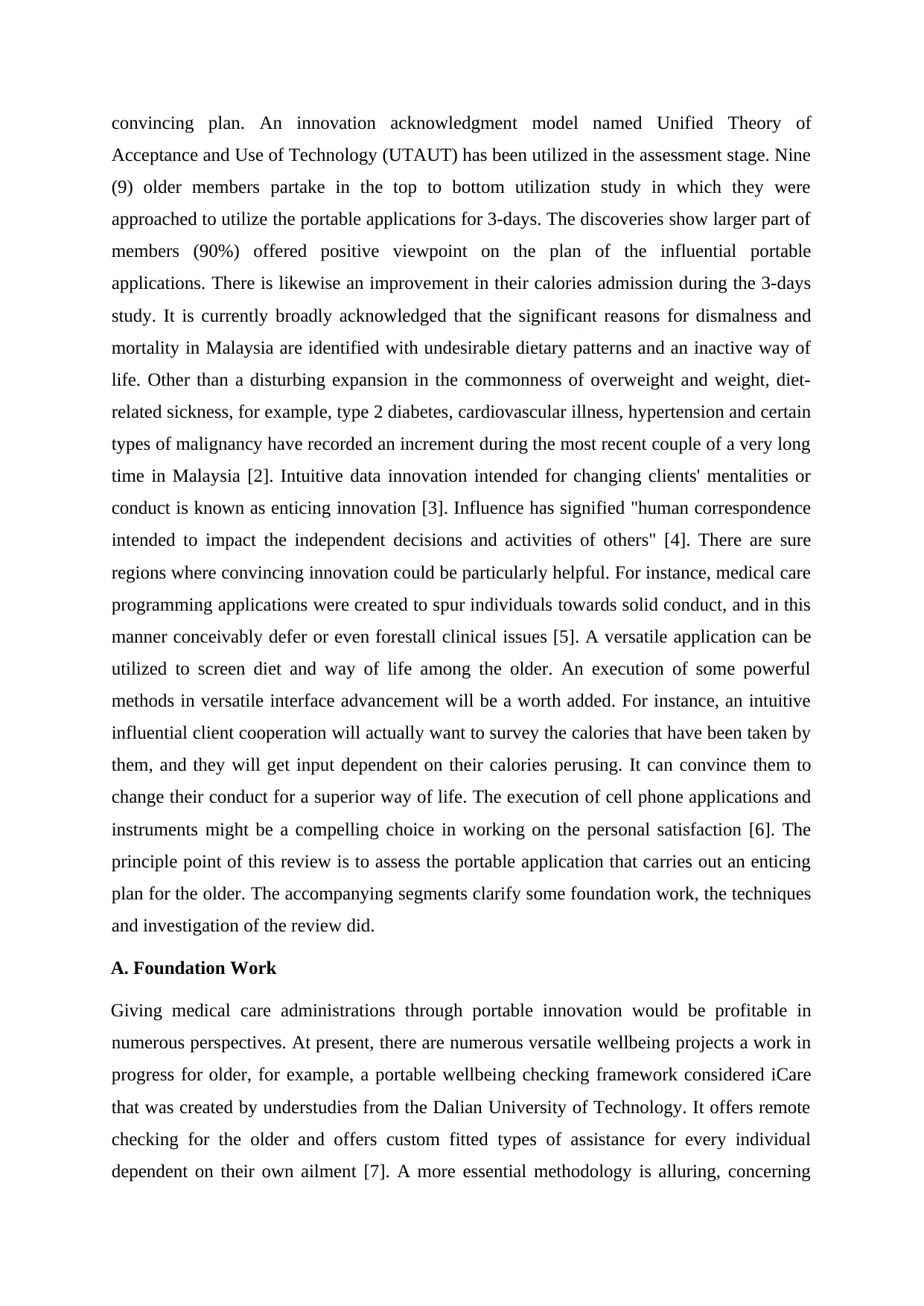
convincing plan. An innovation acknowledgment model named Unified Theory of
Acceptance and Use of Technology (UTAUT) has been utilized in the assessment stage. Nine
(9) older members partake in the top to bottom utilization study in which they were
approached to utilize the portable applications for 3-days. The discoveries show larger part of
members (90%) offered positive viewpoint on the plan of the influential portable
applications. There is likewise an improvement in their calories admission during the 3-days
study. It is currently broadly acknowledged that the significant reasons for dismalness and
mortality in Malaysia are identified with undesirable dietary patterns and an inactive way of
life. Other than a disturbing expansion in the commonness of overweight and weight, diet-
related sickness, for example, type 2 diabetes, cardiovascular illness, hypertension and certain
types of malignancy have recorded an increment during the most recent couple of a very long
time in Malaysia [2]. Intuitive data innovation intended for changing clients' mentalities or
conduct is known as enticing innovation [3]. Influence has signified "human correspondence
intended to impact the independent decisions and activities of others" [4]. There are sure
regions where convincing innovation could be particularly helpful. For instance, medical care
programming applications were created to spur individuals towards solid conduct, and in this
manner conceivably defer or even forestall clinical issues [5]. A versatile application can be
utilized to screen diet and way of life among the older. An execution of some powerful
methods in versatile interface advancement will be a worth added. For instance, an intuitive
influential client cooperation will actually want to survey the calories that have been taken by
them, and they will get input dependent on their calories perusing. It can convince them to
change their conduct for a superior way of life. The execution of cell phone applications and
instruments might be a compelling choice in working on the personal satisfaction [6]. The
principle point of this review is to assess the portable application that carries out an enticing
plan for the older. The accompanying segments clarify some foundation work, the techniques
and investigation of the review did.
A. Foundation Work
Giving medical care administrations through portable innovation would be profitable in
numerous perspectives. At present, there are numerous versatile wellbeing projects a work in
progress for older, for example, a portable wellbeing checking framework considered iCare
that was created by understudies from the Dalian University of Technology. It offers remote
checking for the older and offers custom fitted types of assistance for every individual
dependent on their own ailment [7]. A more essential methodology is alluring, concerning
Acceptance and Use of Technology (UTAUT) has been utilized in the assessment stage. Nine
(9) older members partake in the top to bottom utilization study in which they were
approached to utilize the portable applications for 3-days. The discoveries show larger part of
members (90%) offered positive viewpoint on the plan of the influential portable
applications. There is likewise an improvement in their calories admission during the 3-days
study. It is currently broadly acknowledged that the significant reasons for dismalness and
mortality in Malaysia are identified with undesirable dietary patterns and an inactive way of
life. Other than a disturbing expansion in the commonness of overweight and weight, diet-
related sickness, for example, type 2 diabetes, cardiovascular illness, hypertension and certain
types of malignancy have recorded an increment during the most recent couple of a very long
time in Malaysia [2]. Intuitive data innovation intended for changing clients' mentalities or
conduct is known as enticing innovation [3]. Influence has signified "human correspondence
intended to impact the independent decisions and activities of others" [4]. There are sure
regions where convincing innovation could be particularly helpful. For instance, medical care
programming applications were created to spur individuals towards solid conduct, and in this
manner conceivably defer or even forestall clinical issues [5]. A versatile application can be
utilized to screen diet and way of life among the older. An execution of some powerful
methods in versatile interface advancement will be a worth added. For instance, an intuitive
influential client cooperation will actually want to survey the calories that have been taken by
them, and they will get input dependent on their calories perusing. It can convince them to
change their conduct for a superior way of life. The execution of cell phone applications and
instruments might be a compelling choice in working on the personal satisfaction [6]. The
principle point of this review is to assess the portable application that carries out an enticing
plan for the older. The accompanying segments clarify some foundation work, the techniques
and investigation of the review did.
A. Foundation Work
Giving medical care administrations through portable innovation would be profitable in
numerous perspectives. At present, there are numerous versatile wellbeing projects a work in
progress for older, for example, a portable wellbeing checking framework considered iCare
that was created by understudies from the Dalian University of Technology. It offers remote
checking for the older and offers custom fitted types of assistance for every individual
dependent on their own ailment [7]. A more essential methodology is alluring, concerning
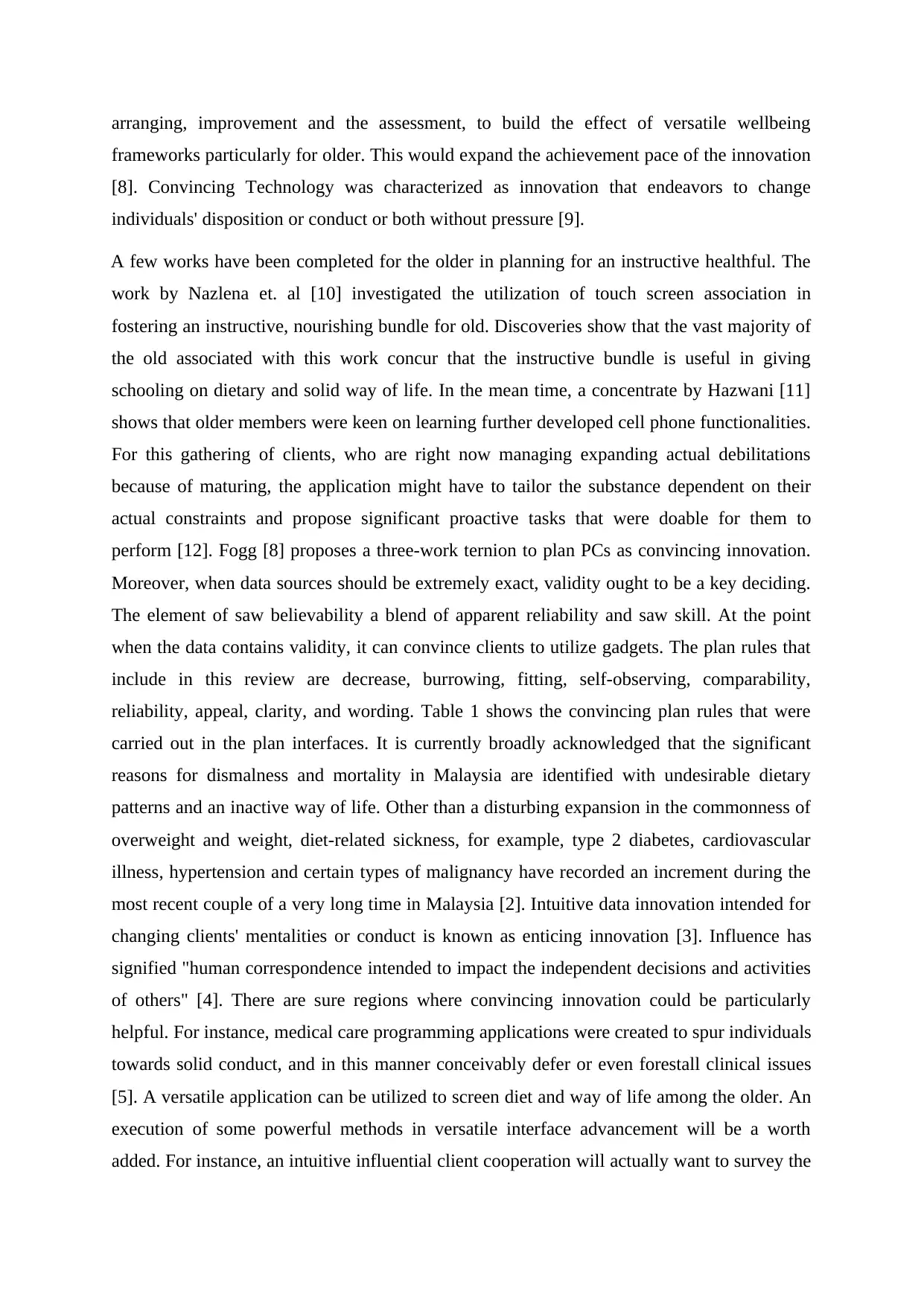
arranging, improvement and the assessment, to build the effect of versatile wellbeing
frameworks particularly for older. This would expand the achievement pace of the innovation
[8]. Convincing Technology was characterized as innovation that endeavors to change
individuals' disposition or conduct or both without pressure [9].
A few works have been completed for the older in planning for an instructive healthful. The
work by Nazlena et. al [10] investigated the utilization of touch screen association in
fostering an instructive, nourishing bundle for old. Discoveries show that the vast majority of
the old associated with this work concur that the instructive bundle is useful in giving
schooling on dietary and solid way of life. In the mean time, a concentrate by Hazwani [11]
shows that older members were keen on learning further developed cell phone functionalities.
For this gathering of clients, who are right now managing expanding actual debilitations
because of maturing, the application might have to tailor the substance dependent on their
actual constraints and propose significant proactive tasks that were doable for them to
perform [12]. Fogg [8] proposes a three-work ternion to plan PCs as convincing innovation.
Moreover, when data sources should be extremely exact, validity ought to be a key deciding.
The element of saw believability a blend of apparent reliability and saw skill. At the point
when the data contains validity, it can convince clients to utilize gadgets. The plan rules that
include in this review are decrease, burrowing, fitting, self-observing, comparability,
reliability, appeal, clarity, and wording. Table 1 shows the convincing plan rules that were
carried out in the plan interfaces. It is currently broadly acknowledged that the significant
reasons for dismalness and mortality in Malaysia are identified with undesirable dietary
patterns and an inactive way of life. Other than a disturbing expansion in the commonness of
overweight and weight, diet-related sickness, for example, type 2 diabetes, cardiovascular
illness, hypertension and certain types of malignancy have recorded an increment during the
most recent couple of a very long time in Malaysia [2]. Intuitive data innovation intended for
changing clients' mentalities or conduct is known as enticing innovation [3]. Influence has
signified "human correspondence intended to impact the independent decisions and activities
of others" [4]. There are sure regions where convincing innovation could be particularly
helpful. For instance, medical care programming applications were created to spur individuals
towards solid conduct, and in this manner conceivably defer or even forestall clinical issues
[5]. A versatile application can be utilized to screen diet and way of life among the older. An
execution of some powerful methods in versatile interface advancement will be a worth
added. For instance, an intuitive influential client cooperation will actually want to survey the
frameworks particularly for older. This would expand the achievement pace of the innovation
[8]. Convincing Technology was characterized as innovation that endeavors to change
individuals' disposition or conduct or both without pressure [9].
A few works have been completed for the older in planning for an instructive healthful. The
work by Nazlena et. al [10] investigated the utilization of touch screen association in
fostering an instructive, nourishing bundle for old. Discoveries show that the vast majority of
the old associated with this work concur that the instructive bundle is useful in giving
schooling on dietary and solid way of life. In the mean time, a concentrate by Hazwani [11]
shows that older members were keen on learning further developed cell phone functionalities.
For this gathering of clients, who are right now managing expanding actual debilitations
because of maturing, the application might have to tailor the substance dependent on their
actual constraints and propose significant proactive tasks that were doable for them to
perform [12]. Fogg [8] proposes a three-work ternion to plan PCs as convincing innovation.
Moreover, when data sources should be extremely exact, validity ought to be a key deciding.
The element of saw believability a blend of apparent reliability and saw skill. At the point
when the data contains validity, it can convince clients to utilize gadgets. The plan rules that
include in this review are decrease, burrowing, fitting, self-observing, comparability,
reliability, appeal, clarity, and wording. Table 1 shows the convincing plan rules that were
carried out in the plan interfaces. It is currently broadly acknowledged that the significant
reasons for dismalness and mortality in Malaysia are identified with undesirable dietary
patterns and an inactive way of life. Other than a disturbing expansion in the commonness of
overweight and weight, diet-related sickness, for example, type 2 diabetes, cardiovascular
illness, hypertension and certain types of malignancy have recorded an increment during the
most recent couple of a very long time in Malaysia [2]. Intuitive data innovation intended for
changing clients' mentalities or conduct is known as enticing innovation [3]. Influence has
signified "human correspondence intended to impact the independent decisions and activities
of others" [4]. There are sure regions where convincing innovation could be particularly
helpful. For instance, medical care programming applications were created to spur individuals
towards solid conduct, and in this manner conceivably defer or even forestall clinical issues
[5]. A versatile application can be utilized to screen diet and way of life among the older. An
execution of some powerful methods in versatile interface advancement will be a worth
added. For instance, an intuitive influential client cooperation will actually want to survey the
Paraphrase This Document
Need a fresh take? Get an instant paraphrase of this document with our AI Paraphraser
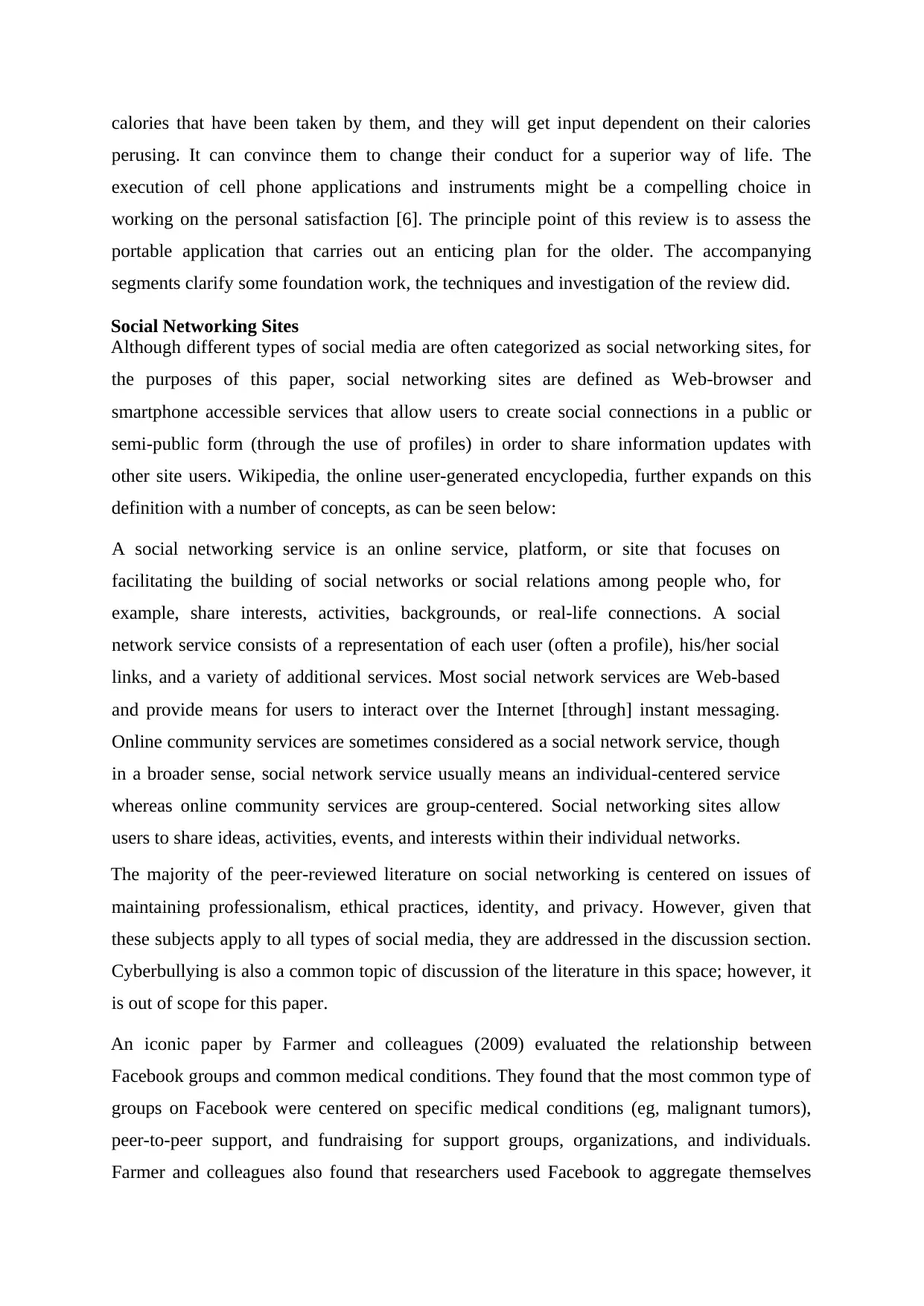
calories that have been taken by them, and they will get input dependent on their calories
perusing. It can convince them to change their conduct for a superior way of life. The
execution of cell phone applications and instruments might be a compelling choice in
working on the personal satisfaction [6]. The principle point of this review is to assess the
portable application that carries out an enticing plan for the older. The accompanying
segments clarify some foundation work, the techniques and investigation of the review did.
Social Networking Sites
Although different types of social media are often categorized as social networking sites, for
the purposes of this paper, social networking sites are defined as Web-browser and
smartphone accessible services that allow users to create social connections in a public or
semi-public form (through the use of profiles) in order to share information updates with
other site users. Wikipedia, the online user-generated encyclopedia, further expands on this
definition with a number of concepts, as can be seen below:
A social networking service is an online service, platform, or site that focuses on
facilitating the building of social networks or social relations among people who, for
example, share interests, activities, backgrounds, or real-life connections. A social
network service consists of a representation of each user (often a profile), his/her social
links, and a variety of additional services. Most social network services are Web-based
and provide means for users to interact over the Internet [through] instant messaging.
Online community services are sometimes considered as a social network service, though
in a broader sense, social network service usually means an individual-centered service
whereas online community services are group-centered. Social networking sites allow
users to share ideas, activities, events, and interests within their individual networks.
The majority of the peer-reviewed literature on social networking is centered on issues of
maintaining professionalism, ethical practices, identity, and privacy. However, given that
these subjects apply to all types of social media, they are addressed in the discussion section.
Cyberbullying is also a common topic of discussion of the literature in this space; however, it
is out of scope for this paper.
An iconic paper by Farmer and colleagues (2009) evaluated the relationship between
Facebook groups and common medical conditions. They found that the most common type of
groups on Facebook were centered on specific medical conditions (eg, malignant tumors),
peer-to-peer support, and fundraising for support groups, organizations, and individuals.
Farmer and colleagues also found that researchers used Facebook to aggregate themselves
perusing. It can convince them to change their conduct for a superior way of life. The
execution of cell phone applications and instruments might be a compelling choice in
working on the personal satisfaction [6]. The principle point of this review is to assess the
portable application that carries out an enticing plan for the older. The accompanying
segments clarify some foundation work, the techniques and investigation of the review did.
Social Networking Sites
Although different types of social media are often categorized as social networking sites, for
the purposes of this paper, social networking sites are defined as Web-browser and
smartphone accessible services that allow users to create social connections in a public or
semi-public form (through the use of profiles) in order to share information updates with
other site users. Wikipedia, the online user-generated encyclopedia, further expands on this
definition with a number of concepts, as can be seen below:
A social networking service is an online service, platform, or site that focuses on
facilitating the building of social networks or social relations among people who, for
example, share interests, activities, backgrounds, or real-life connections. A social
network service consists of a representation of each user (often a profile), his/her social
links, and a variety of additional services. Most social network services are Web-based
and provide means for users to interact over the Internet [through] instant messaging.
Online community services are sometimes considered as a social network service, though
in a broader sense, social network service usually means an individual-centered service
whereas online community services are group-centered. Social networking sites allow
users to share ideas, activities, events, and interests within their individual networks.
The majority of the peer-reviewed literature on social networking is centered on issues of
maintaining professionalism, ethical practices, identity, and privacy. However, given that
these subjects apply to all types of social media, they are addressed in the discussion section.
Cyberbullying is also a common topic of discussion of the literature in this space; however, it
is out of scope for this paper.
An iconic paper by Farmer and colleagues (2009) evaluated the relationship between
Facebook groups and common medical conditions. They found that the most common type of
groups on Facebook were centered on specific medical conditions (eg, malignant tumors),
peer-to-peer support, and fundraising for support groups, organizations, and individuals.
Farmer and colleagues also found that researchers used Facebook to aggregate themselves
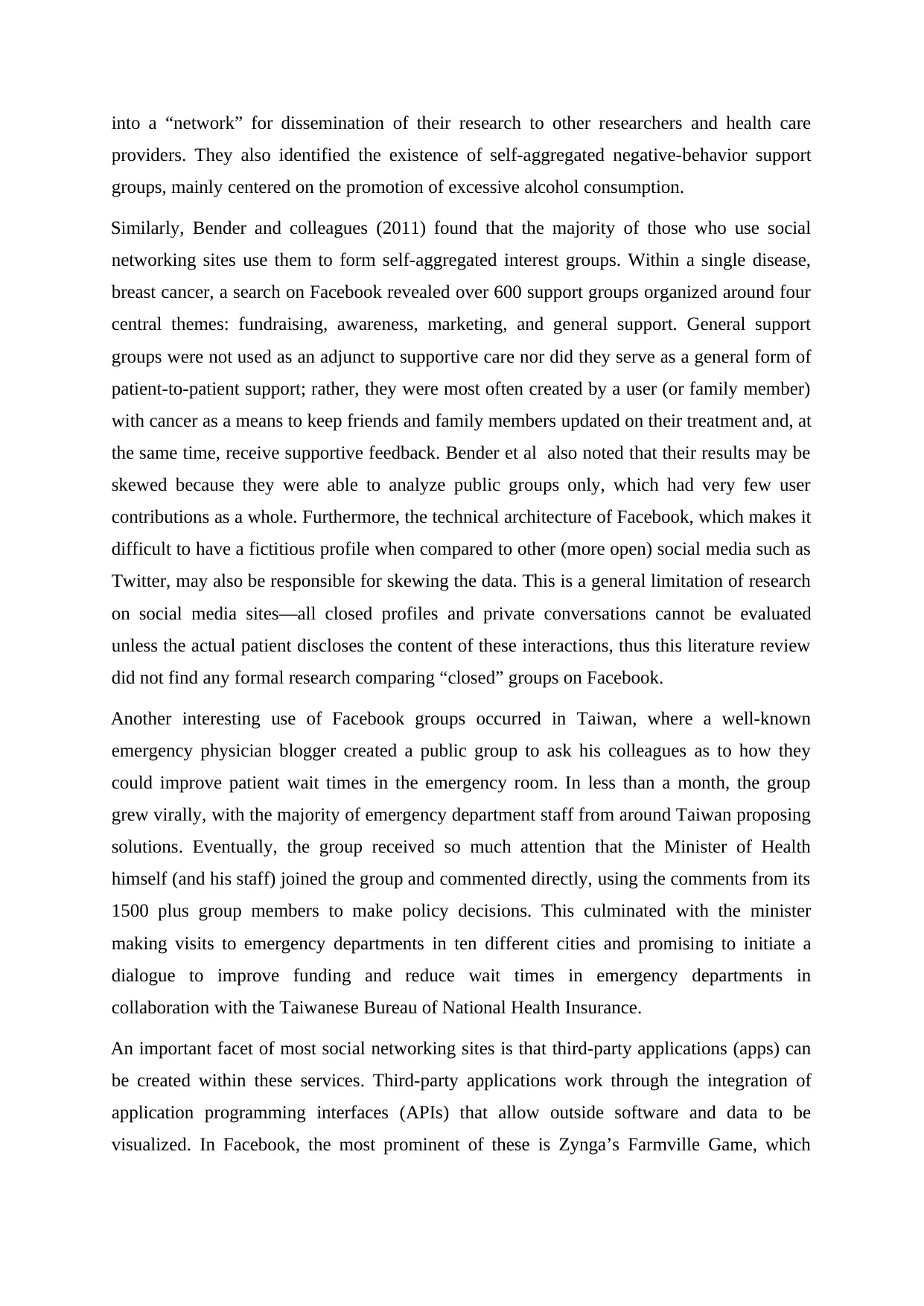
into a “network” for dissemination of their research to other researchers and health care
providers. They also identified the existence of self-aggregated negative-behavior support
groups, mainly centered on the promotion of excessive alcohol consumption.
Similarly, Bender and colleagues (2011) found that the majority of those who use social
networking sites use them to form self-aggregated interest groups. Within a single disease,
breast cancer, a search on Facebook revealed over 600 support groups organized around four
central themes: fundraising, awareness, marketing, and general support. General support
groups were not used as an adjunct to supportive care nor did they serve as a general form of
patient-to-patient support; rather, they were most often created by a user (or family member)
with cancer as a means to keep friends and family members updated on their treatment and, at
the same time, receive supportive feedback. Bender et al also noted that their results may be
skewed because they were able to analyze public groups only, which had very few user
contributions as a whole. Furthermore, the technical architecture of Facebook, which makes it
difficult to have a fictitious profile when compared to other (more open) social media such as
Twitter, may also be responsible for skewing the data. This is a general limitation of research
on social media sites—all closed profiles and private conversations cannot be evaluated
unless the actual patient discloses the content of these interactions, thus this literature review
did not find any formal research comparing “closed” groups on Facebook.
Another interesting use of Facebook groups occurred in Taiwan, where a well-known
emergency physician blogger created a public group to ask his colleagues as to how they
could improve patient wait times in the emergency room. In less than a month, the group
grew virally, with the majority of emergency department staff from around Taiwan proposing
solutions. Eventually, the group received so much attention that the Minister of Health
himself (and his staff) joined the group and commented directly, using the comments from its
1500 plus group members to make policy decisions. This culminated with the minister
making visits to emergency departments in ten different cities and promising to initiate a
dialogue to improve funding and reduce wait times in emergency departments in
collaboration with the Taiwanese Bureau of National Health Insurance.
An important facet of most social networking sites is that third-party applications (apps) can
be created within these services. Third-party applications work through the integration of
application programming interfaces (APIs) that allow outside software and data to be
visualized. In Facebook, the most prominent of these is Zynga’s Farmville Game, which
providers. They also identified the existence of self-aggregated negative-behavior support
groups, mainly centered on the promotion of excessive alcohol consumption.
Similarly, Bender and colleagues (2011) found that the majority of those who use social
networking sites use them to form self-aggregated interest groups. Within a single disease,
breast cancer, a search on Facebook revealed over 600 support groups organized around four
central themes: fundraising, awareness, marketing, and general support. General support
groups were not used as an adjunct to supportive care nor did they serve as a general form of
patient-to-patient support; rather, they were most often created by a user (or family member)
with cancer as a means to keep friends and family members updated on their treatment and, at
the same time, receive supportive feedback. Bender et al also noted that their results may be
skewed because they were able to analyze public groups only, which had very few user
contributions as a whole. Furthermore, the technical architecture of Facebook, which makes it
difficult to have a fictitious profile when compared to other (more open) social media such as
Twitter, may also be responsible for skewing the data. This is a general limitation of research
on social media sites—all closed profiles and private conversations cannot be evaluated
unless the actual patient discloses the content of these interactions, thus this literature review
did not find any formal research comparing “closed” groups on Facebook.
Another interesting use of Facebook groups occurred in Taiwan, where a well-known
emergency physician blogger created a public group to ask his colleagues as to how they
could improve patient wait times in the emergency room. In less than a month, the group
grew virally, with the majority of emergency department staff from around Taiwan proposing
solutions. Eventually, the group received so much attention that the Minister of Health
himself (and his staff) joined the group and commented directly, using the comments from its
1500 plus group members to make policy decisions. This culminated with the minister
making visits to emergency departments in ten different cities and promising to initiate a
dialogue to improve funding and reduce wait times in emergency departments in
collaboration with the Taiwanese Bureau of National Health Insurance.
An important facet of most social networking sites is that third-party applications (apps) can
be created within these services. Third-party applications work through the integration of
application programming interfaces (APIs) that allow outside software and data to be
visualized. In Facebook, the most prominent of these is Zynga’s Farmville Game, which
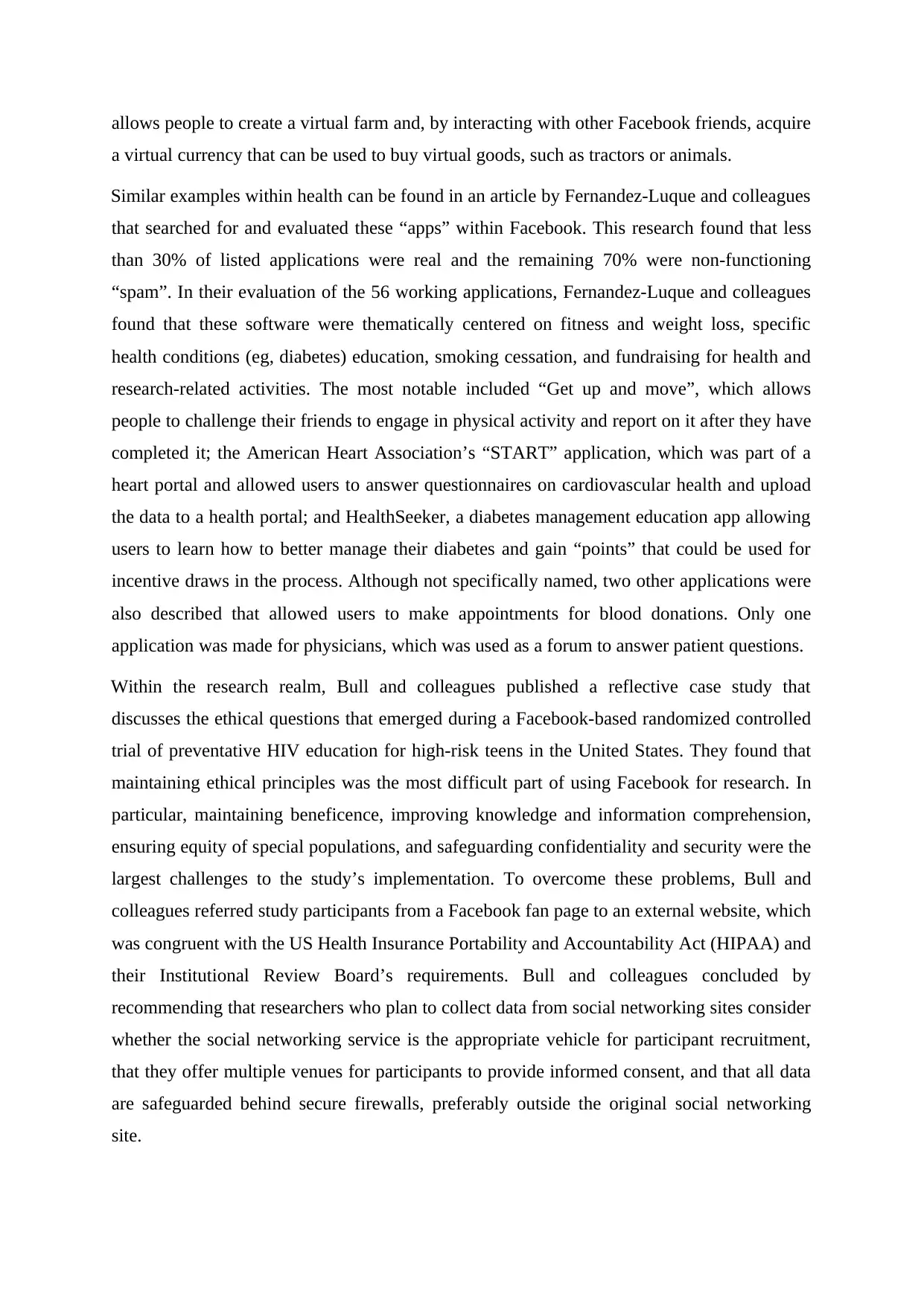
allows people to create a virtual farm and, by interacting with other Facebook friends, acquire
a virtual currency that can be used to buy virtual goods, such as tractors or animals.
Similar examples within health can be found in an article by Fernandez-Luque and colleagues
that searched for and evaluated these “apps” within Facebook. This research found that less
than 30% of listed applications were real and the remaining 70% were non-functioning
“spam”. In their evaluation of the 56 working applications, Fernandez-Luque and colleagues
found that these software were thematically centered on fitness and weight loss, specific
health conditions (eg, diabetes) education, smoking cessation, and fundraising for health and
research-related activities. The most notable included “Get up and move”, which allows
people to challenge their friends to engage in physical activity and report on it after they have
completed it; the American Heart Association’s “START” application, which was part of a
heart portal and allowed users to answer questionnaires on cardiovascular health and upload
the data to a health portal; and HealthSeeker, a diabetes management education app allowing
users to learn how to better manage their diabetes and gain “points” that could be used for
incentive draws in the process. Although not specifically named, two other applications were
also described that allowed users to make appointments for blood donations. Only one
application was made for physicians, which was used as a forum to answer patient questions.
Within the research realm, Bull and colleagues published a reflective case study that
discusses the ethical questions that emerged during a Facebook-based randomized controlled
trial of preventative HIV education for high-risk teens in the United States. They found that
maintaining ethical principles was the most difficult part of using Facebook for research. In
particular, maintaining beneficence, improving knowledge and information comprehension,
ensuring equity of special populations, and safeguarding confidentiality and security were the
largest challenges to the study’s implementation. To overcome these problems, Bull and
colleagues referred study participants from a Facebook fan page to an external website, which
was congruent with the US Health Insurance Portability and Accountability Act (HIPAA) and
their Institutional Review Board’s requirements. Bull and colleagues concluded by
recommending that researchers who plan to collect data from social networking sites consider
whether the social networking service is the appropriate vehicle for participant recruitment,
that they offer multiple venues for participants to provide informed consent, and that all data
are safeguarded behind secure firewalls, preferably outside the original social networking
site.
a virtual currency that can be used to buy virtual goods, such as tractors or animals.
Similar examples within health can be found in an article by Fernandez-Luque and colleagues
that searched for and evaluated these “apps” within Facebook. This research found that less
than 30% of listed applications were real and the remaining 70% were non-functioning
“spam”. In their evaluation of the 56 working applications, Fernandez-Luque and colleagues
found that these software were thematically centered on fitness and weight loss, specific
health conditions (eg, diabetes) education, smoking cessation, and fundraising for health and
research-related activities. The most notable included “Get up and move”, which allows
people to challenge their friends to engage in physical activity and report on it after they have
completed it; the American Heart Association’s “START” application, which was part of a
heart portal and allowed users to answer questionnaires on cardiovascular health and upload
the data to a health portal; and HealthSeeker, a diabetes management education app allowing
users to learn how to better manage their diabetes and gain “points” that could be used for
incentive draws in the process. Although not specifically named, two other applications were
also described that allowed users to make appointments for blood donations. Only one
application was made for physicians, which was used as a forum to answer patient questions.
Within the research realm, Bull and colleagues published a reflective case study that
discusses the ethical questions that emerged during a Facebook-based randomized controlled
trial of preventative HIV education for high-risk teens in the United States. They found that
maintaining ethical principles was the most difficult part of using Facebook for research. In
particular, maintaining beneficence, improving knowledge and information comprehension,
ensuring equity of special populations, and safeguarding confidentiality and security were the
largest challenges to the study’s implementation. To overcome these problems, Bull and
colleagues referred study participants from a Facebook fan page to an external website, which
was congruent with the US Health Insurance Portability and Accountability Act (HIPAA) and
their Institutional Review Board’s requirements. Bull and colleagues concluded by
recommending that researchers who plan to collect data from social networking sites consider
whether the social networking service is the appropriate vehicle for participant recruitment,
that they offer multiple venues for participants to provide informed consent, and that all data
are safeguarded behind secure firewalls, preferably outside the original social networking
site.
Secure Best Marks with AI Grader
Need help grading? Try our AI Grader for instant feedback on your assignments.

Professional and Thematic Networking Sites
Professional networking sites are aimed solely for interactions related to a person’s
professional career or business. LinkedIn is the most popular of such sites and does not solely
focus on medicine or health care; it allows people to publicly display a curriculum vita along
with personal and institutional affiliations. Unlike Facebook, which allows people to “friend”
each other, LinkedIn uses connections, which publicly show people that have worked
together or know each other. Should a person be new to the site, connections can also be used
to visualize the number of degrees of separation between 2 or more people.
A number of health care specific professional networking sites also exist, including Sermo,
Asklepios, Doctors’ Hangout, Ozmosis, Doc2Doc, and others, which try to recreate the
intimacy of the “physicians’lounge” in an online environment. These sites most often require
the clinician to submit their credentials to a site gatekeeper, thus creating the perception of an
elitist forum that is “safe” from patient’s eyes. Discussions in these sites typically range from
dating in a medical environment, ethics, clinical trial and medication reviews, biostatistics,
and specific treatment options. A combination of business models are also used by these sites,
which vary from financial sponsorship by a professional association (eg, Asklepios by the
Canadian Medical Association), advertisement, anonymized data vending to external
stakeholders (eg, insurance companies, pharmaceutical companies, etc), commission on
prizes offered by companies trying to solve a particular problem (eg, InnoCentive), and
research by external stakeholders (eg, surveys on physician medication prescription habits).
Thematic networking sites are analogous to professional networking sites but centered on a
particular theme. These include telemedicine (eg, Telehelp), informatics (eg, Health
Informatics Forum), nursing (eg, SocialRN), genomics (eg, 23andMe), and patients (eg,
PatientsLikeMe), among others. Of particular interest are patient thematic networking sites,
as a number of these sites collect, aggregate, and visualize patient data to promote patient-
driven research (research that was initiated by a patient and used to collaborate with other
patients with the same or a related disease) .
One site that promotes patient-driven research is Cure Together. It collects a number of health
metrics including weight, caloric intake, sleep, exercise, and other disease-specific indicators.
Although the site is not meant to constitute medical advice, it allows patients to summarize
statistics on treatment efficacy, side effects, and causes of disease, ultimately helping people
make more informed treatment decisions. For example, on its chronic fatigue syndrome page,
Cure Together has amalgamated responses from over 1300 patients, encompassing nearly
Professional networking sites are aimed solely for interactions related to a person’s
professional career or business. LinkedIn is the most popular of such sites and does not solely
focus on medicine or health care; it allows people to publicly display a curriculum vita along
with personal and institutional affiliations. Unlike Facebook, which allows people to “friend”
each other, LinkedIn uses connections, which publicly show people that have worked
together or know each other. Should a person be new to the site, connections can also be used
to visualize the number of degrees of separation between 2 or more people.
A number of health care specific professional networking sites also exist, including Sermo,
Asklepios, Doctors’ Hangout, Ozmosis, Doc2Doc, and others, which try to recreate the
intimacy of the “physicians’lounge” in an online environment. These sites most often require
the clinician to submit their credentials to a site gatekeeper, thus creating the perception of an
elitist forum that is “safe” from patient’s eyes. Discussions in these sites typically range from
dating in a medical environment, ethics, clinical trial and medication reviews, biostatistics,
and specific treatment options. A combination of business models are also used by these sites,
which vary from financial sponsorship by a professional association (eg, Asklepios by the
Canadian Medical Association), advertisement, anonymized data vending to external
stakeholders (eg, insurance companies, pharmaceutical companies, etc), commission on
prizes offered by companies trying to solve a particular problem (eg, InnoCentive), and
research by external stakeholders (eg, surveys on physician medication prescription habits).
Thematic networking sites are analogous to professional networking sites but centered on a
particular theme. These include telemedicine (eg, Telehelp), informatics (eg, Health
Informatics Forum), nursing (eg, SocialRN), genomics (eg, 23andMe), and patients (eg,
PatientsLikeMe), among others. Of particular interest are patient thematic networking sites,
as a number of these sites collect, aggregate, and visualize patient data to promote patient-
driven research (research that was initiated by a patient and used to collaborate with other
patients with the same or a related disease) .
One site that promotes patient-driven research is Cure Together. It collects a number of health
metrics including weight, caloric intake, sleep, exercise, and other disease-specific indicators.
Although the site is not meant to constitute medical advice, it allows patients to summarize
statistics on treatment efficacy, side effects, and causes of disease, ultimately helping people
make more informed treatment decisions. For example, on its chronic fatigue syndrome page,
Cure Together has amalgamated responses from over 1300 patients, encompassing nearly
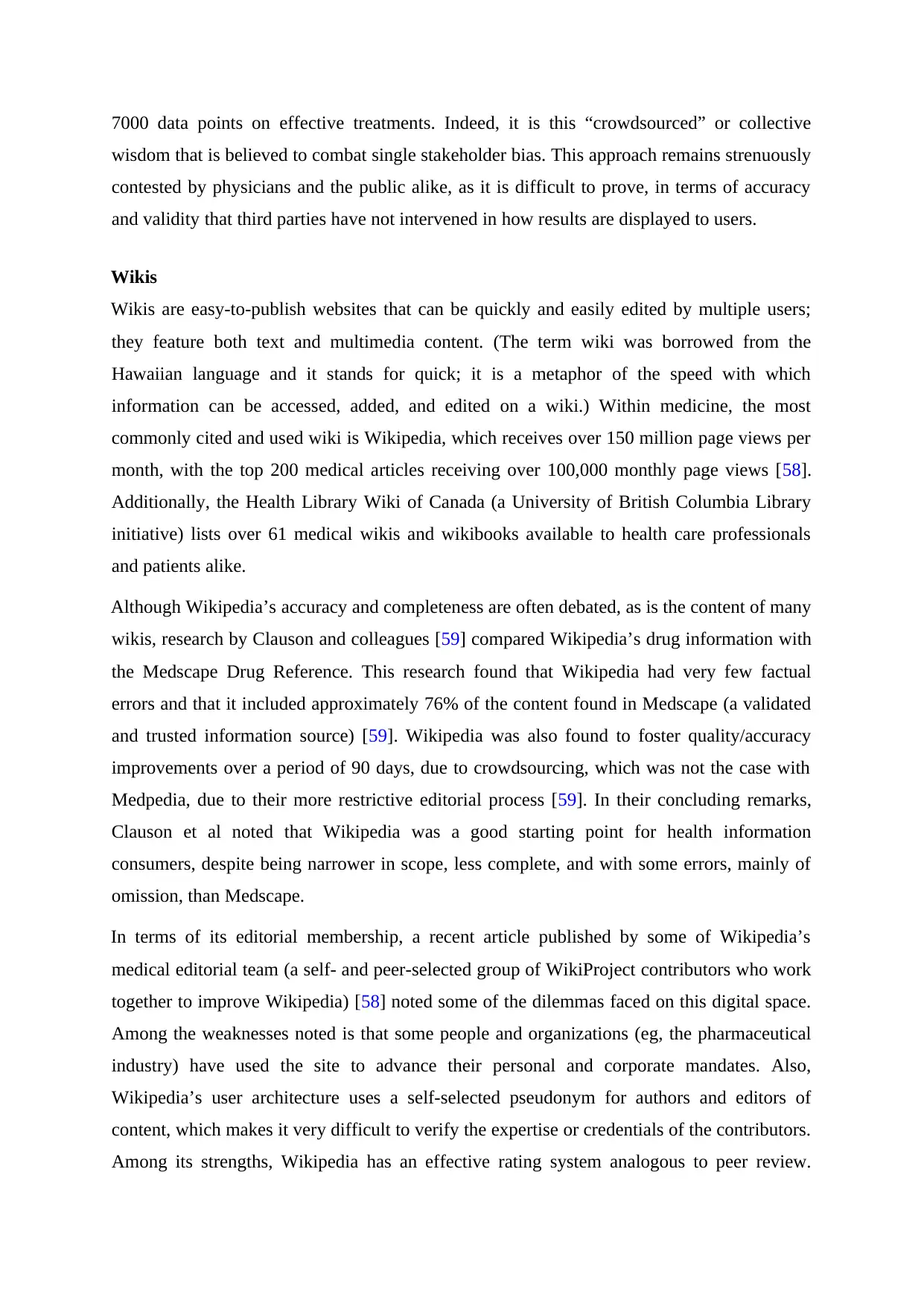
7000 data points on effective treatments. Indeed, it is this “crowdsourced” or collective
wisdom that is believed to combat single stakeholder bias. This approach remains strenuously
contested by physicians and the public alike, as it is difficult to prove, in terms of accuracy
and validity that third parties have not intervened in how results are displayed to users.
Wikis
Wikis are easy-to-publish websites that can be quickly and easily edited by multiple users;
they feature both text and multimedia content. (The term wiki was borrowed from the
Hawaiian language and it stands for quick; it is a metaphor of the speed with which
information can be accessed, added, and edited on a wiki.) Within medicine, the most
commonly cited and used wiki is Wikipedia, which receives over 150 million page views per
month, with the top 200 medical articles receiving over 100,000 monthly page views [58].
Additionally, the Health Library Wiki of Canada (a University of British Columbia Library
initiative) lists over 61 medical wikis and wikibooks available to health care professionals
and patients alike.
Although Wikipedia’s accuracy and completeness are often debated, as is the content of many
wikis, research by Clauson and colleagues [59] compared Wikipedia’s drug information with
the Medscape Drug Reference. This research found that Wikipedia had very few factual
errors and that it included approximately 76% of the content found in Medscape (a validated
and trusted information source) [59]. Wikipedia was also found to foster quality/accuracy
improvements over a period of 90 days, due to crowdsourcing, which was not the case with
Medpedia, due to their more restrictive editorial process [59]. In their concluding remarks,
Clauson et al noted that Wikipedia was a good starting point for health information
consumers, despite being narrower in scope, less complete, and with some errors, mainly of
omission, than Medscape.
In terms of its editorial membership, a recent article published by some of Wikipedia’s
medical editorial team (a self- and peer-selected group of WikiProject contributors who work
together to improve Wikipedia) [58] noted some of the dilemmas faced on this digital space.
Among the weaknesses noted is that some people and organizations (eg, the pharmaceutical
industry) have used the site to advance their personal and corporate mandates. Also,
Wikipedia’s user architecture uses a self-selected pseudonym for authors and editors of
content, which makes it very difficult to verify the expertise or credentials of the contributors.
Among its strengths, Wikipedia has an effective rating system analogous to peer review.
wisdom that is believed to combat single stakeholder bias. This approach remains strenuously
contested by physicians and the public alike, as it is difficult to prove, in terms of accuracy
and validity that third parties have not intervened in how results are displayed to users.
Wikis
Wikis are easy-to-publish websites that can be quickly and easily edited by multiple users;
they feature both text and multimedia content. (The term wiki was borrowed from the
Hawaiian language and it stands for quick; it is a metaphor of the speed with which
information can be accessed, added, and edited on a wiki.) Within medicine, the most
commonly cited and used wiki is Wikipedia, which receives over 150 million page views per
month, with the top 200 medical articles receiving over 100,000 monthly page views [58].
Additionally, the Health Library Wiki of Canada (a University of British Columbia Library
initiative) lists over 61 medical wikis and wikibooks available to health care professionals
and patients alike.
Although Wikipedia’s accuracy and completeness are often debated, as is the content of many
wikis, research by Clauson and colleagues [59] compared Wikipedia’s drug information with
the Medscape Drug Reference. This research found that Wikipedia had very few factual
errors and that it included approximately 76% of the content found in Medscape (a validated
and trusted information source) [59]. Wikipedia was also found to foster quality/accuracy
improvements over a period of 90 days, due to crowdsourcing, which was not the case with
Medpedia, due to their more restrictive editorial process [59]. In their concluding remarks,
Clauson et al noted that Wikipedia was a good starting point for health information
consumers, despite being narrower in scope, less complete, and with some errors, mainly of
omission, than Medscape.
In terms of its editorial membership, a recent article published by some of Wikipedia’s
medical editorial team (a self- and peer-selected group of WikiProject contributors who work
together to improve Wikipedia) [58] noted some of the dilemmas faced on this digital space.
Among the weaknesses noted is that some people and organizations (eg, the pharmaceutical
industry) have used the site to advance their personal and corporate mandates. Also,
Wikipedia’s user architecture uses a self-selected pseudonym for authors and editors of
content, which makes it very difficult to verify the expertise or credentials of the contributors.
Among its strengths, Wikipedia has an effective rating system analogous to peer review.
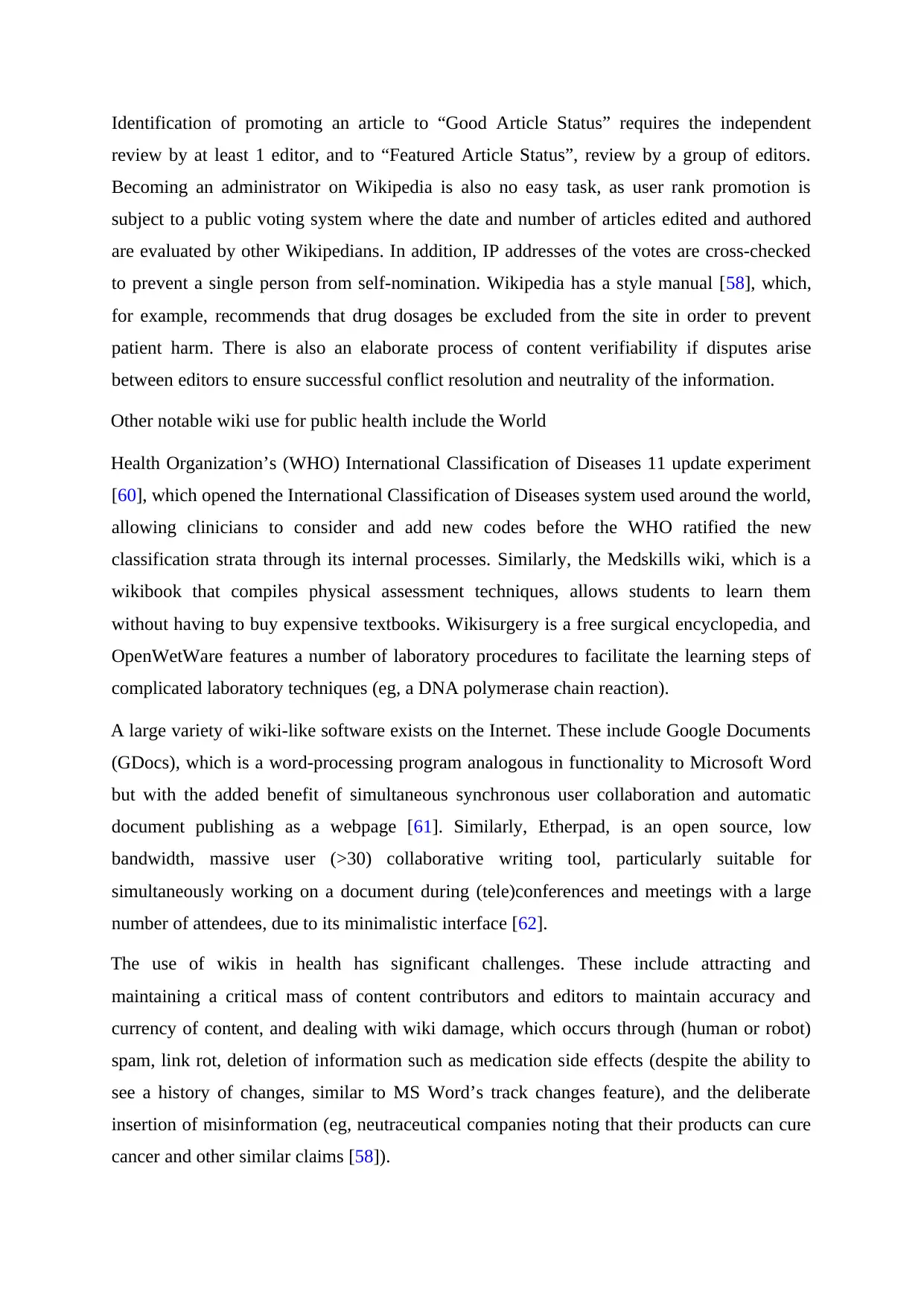
Identification of promoting an article to “Good Article Status” requires the independent
review by at least 1 editor, and to “Featured Article Status”, review by a group of editors.
Becoming an administrator on Wikipedia is also no easy task, as user rank promotion is
subject to a public voting system where the date and number of articles edited and authored
are evaluated by other Wikipedians. In addition, IP addresses of the votes are cross-checked
to prevent a single person from self-nomination. Wikipedia has a style manual [58], which,
for example, recommends that drug dosages be excluded from the site in order to prevent
patient harm. There is also an elaborate process of content verifiability if disputes arise
between editors to ensure successful conflict resolution and neutrality of the information.
Other notable wiki use for public health include the World
Health Organization’s (WHO) International Classification of Diseases 11 update experiment
[60], which opened the International Classification of Diseases system used around the world,
allowing clinicians to consider and add new codes before the WHO ratified the new
classification strata through its internal processes. Similarly, the Medskills wiki, which is a
wikibook that compiles physical assessment techniques, allows students to learn them
without having to buy expensive textbooks. Wikisurgery is a free surgical encyclopedia, and
OpenWetWare features a number of laboratory procedures to facilitate the learning steps of
complicated laboratory techniques (eg, a DNA polymerase chain reaction).
A large variety of wiki-like software exists on the Internet. These include Google Documents
(GDocs), which is a word-processing program analogous in functionality to Microsoft Word
but with the added benefit of simultaneous synchronous user collaboration and automatic
document publishing as a webpage [61]. Similarly, Etherpad, is an open source, low
bandwidth, massive user (>30) collaborative writing tool, particularly suitable for
simultaneously working on a document during (tele)conferences and meetings with a large
number of attendees, due to its minimalistic interface [62].
The use of wikis in health has significant challenges. These include attracting and
maintaining a critical mass of content contributors and editors to maintain accuracy and
currency of content, and dealing with wiki damage, which occurs through (human or robot)
spam, link rot, deletion of information such as medication side effects (despite the ability to
see a history of changes, similar to MS Word’s track changes feature), and the deliberate
insertion of misinformation (eg, neutraceutical companies noting that their products can cure
cancer and other similar claims [58]).
review by at least 1 editor, and to “Featured Article Status”, review by a group of editors.
Becoming an administrator on Wikipedia is also no easy task, as user rank promotion is
subject to a public voting system where the date and number of articles edited and authored
are evaluated by other Wikipedians. In addition, IP addresses of the votes are cross-checked
to prevent a single person from self-nomination. Wikipedia has a style manual [58], which,
for example, recommends that drug dosages be excluded from the site in order to prevent
patient harm. There is also an elaborate process of content verifiability if disputes arise
between editors to ensure successful conflict resolution and neutrality of the information.
Other notable wiki use for public health include the World
Health Organization’s (WHO) International Classification of Diseases 11 update experiment
[60], which opened the International Classification of Diseases system used around the world,
allowing clinicians to consider and add new codes before the WHO ratified the new
classification strata through its internal processes. Similarly, the Medskills wiki, which is a
wikibook that compiles physical assessment techniques, allows students to learn them
without having to buy expensive textbooks. Wikisurgery is a free surgical encyclopedia, and
OpenWetWare features a number of laboratory procedures to facilitate the learning steps of
complicated laboratory techniques (eg, a DNA polymerase chain reaction).
A large variety of wiki-like software exists on the Internet. These include Google Documents
(GDocs), which is a word-processing program analogous in functionality to Microsoft Word
but with the added benefit of simultaneous synchronous user collaboration and automatic
document publishing as a webpage [61]. Similarly, Etherpad, is an open source, low
bandwidth, massive user (>30) collaborative writing tool, particularly suitable for
simultaneously working on a document during (tele)conferences and meetings with a large
number of attendees, due to its minimalistic interface [62].
The use of wikis in health has significant challenges. These include attracting and
maintaining a critical mass of content contributors and editors to maintain accuracy and
currency of content, and dealing with wiki damage, which occurs through (human or robot)
spam, link rot, deletion of information such as medication side effects (despite the ability to
see a history of changes, similar to MS Word’s track changes feature), and the deliberate
insertion of misinformation (eg, neutraceutical companies noting that their products can cure
cancer and other similar claims [58]).
Paraphrase This Document
Need a fresh take? Get an instant paraphrase of this document with our AI Paraphraser
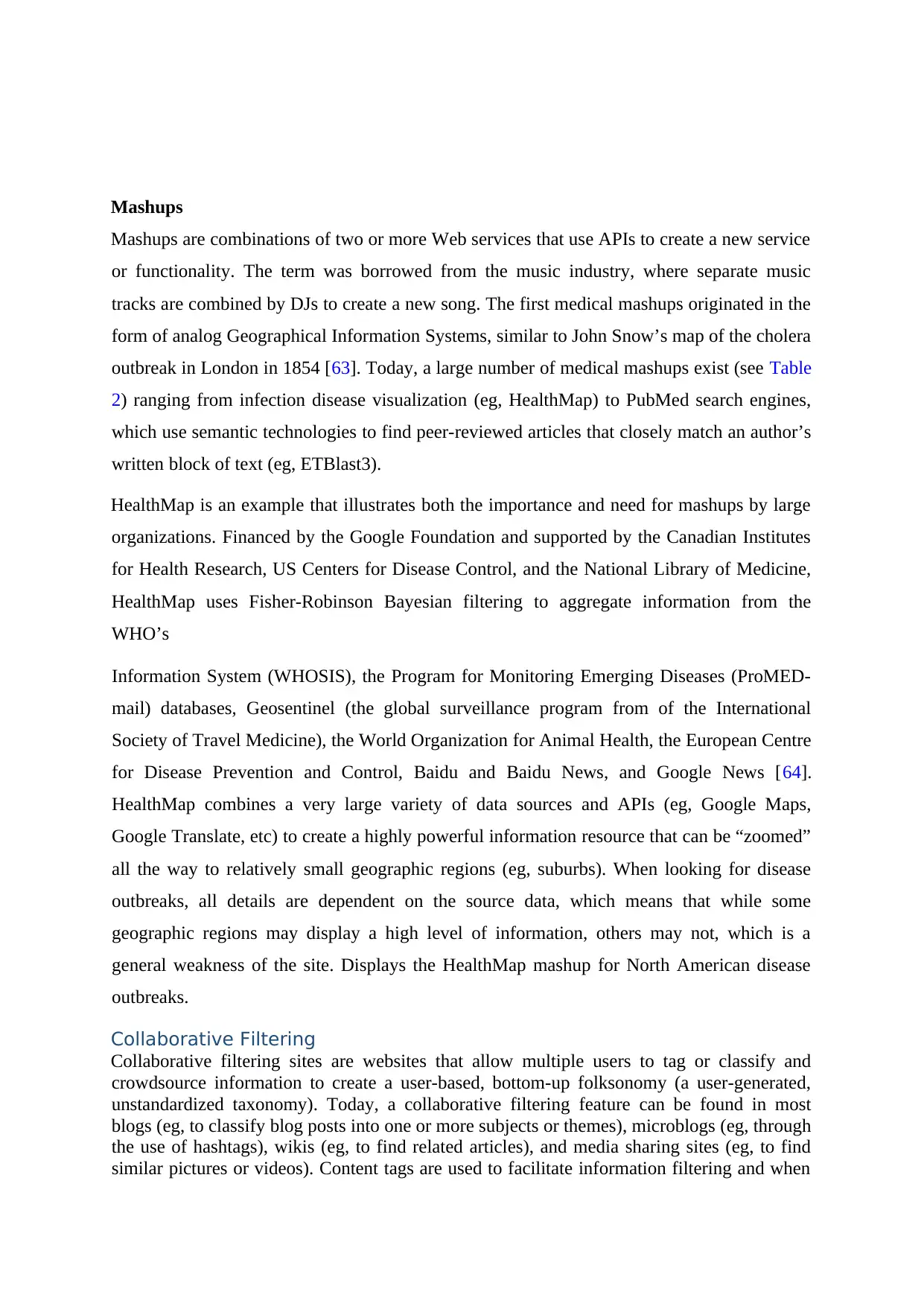
Mashups
Mashups are combinations of two or more Web services that use APIs to create a new service
or functionality. The term was borrowed from the music industry, where separate music
tracks are combined by DJs to create a new song. The first medical mashups originated in the
form of analog Geographical Information Systems, similar to John Snow’s map of the cholera
outbreak in London in 1854 [63]. Today, a large number of medical mashups exist (see Table
2) ranging from infection disease visualization (eg, HealthMap) to PubMed search engines,
which use semantic technologies to find peer-reviewed articles that closely match an author’s
written block of text (eg, ETBlast3).
HealthMap is an example that illustrates both the importance and need for mashups by large
organizations. Financed by the Google Foundation and supported by the Canadian Institutes
for Health Research, US Centers for Disease Control, and the National Library of Medicine,
HealthMap uses Fisher-Robinson Bayesian filtering to aggregate information from the
WHO’s
Information System (WHOSIS), the Program for Monitoring Emerging Diseases (ProMED-
mail) databases, Geosentinel (the global surveillance program from of the International
Society of Travel Medicine), the World Organization for Animal Health, the European Centre
for Disease Prevention and Control, Baidu and Baidu News, and Google News [64].
HealthMap combines a very large variety of data sources and APIs (eg, Google Maps,
Google Translate, etc) to create a highly powerful information resource that can be “zoomed”
all the way to relatively small geographic regions (eg, suburbs). When looking for disease
outbreaks, all details are dependent on the source data, which means that while some
geographic regions may display a high level of information, others may not, which is a
general weakness of the site. Displays the HealthMap mashup for North American disease
outbreaks.
Collaborative Filtering
Collaborative filtering sites are websites that allow multiple users to tag or classify and
crowdsource information to create a user-based, bottom-up folksonomy (a user-generated,
unstandardized taxonomy). Today, a collaborative filtering feature can be found in most
blogs (eg, to classify blog posts into one or more subjects or themes), microblogs (eg, through
the use of hashtags), wikis (eg, to find related articles), and media sharing sites (eg, to find
similar pictures or videos). Content tags are used to facilitate information filtering and when
Mashups are combinations of two or more Web services that use APIs to create a new service
or functionality. The term was borrowed from the music industry, where separate music
tracks are combined by DJs to create a new song. The first medical mashups originated in the
form of analog Geographical Information Systems, similar to John Snow’s map of the cholera
outbreak in London in 1854 [63]. Today, a large number of medical mashups exist (see Table
2) ranging from infection disease visualization (eg, HealthMap) to PubMed search engines,
which use semantic technologies to find peer-reviewed articles that closely match an author’s
written block of text (eg, ETBlast3).
HealthMap is an example that illustrates both the importance and need for mashups by large
organizations. Financed by the Google Foundation and supported by the Canadian Institutes
for Health Research, US Centers for Disease Control, and the National Library of Medicine,
HealthMap uses Fisher-Robinson Bayesian filtering to aggregate information from the
WHO’s
Information System (WHOSIS), the Program for Monitoring Emerging Diseases (ProMED-
mail) databases, Geosentinel (the global surveillance program from of the International
Society of Travel Medicine), the World Organization for Animal Health, the European Centre
for Disease Prevention and Control, Baidu and Baidu News, and Google News [64].
HealthMap combines a very large variety of data sources and APIs (eg, Google Maps,
Google Translate, etc) to create a highly powerful information resource that can be “zoomed”
all the way to relatively small geographic regions (eg, suburbs). When looking for disease
outbreaks, all details are dependent on the source data, which means that while some
geographic regions may display a high level of information, others may not, which is a
general weakness of the site. Displays the HealthMap mashup for North American disease
outbreaks.
Collaborative Filtering
Collaborative filtering sites are websites that allow multiple users to tag or classify and
crowdsource information to create a user-based, bottom-up folksonomy (a user-generated,
unstandardized taxonomy). Today, a collaborative filtering feature can be found in most
blogs (eg, to classify blog posts into one or more subjects or themes), microblogs (eg, through
the use of hashtags), wikis (eg, to find related articles), and media sharing sites (eg, to find
similar pictures or videos). Content tags are used to facilitate information filtering and when
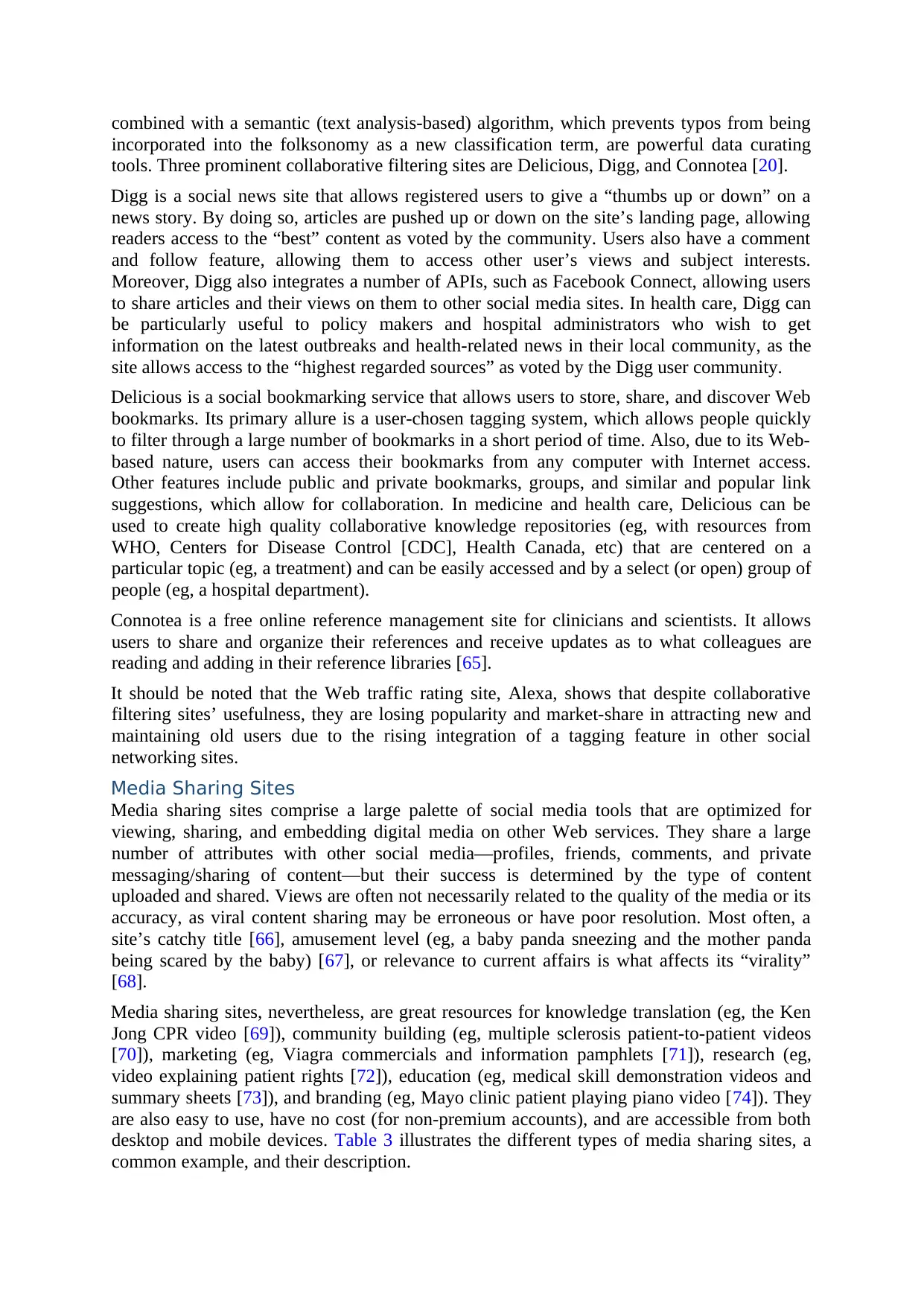
combined with a semantic (text analysis-based) algorithm, which prevents typos from being
incorporated into the folksonomy as a new classification term, are powerful data curating
tools. Three prominent collaborative filtering sites are Delicious, Digg, and Connotea [20].
Digg is a social news site that allows registered users to give a “thumbs up or down” on a
news story. By doing so, articles are pushed up or down on the site’s landing page, allowing
readers access to the “best” content as voted by the community. Users also have a comment
and follow feature, allowing them to access other user’s views and subject interests.
Moreover, Digg also integrates a number of APIs, such as Facebook Connect, allowing users
to share articles and their views on them to other social media sites. In health care, Digg can
be particularly useful to policy makers and hospital administrators who wish to get
information on the latest outbreaks and health-related news in their local community, as the
site allows access to the “highest regarded sources” as voted by the Digg user community.
Delicious is a social bookmarking service that allows users to store, share, and discover Web
bookmarks. Its primary allure is a user-chosen tagging system, which allows people quickly
to filter through a large number of bookmarks in a short period of time. Also, due to its Web-
based nature, users can access their bookmarks from any computer with Internet access.
Other features include public and private bookmarks, groups, and similar and popular link
suggestions, which allow for collaboration. In medicine and health care, Delicious can be
used to create high quality collaborative knowledge repositories (eg, with resources from
WHO, Centers for Disease Control [CDC], Health Canada, etc) that are centered on a
particular topic (eg, a treatment) and can be easily accessed and by a select (or open) group of
people (eg, a hospital department).
Connotea is a free online reference management site for clinicians and scientists. It allows
users to share and organize their references and receive updates as to what colleagues are
reading and adding in their reference libraries [65].
It should be noted that the Web traffic rating site, Alexa, shows that despite collaborative
filtering sites’ usefulness, they are losing popularity and market-share in attracting new and
maintaining old users due to the rising integration of a tagging feature in other social
networking sites.
Media Sharing Sites
Media sharing sites comprise a large palette of social media tools that are optimized for
viewing, sharing, and embedding digital media on other Web services. They share a large
number of attributes with other social media—profiles, friends, comments, and private
messaging/sharing of content—but their success is determined by the type of content
uploaded and shared. Views are often not necessarily related to the quality of the media or its
accuracy, as viral content sharing may be erroneous or have poor resolution. Most often, a
site’s catchy title [66], amusement level (eg, a baby panda sneezing and the mother panda
being scared by the baby) [67], or relevance to current affairs is what affects its “virality”
[68].
Media sharing sites, nevertheless, are great resources for knowledge translation (eg, the Ken
Jong CPR video [69]), community building (eg, multiple sclerosis patient-to-patient videos
[70]), marketing (eg, Viagra commercials and information pamphlets [71]), research (eg,
video explaining patient rights [72]), education (eg, medical skill demonstration videos and
summary sheets [73]), and branding (eg, Mayo clinic patient playing piano video [74]). They
are also easy to use, have no cost (for non-premium accounts), and are accessible from both
desktop and mobile devices. Table 3 illustrates the different types of media sharing sites, a
common example, and their description.
incorporated into the folksonomy as a new classification term, are powerful data curating
tools. Three prominent collaborative filtering sites are Delicious, Digg, and Connotea [20].
Digg is a social news site that allows registered users to give a “thumbs up or down” on a
news story. By doing so, articles are pushed up or down on the site’s landing page, allowing
readers access to the “best” content as voted by the community. Users also have a comment
and follow feature, allowing them to access other user’s views and subject interests.
Moreover, Digg also integrates a number of APIs, such as Facebook Connect, allowing users
to share articles and their views on them to other social media sites. In health care, Digg can
be particularly useful to policy makers and hospital administrators who wish to get
information on the latest outbreaks and health-related news in their local community, as the
site allows access to the “highest regarded sources” as voted by the Digg user community.
Delicious is a social bookmarking service that allows users to store, share, and discover Web
bookmarks. Its primary allure is a user-chosen tagging system, which allows people quickly
to filter through a large number of bookmarks in a short period of time. Also, due to its Web-
based nature, users can access their bookmarks from any computer with Internet access.
Other features include public and private bookmarks, groups, and similar and popular link
suggestions, which allow for collaboration. In medicine and health care, Delicious can be
used to create high quality collaborative knowledge repositories (eg, with resources from
WHO, Centers for Disease Control [CDC], Health Canada, etc) that are centered on a
particular topic (eg, a treatment) and can be easily accessed and by a select (or open) group of
people (eg, a hospital department).
Connotea is a free online reference management site for clinicians and scientists. It allows
users to share and organize their references and receive updates as to what colleagues are
reading and adding in their reference libraries [65].
It should be noted that the Web traffic rating site, Alexa, shows that despite collaborative
filtering sites’ usefulness, they are losing popularity and market-share in attracting new and
maintaining old users due to the rising integration of a tagging feature in other social
networking sites.
Media Sharing Sites
Media sharing sites comprise a large palette of social media tools that are optimized for
viewing, sharing, and embedding digital media on other Web services. They share a large
number of attributes with other social media—profiles, friends, comments, and private
messaging/sharing of content—but their success is determined by the type of content
uploaded and shared. Views are often not necessarily related to the quality of the media or its
accuracy, as viral content sharing may be erroneous or have poor resolution. Most often, a
site’s catchy title [66], amusement level (eg, a baby panda sneezing and the mother panda
being scared by the baby) [67], or relevance to current affairs is what affects its “virality”
[68].
Media sharing sites, nevertheless, are great resources for knowledge translation (eg, the Ken
Jong CPR video [69]), community building (eg, multiple sclerosis patient-to-patient videos
[70]), marketing (eg, Viagra commercials and information pamphlets [71]), research (eg,
video explaining patient rights [72]), education (eg, medical skill demonstration videos and
summary sheets [73]), and branding (eg, Mayo clinic patient playing piano video [74]). They
are also easy to use, have no cost (for non-premium accounts), and are accessible from both
desktop and mobile devices. Table 3 illustrates the different types of media sharing sites, a
common example, and their description.
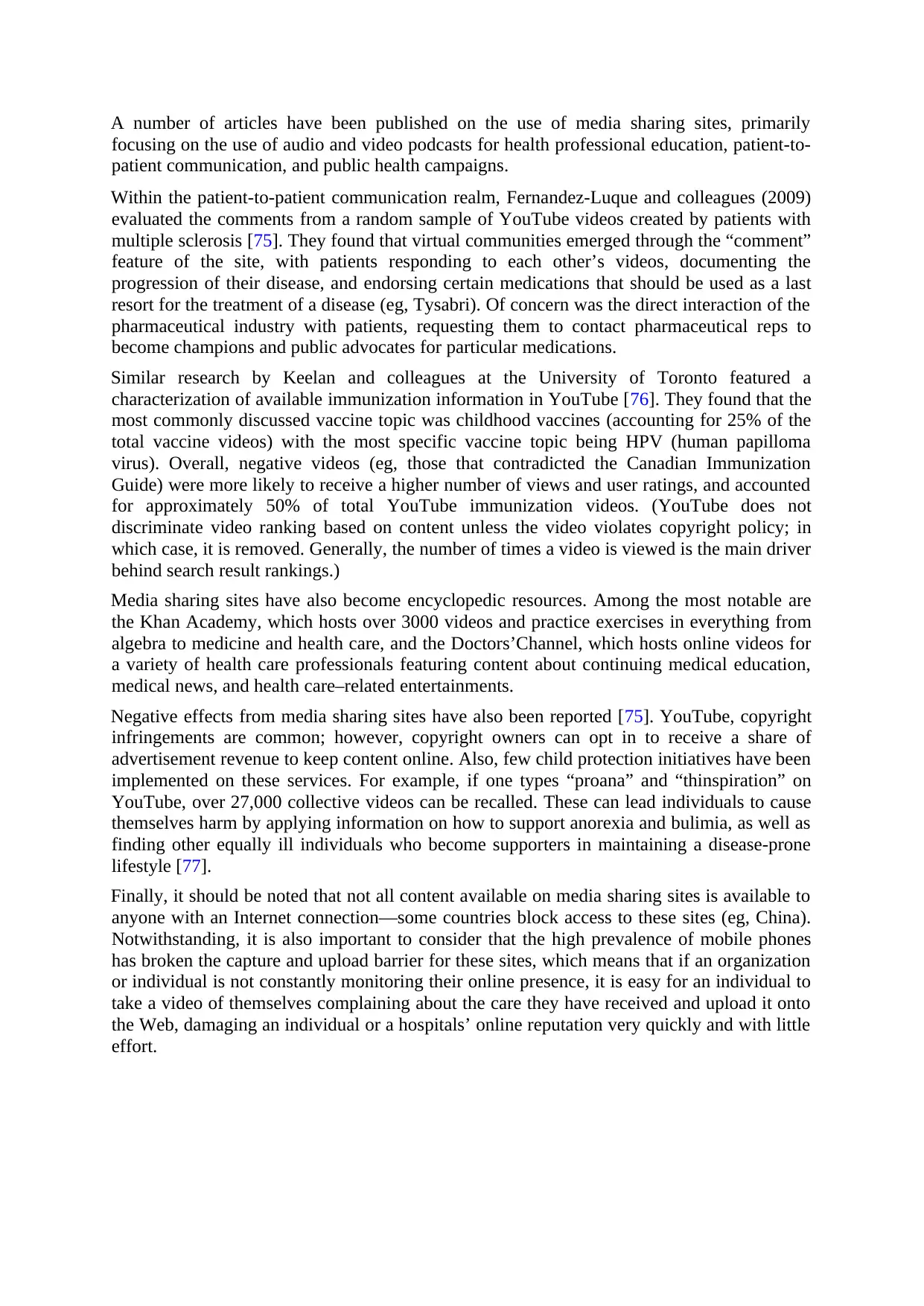
A number of articles have been published on the use of media sharing sites, primarily
focusing on the use of audio and video podcasts for health professional education, patient-to-
patient communication, and public health campaigns.
Within the patient-to-patient communication realm, Fernandez-Luque and colleagues (2009)
evaluated the comments from a random sample of YouTube videos created by patients with
multiple sclerosis [75]. They found that virtual communities emerged through the “comment”
feature of the site, with patients responding to each other’s videos, documenting the
progression of their disease, and endorsing certain medications that should be used as a last
resort for the treatment of a disease (eg, Tysabri). Of concern was the direct interaction of the
pharmaceutical industry with patients, requesting them to contact pharmaceutical reps to
become champions and public advocates for particular medications.
Similar research by Keelan and colleagues at the University of Toronto featured a
characterization of available immunization information in YouTube [76]. They found that the
most commonly discussed vaccine topic was childhood vaccines (accounting for 25% of the
total vaccine videos) with the most specific vaccine topic being HPV (human papilloma
virus). Overall, negative videos (eg, those that contradicted the Canadian Immunization
Guide) were more likely to receive a higher number of views and user ratings, and accounted
for approximately 50% of total YouTube immunization videos. (YouTube does not
discriminate video ranking based on content unless the video violates copyright policy; in
which case, it is removed. Generally, the number of times a video is viewed is the main driver
behind search result rankings.)
Media sharing sites have also become encyclopedic resources. Among the most notable are
the Khan Academy, which hosts over 3000 videos and practice exercises in everything from
algebra to medicine and health care, and the Doctors’Channel, which hosts online videos for
a variety of health care professionals featuring content about continuing medical education,
medical news, and health care–related entertainments.
Negative effects from media sharing sites have also been reported [75]. YouTube, copyright
infringements are common; however, copyright owners can opt in to receive a share of
advertisement revenue to keep content online. Also, few child protection initiatives have been
implemented on these services. For example, if one types “proana” and “thinspiration” on
YouTube, over 27,000 collective videos can be recalled. These can lead individuals to cause
themselves harm by applying information on how to support anorexia and bulimia, as well as
finding other equally ill individuals who become supporters in maintaining a disease-prone
lifestyle [77].
Finally, it should be noted that not all content available on media sharing sites is available to
anyone with an Internet connection—some countries block access to these sites (eg, China).
Notwithstanding, it is also important to consider that the high prevalence of mobile phones
has broken the capture and upload barrier for these sites, which means that if an organization
or individual is not constantly monitoring their online presence, it is easy for an individual to
take a video of themselves complaining about the care they have received and upload it onto
the Web, damaging an individual or a hospitals’ online reputation very quickly and with little
effort.
focusing on the use of audio and video podcasts for health professional education, patient-to-
patient communication, and public health campaigns.
Within the patient-to-patient communication realm, Fernandez-Luque and colleagues (2009)
evaluated the comments from a random sample of YouTube videos created by patients with
multiple sclerosis [75]. They found that virtual communities emerged through the “comment”
feature of the site, with patients responding to each other’s videos, documenting the
progression of their disease, and endorsing certain medications that should be used as a last
resort for the treatment of a disease (eg, Tysabri). Of concern was the direct interaction of the
pharmaceutical industry with patients, requesting them to contact pharmaceutical reps to
become champions and public advocates for particular medications.
Similar research by Keelan and colleagues at the University of Toronto featured a
characterization of available immunization information in YouTube [76]. They found that the
most commonly discussed vaccine topic was childhood vaccines (accounting for 25% of the
total vaccine videos) with the most specific vaccine topic being HPV (human papilloma
virus). Overall, negative videos (eg, those that contradicted the Canadian Immunization
Guide) were more likely to receive a higher number of views and user ratings, and accounted
for approximately 50% of total YouTube immunization videos. (YouTube does not
discriminate video ranking based on content unless the video violates copyright policy; in
which case, it is removed. Generally, the number of times a video is viewed is the main driver
behind search result rankings.)
Media sharing sites have also become encyclopedic resources. Among the most notable are
the Khan Academy, which hosts over 3000 videos and practice exercises in everything from
algebra to medicine and health care, and the Doctors’Channel, which hosts online videos for
a variety of health care professionals featuring content about continuing medical education,
medical news, and health care–related entertainments.
Negative effects from media sharing sites have also been reported [75]. YouTube, copyright
infringements are common; however, copyright owners can opt in to receive a share of
advertisement revenue to keep content online. Also, few child protection initiatives have been
implemented on these services. For example, if one types “proana” and “thinspiration” on
YouTube, over 27,000 collective videos can be recalled. These can lead individuals to cause
themselves harm by applying information on how to support anorexia and bulimia, as well as
finding other equally ill individuals who become supporters in maintaining a disease-prone
lifestyle [77].
Finally, it should be noted that not all content available on media sharing sites is available to
anyone with an Internet connection—some countries block access to these sites (eg, China).
Notwithstanding, it is also important to consider that the high prevalence of mobile phones
has broken the capture and upload barrier for these sites, which means that if an organization
or individual is not constantly monitoring their online presence, it is easy for an individual to
take a video of themselves complaining about the care they have received and upload it onto
the Web, damaging an individual or a hospitals’ online reputation very quickly and with little
effort.
Secure Best Marks with AI Grader
Need help grading? Try our AI Grader for instant feedback on your assignments.
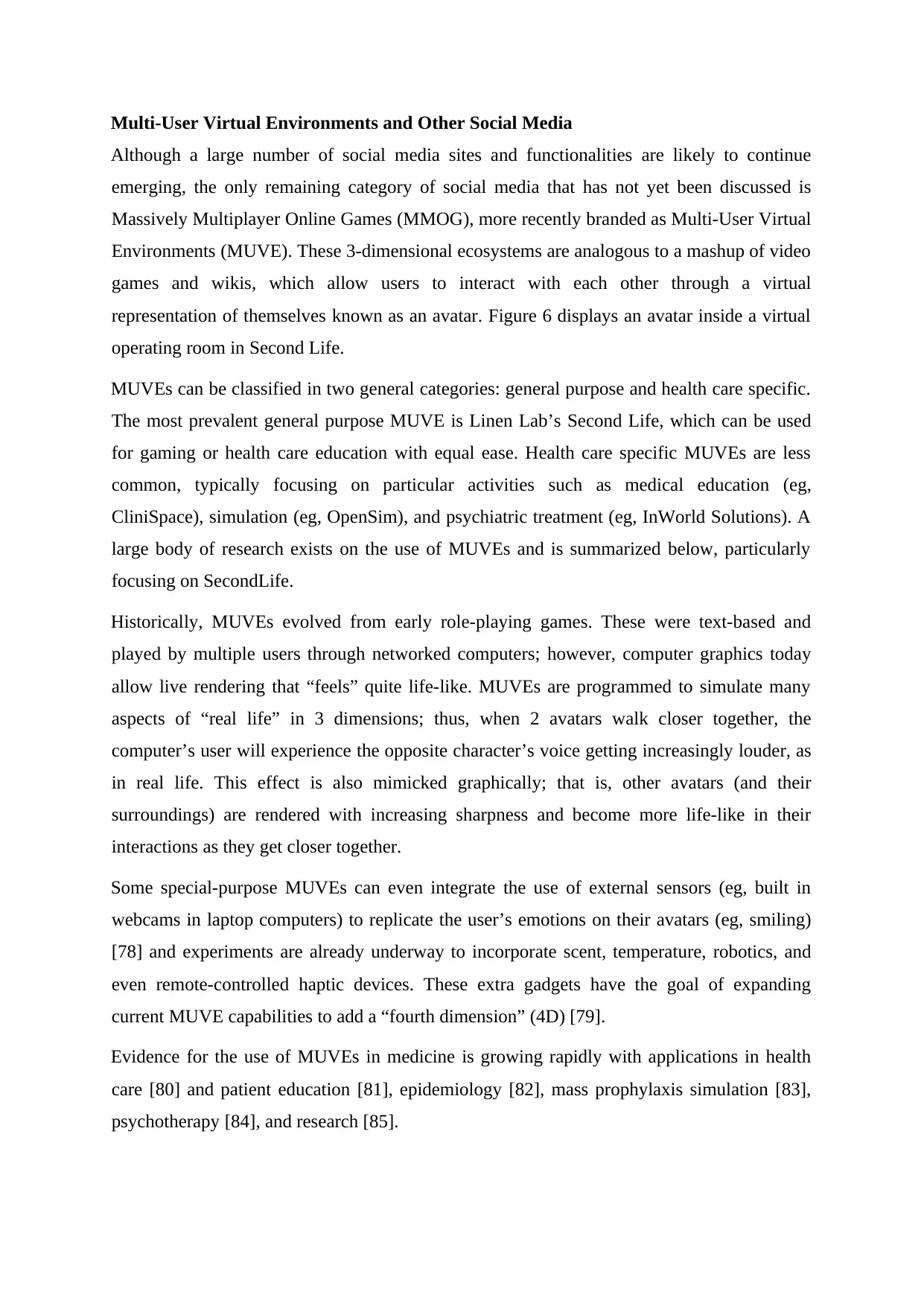
Multi-User Virtual Environments and Other Social Media
Although a large number of social media sites and functionalities are likely to continue
emerging, the only remaining category of social media that has not yet been discussed is
Massively Multiplayer Online Games (MMOG), more recently branded as Multi-User Virtual
Environments (MUVE). These 3-dimensional ecosystems are analogous to a mashup of video
games and wikis, which allow users to interact with each other through a virtual
representation of themselves known as an avatar. Figure 6 displays an avatar inside a virtual
operating room in Second Life.
MUVEs can be classified in two general categories: general purpose and health care specific.
The most prevalent general purpose MUVE is Linen Lab’s Second Life, which can be used
for gaming or health care education with equal ease. Health care specific MUVEs are less
common, typically focusing on particular activities such as medical education (eg,
CliniSpace), simulation (eg, OpenSim), and psychiatric treatment (eg, InWorld Solutions). A
large body of research exists on the use of MUVEs and is summarized below, particularly
focusing on SecondLife.
Historically, MUVEs evolved from early role-playing games. These were text-based and
played by multiple users through networked computers; however, computer graphics today
allow live rendering that “feels” quite life-like. MUVEs are programmed to simulate many
aspects of “real life” in 3 dimensions; thus, when 2 avatars walk closer together, the
computer’s user will experience the opposite character’s voice getting increasingly louder, as
in real life. This effect is also mimicked graphically; that is, other avatars (and their
surroundings) are rendered with increasing sharpness and become more life-like in their
interactions as they get closer together.
Some special-purpose MUVEs can even integrate the use of external sensors (eg, built in
webcams in laptop computers) to replicate the user’s emotions on their avatars (eg, smiling)
[78] and experiments are already underway to incorporate scent, temperature, robotics, and
even remote-controlled haptic devices. These extra gadgets have the goal of expanding
current MUVE capabilities to add a “fourth dimension” (4D) [79].
Evidence for the use of MUVEs in medicine is growing rapidly with applications in health
care [80] and patient education [81], epidemiology [82], mass prophylaxis simulation [83],
psychotherapy [84], and research [85].
Although a large number of social media sites and functionalities are likely to continue
emerging, the only remaining category of social media that has not yet been discussed is
Massively Multiplayer Online Games (MMOG), more recently branded as Multi-User Virtual
Environments (MUVE). These 3-dimensional ecosystems are analogous to a mashup of video
games and wikis, which allow users to interact with each other through a virtual
representation of themselves known as an avatar. Figure 6 displays an avatar inside a virtual
operating room in Second Life.
MUVEs can be classified in two general categories: general purpose and health care specific.
The most prevalent general purpose MUVE is Linen Lab’s Second Life, which can be used
for gaming or health care education with equal ease. Health care specific MUVEs are less
common, typically focusing on particular activities such as medical education (eg,
CliniSpace), simulation (eg, OpenSim), and psychiatric treatment (eg, InWorld Solutions). A
large body of research exists on the use of MUVEs and is summarized below, particularly
focusing on SecondLife.
Historically, MUVEs evolved from early role-playing games. These were text-based and
played by multiple users through networked computers; however, computer graphics today
allow live rendering that “feels” quite life-like. MUVEs are programmed to simulate many
aspects of “real life” in 3 dimensions; thus, when 2 avatars walk closer together, the
computer’s user will experience the opposite character’s voice getting increasingly louder, as
in real life. This effect is also mimicked graphically; that is, other avatars (and their
surroundings) are rendered with increasing sharpness and become more life-like in their
interactions as they get closer together.
Some special-purpose MUVEs can even integrate the use of external sensors (eg, built in
webcams in laptop computers) to replicate the user’s emotions on their avatars (eg, smiling)
[78] and experiments are already underway to incorporate scent, temperature, robotics, and
even remote-controlled haptic devices. These extra gadgets have the goal of expanding
current MUVE capabilities to add a “fourth dimension” (4D) [79].
Evidence for the use of MUVEs in medicine is growing rapidly with applications in health
care [80] and patient education [81], epidemiology [82], mass prophylaxis simulation [83],
psychotherapy [84], and research [85].
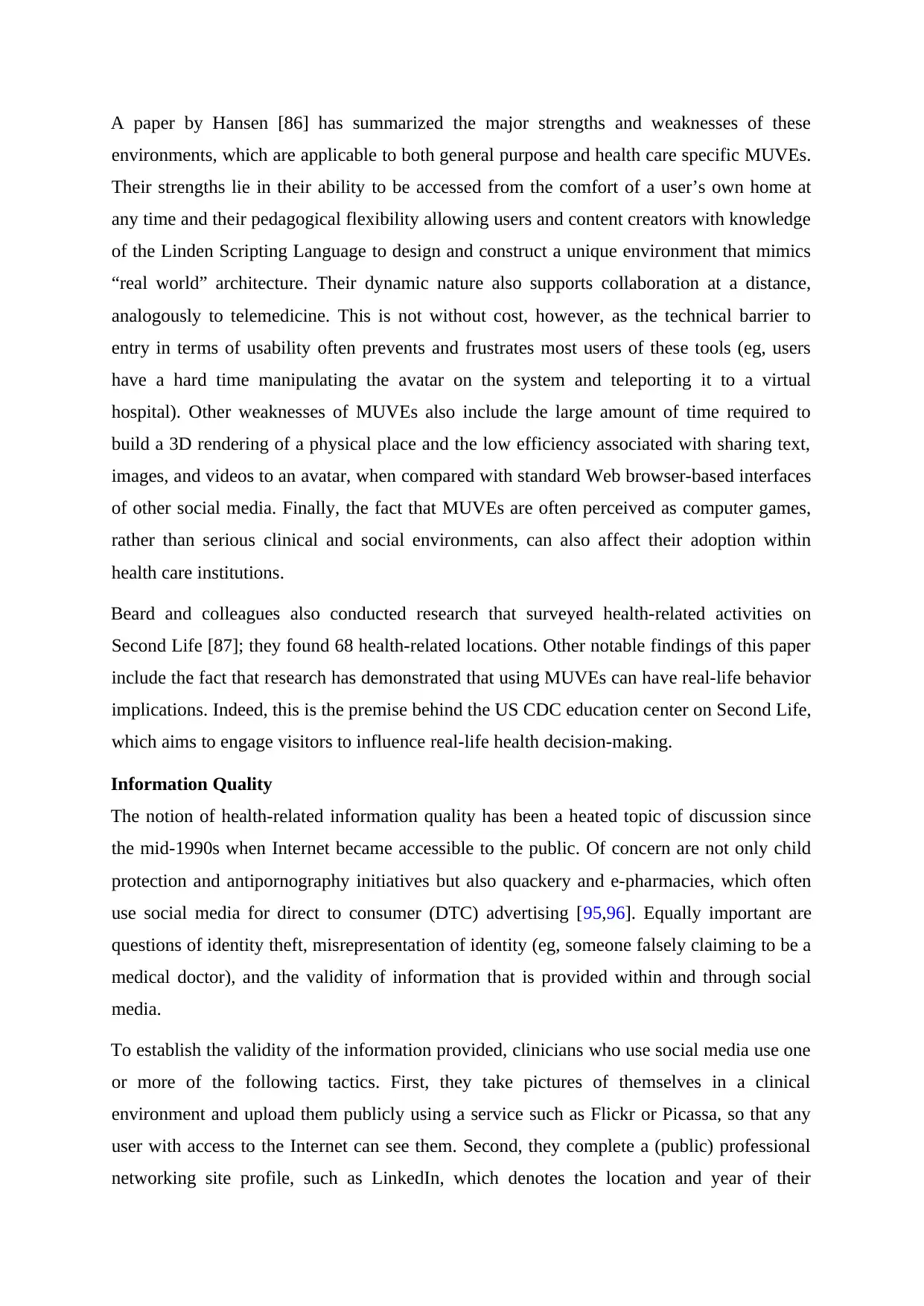
A paper by Hansen [86] has summarized the major strengths and weaknesses of these
environments, which are applicable to both general purpose and health care specific MUVEs.
Their strengths lie in their ability to be accessed from the comfort of a user’s own home at
any time and their pedagogical flexibility allowing users and content creators with knowledge
of the Linden Scripting Language to design and construct a unique environment that mimics
“real world” architecture. Their dynamic nature also supports collaboration at a distance,
analogously to telemedicine. This is not without cost, however, as the technical barrier to
entry in terms of usability often prevents and frustrates most users of these tools (eg, users
have a hard time manipulating the avatar on the system and teleporting it to a virtual
hospital). Other weaknesses of MUVEs also include the large amount of time required to
build a 3D rendering of a physical place and the low efficiency associated with sharing text,
images, and videos to an avatar, when compared with standard Web browser-based interfaces
of other social media. Finally, the fact that MUVEs are often perceived as computer games,
rather than serious clinical and social environments, can also affect their adoption within
health care institutions.
Beard and colleagues also conducted research that surveyed health-related activities on
Second Life [87]; they found 68 health-related locations. Other notable findings of this paper
include the fact that research has demonstrated that using MUVEs can have real-life behavior
implications. Indeed, this is the premise behind the US CDC education center on Second Life,
which aims to engage visitors to influence real-life health decision-making.
Information Quality
The notion of health-related information quality has been a heated topic of discussion since
the mid-1990s when Internet became accessible to the public. Of concern are not only child
protection and antipornography initiatives but also quackery and e-pharmacies, which often
use social media for direct to consumer (DTC) advertising [95,96]. Equally important are
questions of identity theft, misrepresentation of identity (eg, someone falsely claiming to be a
medical doctor), and the validity of information that is provided within and through social
media.
To establish the validity of the information provided, clinicians who use social media use one
or more of the following tactics. First, they take pictures of themselves in a clinical
environment and upload them publicly using a service such as Flickr or Picassa, so that any
user with access to the Internet can see them. Second, they complete a (public) professional
networking site profile, such as LinkedIn, which denotes the location and year of their
environments, which are applicable to both general purpose and health care specific MUVEs.
Their strengths lie in their ability to be accessed from the comfort of a user’s own home at
any time and their pedagogical flexibility allowing users and content creators with knowledge
of the Linden Scripting Language to design and construct a unique environment that mimics
“real world” architecture. Their dynamic nature also supports collaboration at a distance,
analogously to telemedicine. This is not without cost, however, as the technical barrier to
entry in terms of usability often prevents and frustrates most users of these tools (eg, users
have a hard time manipulating the avatar on the system and teleporting it to a virtual
hospital). Other weaknesses of MUVEs also include the large amount of time required to
build a 3D rendering of a physical place and the low efficiency associated with sharing text,
images, and videos to an avatar, when compared with standard Web browser-based interfaces
of other social media. Finally, the fact that MUVEs are often perceived as computer games,
rather than serious clinical and social environments, can also affect their adoption within
health care institutions.
Beard and colleagues also conducted research that surveyed health-related activities on
Second Life [87]; they found 68 health-related locations. Other notable findings of this paper
include the fact that research has demonstrated that using MUVEs can have real-life behavior
implications. Indeed, this is the premise behind the US CDC education center on Second Life,
which aims to engage visitors to influence real-life health decision-making.
Information Quality
The notion of health-related information quality has been a heated topic of discussion since
the mid-1990s when Internet became accessible to the public. Of concern are not only child
protection and antipornography initiatives but also quackery and e-pharmacies, which often
use social media for direct to consumer (DTC) advertising [95,96]. Equally important are
questions of identity theft, misrepresentation of identity (eg, someone falsely claiming to be a
medical doctor), and the validity of information that is provided within and through social
media.
To establish the validity of the information provided, clinicians who use social media use one
or more of the following tactics. First, they take pictures of themselves in a clinical
environment and upload them publicly using a service such as Flickr or Picassa, so that any
user with access to the Internet can see them. Second, they complete a (public) professional
networking site profile, such as LinkedIn, which denotes the location and year of their
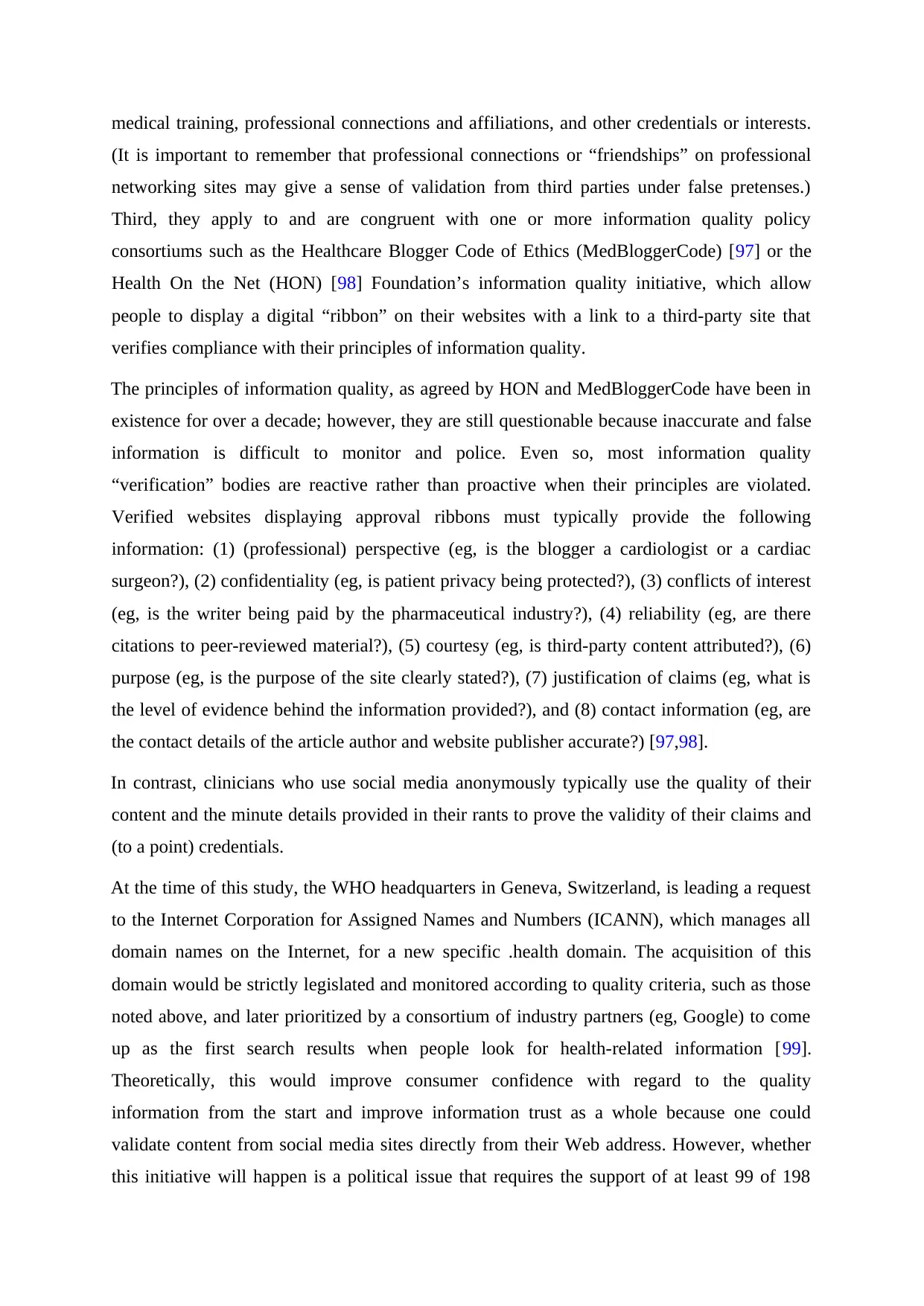
medical training, professional connections and affiliations, and other credentials or interests.
(It is important to remember that professional connections or “friendships” on professional
networking sites may give a sense of validation from third parties under false pretenses.)
Third, they apply to and are congruent with one or more information quality policy
consortiums such as the Healthcare Blogger Code of Ethics (MedBloggerCode) [97] or the
Health On the Net (HON) [98] Foundation’s information quality initiative, which allow
people to display a digital “ribbon” on their websites with a link to a third-party site that
verifies compliance with their principles of information quality.
The principles of information quality, as agreed by HON and MedBloggerCode have been in
existence for over a decade; however, they are still questionable because inaccurate and false
information is difficult to monitor and police. Even so, most information quality
“verification” bodies are reactive rather than proactive when their principles are violated.
Verified websites displaying approval ribbons must typically provide the following
information: (1) (professional) perspective (eg, is the blogger a cardiologist or a cardiac
surgeon?), (2) confidentiality (eg, is patient privacy being protected?), (3) conflicts of interest
(eg, is the writer being paid by the pharmaceutical industry?), (4) reliability (eg, are there
citations to peer-reviewed material?), (5) courtesy (eg, is third-party content attributed?), (6)
purpose (eg, is the purpose of the site clearly stated?), (7) justification of claims (eg, what is
the level of evidence behind the information provided?), and (8) contact information (eg, are
the contact details of the article author and website publisher accurate?) [97,98].
In contrast, clinicians who use social media anonymously typically use the quality of their
content and the minute details provided in their rants to prove the validity of their claims and
(to a point) credentials.
At the time of this study, the WHO headquarters in Geneva, Switzerland, is leading a request
to the Internet Corporation for Assigned Names and Numbers (ICANN), which manages all
domain names on the Internet, for a new specific .health domain. The acquisition of this
domain would be strictly legislated and monitored according to quality criteria, such as those
noted above, and later prioritized by a consortium of industry partners (eg, Google) to come
up as the first search results when people look for health-related information [99].
Theoretically, this would improve consumer confidence with regard to the quality
information from the start and improve information trust as a whole because one could
validate content from social media sites directly from their Web address. However, whether
this initiative will happen is a political issue that requires the support of at least 99 of 198
(It is important to remember that professional connections or “friendships” on professional
networking sites may give a sense of validation from third parties under false pretenses.)
Third, they apply to and are congruent with one or more information quality policy
consortiums such as the Healthcare Blogger Code of Ethics (MedBloggerCode) [97] or the
Health On the Net (HON) [98] Foundation’s information quality initiative, which allow
people to display a digital “ribbon” on their websites with a link to a third-party site that
verifies compliance with their principles of information quality.
The principles of information quality, as agreed by HON and MedBloggerCode have been in
existence for over a decade; however, they are still questionable because inaccurate and false
information is difficult to monitor and police. Even so, most information quality
“verification” bodies are reactive rather than proactive when their principles are violated.
Verified websites displaying approval ribbons must typically provide the following
information: (1) (professional) perspective (eg, is the blogger a cardiologist or a cardiac
surgeon?), (2) confidentiality (eg, is patient privacy being protected?), (3) conflicts of interest
(eg, is the writer being paid by the pharmaceutical industry?), (4) reliability (eg, are there
citations to peer-reviewed material?), (5) courtesy (eg, is third-party content attributed?), (6)
purpose (eg, is the purpose of the site clearly stated?), (7) justification of claims (eg, what is
the level of evidence behind the information provided?), and (8) contact information (eg, are
the contact details of the article author and website publisher accurate?) [97,98].
In contrast, clinicians who use social media anonymously typically use the quality of their
content and the minute details provided in their rants to prove the validity of their claims and
(to a point) credentials.
At the time of this study, the WHO headquarters in Geneva, Switzerland, is leading a request
to the Internet Corporation for Assigned Names and Numbers (ICANN), which manages all
domain names on the Internet, for a new specific .health domain. The acquisition of this
domain would be strictly legislated and monitored according to quality criteria, such as those
noted above, and later prioritized by a consortium of industry partners (eg, Google) to come
up as the first search results when people look for health-related information [99].
Theoretically, this would improve consumer confidence with regard to the quality
information from the start and improve information trust as a whole because one could
validate content from social media sites directly from their Web address. However, whether
this initiative will happen is a political issue that requires the support of at least 99 of 198
Paraphrase This Document
Need a fresh take? Get an instant paraphrase of this document with our AI Paraphraser

member states at the World Health Assembly (WHO’s governing body) and will likely not be
resolved in the near future.
Validated information sites have also existed since the dawn of the Internet. In social media,
wikis like Medpedia (a Harvard, Stanford, University of Michigan, and UC Berkley
initiative), which verify authors’ credentials before allowing them to generate content, have
tried to improve information quality and “validity”. However, when the majority of articles
by these “author verified” sources are compared with open initiatives like Wikipedia, they
tend to be shorter, of equal or less quality, and have fewer references due to the restriction of
users that can add and democratize the amount of content available on the Internet [100,101].
Videos and multimedia in social media create new challenges but also offer new solutions,
such as steering consumers to higher quality information through peer ratings and other forms
of “apomediation” [102,103].
resolved in the near future.
Validated information sites have also existed since the dawn of the Internet. In social media,
wikis like Medpedia (a Harvard, Stanford, University of Michigan, and UC Berkley
initiative), which verify authors’ credentials before allowing them to generate content, have
tried to improve information quality and “validity”. However, when the majority of articles
by these “author verified” sources are compared with open initiatives like Wikipedia, they
tend to be shorter, of equal or less quality, and have fewer references due to the restriction of
users that can add and democratize the amount of content available on the Internet [100,101].
Videos and multimedia in social media create new challenges but also offer new solutions,
such as steering consumers to higher quality information through peer ratings and other forms
of “apomediation” [102,103].

3. Design/Methodology
We considered the cause of death data of Sri Lanka in 2001, 2002, 2003, 2004, 2005, 2009,
2010 for the analysis. Cause of deaths were separately obtained for males and females in five-
year age intervals (e.g. zero to 4 years, five to 9 years). Starting point for the analysis was
selected based on the population census 2001. A census was not performed for 20 years
before 2001 and thus the population projection data for the period before 2001 was not
included in the analysis. Cause of death data for 2006, 2007, 2008 and for the period after
2010 were not available at the time of analysis. Deaths due to NCDs were categorized into
four major groups, i.e., cardiovascular diseases (ICD 00–99), neoplasm (ICD C00 – C99),
chronic respiratory diseases (J30 – J98) and diabetes (E10 – E14). Similarly, we obtained
mid-year population data for population, males and females in five-year age intervals for the
period of 2001 to 2010 published by the Census and Statistics Department of Sri Lanka.
Population census in 2001 covered only 18 districts out of 25 due to the war in the North and
East regions of the country. Therefore, we obtained an estimated midyear population for
2001. Age standardized death rates (ASMR) were calculated based on the WHO 2000–25
World Standard Population Distribution. Unconditional probability of dying due to NCDs
during age 30 to 70 years was determined using the standard formula (Refer Additional file 1
for calculation steps) [1]. Initially, age specific mortality rates and probability of dying for
each 5-year age intervals were calculated. Subsequently, probability of dying between age 30
and 70 was calculated. All the calculations were done in R programming language version
3·2·3 [11]
This was a self-administered questionnaire based cross sectional study. The sample size was
calculated to be 66. The questionnaire was developed according to WHO STEP wise
We considered the cause of death data of Sri Lanka in 2001, 2002, 2003, 2004, 2005, 2009,
2010 for the analysis. Cause of deaths were separately obtained for males and females in five-
year age intervals (e.g. zero to 4 years, five to 9 years). Starting point for the analysis was
selected based on the population census 2001. A census was not performed for 20 years
before 2001 and thus the population projection data for the period before 2001 was not
included in the analysis. Cause of death data for 2006, 2007, 2008 and for the period after
2010 were not available at the time of analysis. Deaths due to NCDs were categorized into
four major groups, i.e., cardiovascular diseases (ICD 00–99), neoplasm (ICD C00 – C99),
chronic respiratory diseases (J30 – J98) and diabetes (E10 – E14). Similarly, we obtained
mid-year population data for population, males and females in five-year age intervals for the
period of 2001 to 2010 published by the Census and Statistics Department of Sri Lanka.
Population census in 2001 covered only 18 districts out of 25 due to the war in the North and
East regions of the country. Therefore, we obtained an estimated midyear population for
2001. Age standardized death rates (ASMR) were calculated based on the WHO 2000–25
World Standard Population Distribution. Unconditional probability of dying due to NCDs
during age 30 to 70 years was determined using the standard formula (Refer Additional file 1
for calculation steps) [1]. Initially, age specific mortality rates and probability of dying for
each 5-year age intervals were calculated. Subsequently, probability of dying between age 30
and 70 was calculated. All the calculations were done in R programming language version
3·2·3 [11]
This was a self-administered questionnaire based cross sectional study. The sample size was
calculated to be 66. The questionnaire was developed according to WHO STEP wise
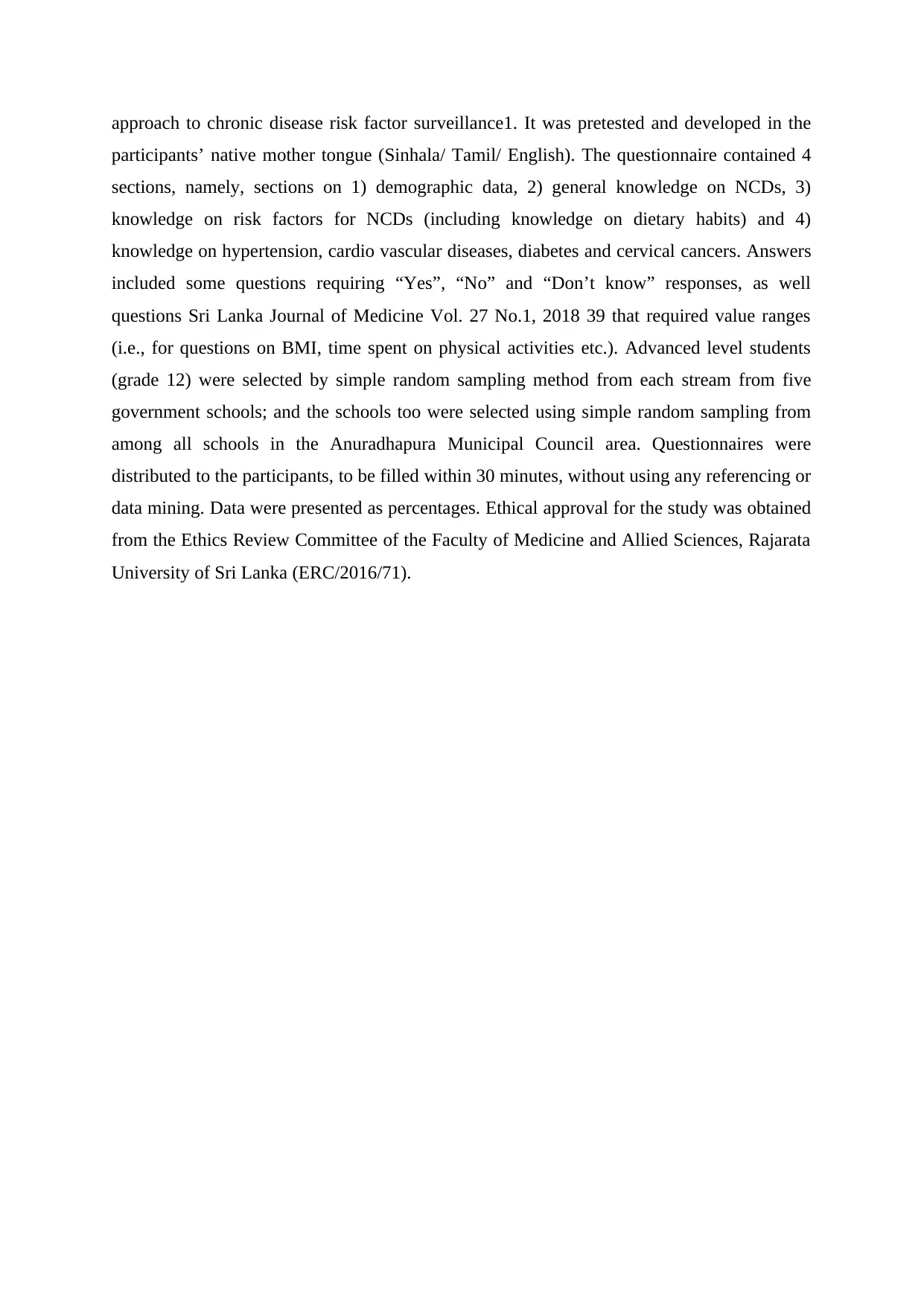
approach to chronic disease risk factor surveillance1. It was pretested and developed in the
participants’ native mother tongue (Sinhala/ Tamil/ English). The questionnaire contained 4
sections, namely, sections on 1) demographic data, 2) general knowledge on NCDs, 3)
knowledge on risk factors for NCDs (including knowledge on dietary habits) and 4)
knowledge on hypertension, cardio vascular diseases, diabetes and cervical cancers. Answers
included some questions requiring “Yes”, “No” and “Don’t know” responses, as well
questions Sri Lanka Journal of Medicine Vol. 27 No.1, 2018 39 that required value ranges
(i.e., for questions on BMI, time spent on physical activities etc.). Advanced level students
(grade 12) were selected by simple random sampling method from each stream from five
government schools; and the schools too were selected using simple random sampling from
among all schools in the Anuradhapura Municipal Council area. Questionnaires were
distributed to the participants, to be filled within 30 minutes, without using any referencing or
data mining. Data were presented as percentages. Ethical approval for the study was obtained
from the Ethics Review Committee of the Faculty of Medicine and Allied Sciences, Rajarata
University of Sri Lanka (ERC/2016/71).
participants’ native mother tongue (Sinhala/ Tamil/ English). The questionnaire contained 4
sections, namely, sections on 1) demographic data, 2) general knowledge on NCDs, 3)
knowledge on risk factors for NCDs (including knowledge on dietary habits) and 4)
knowledge on hypertension, cardio vascular diseases, diabetes and cervical cancers. Answers
included some questions requiring “Yes”, “No” and “Don’t know” responses, as well
questions Sri Lanka Journal of Medicine Vol. 27 No.1, 2018 39 that required value ranges
(i.e., for questions on BMI, time spent on physical activities etc.). Advanced level students
(grade 12) were selected by simple random sampling method from each stream from five
government schools; and the schools too were selected using simple random sampling from
among all schools in the Anuradhapura Municipal Council area. Questionnaires were
distributed to the participants, to be filled within 30 minutes, without using any referencing or
data mining. Data were presented as percentages. Ethical approval for the study was obtained
from the Ethics Review Committee of the Faculty of Medicine and Allied Sciences, Rajarata
University of Sri Lanka (ERC/2016/71).
Secure Best Marks with AI Grader
Need help grading? Try our AI Grader for instant feedback on your assignments.
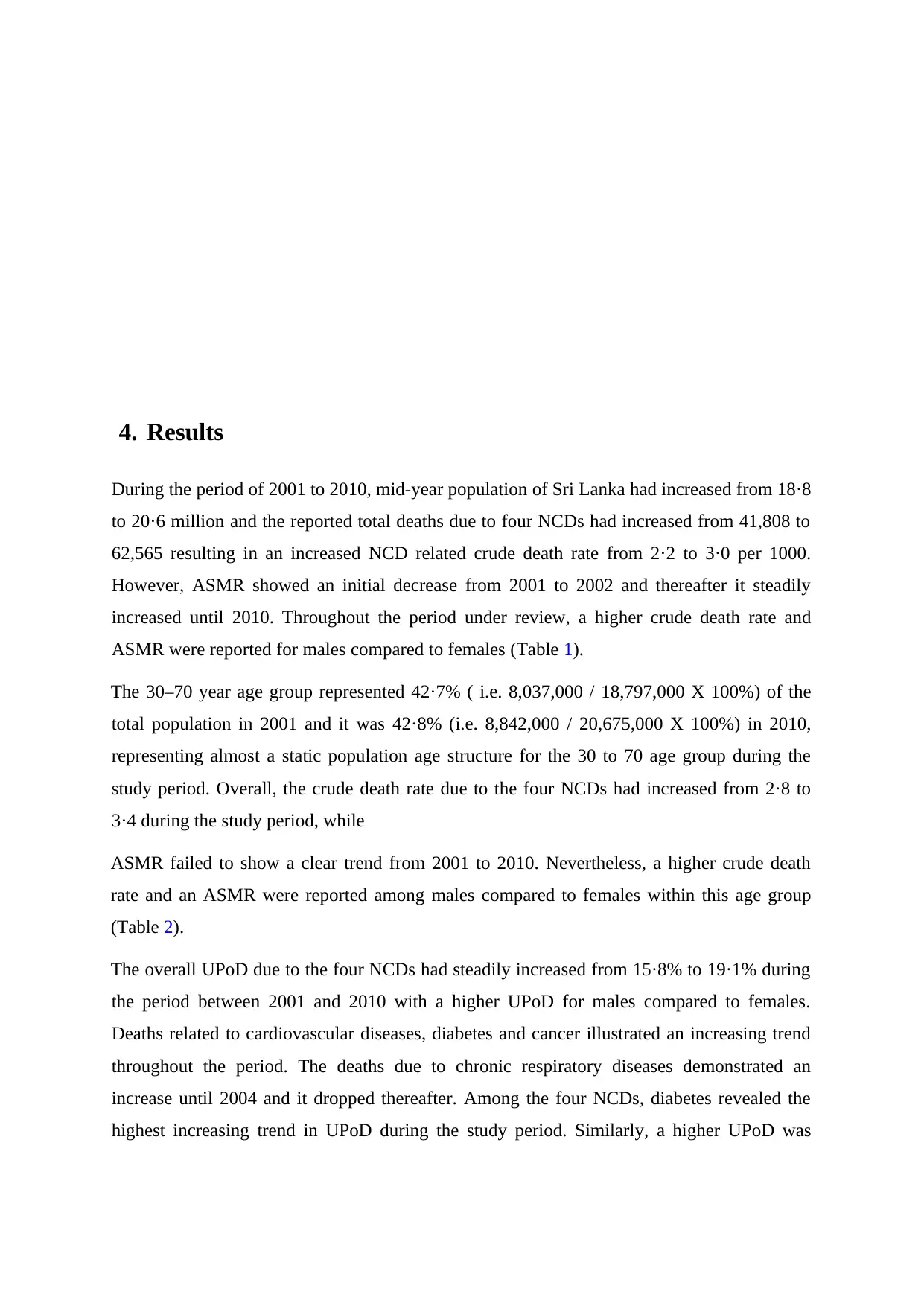
4. Results
During the period of 2001 to 2010, mid-year population of Sri Lanka had increased from 18·8
to 20·6 million and the reported total deaths due to four NCDs had increased from 41,808 to
62,565 resulting in an increased NCD related crude death rate from 2·2 to 3·0 per 1000.
However, ASMR showed an initial decrease from 2001 to 2002 and thereafter it steadily
increased until 2010. Throughout the period under review, a higher crude death rate and
ASMR were reported for males compared to females (Table 1).
The 30–70 year age group represented 42·7% ( i.e. 8,037,000 / 18,797,000 X 100%) of the
total population in 2001 and it was 42·8% (i.e. 8,842,000 / 20,675,000 X 100%) in 2010,
representing almost a static population age structure for the 30 to 70 age group during the
study period. Overall, the crude death rate due to the four NCDs had increased from 2·8 to
3·4 during the study period, while
ASMR failed to show a clear trend from 2001 to 2010. Nevertheless, a higher crude death
rate and an ASMR were reported among males compared to females within this age group
(Table 2).
The overall UPoD due to the four NCDs had steadily increased from 15·8% to 19·1% during
the period between 2001 and 2010 with a higher UPoD for males compared to females.
Deaths related to cardiovascular diseases, diabetes and cancer illustrated an increasing trend
throughout the period. The deaths due to chronic respiratory diseases demonstrated an
increase until 2004 and it dropped thereafter. Among the four NCDs, diabetes revealed the
highest increasing trend in UPoD during the study period. Similarly, a higher UPoD was
During the period of 2001 to 2010, mid-year population of Sri Lanka had increased from 18·8
to 20·6 million and the reported total deaths due to four NCDs had increased from 41,808 to
62,565 resulting in an increased NCD related crude death rate from 2·2 to 3·0 per 1000.
However, ASMR showed an initial decrease from 2001 to 2002 and thereafter it steadily
increased until 2010. Throughout the period under review, a higher crude death rate and
ASMR were reported for males compared to females (Table 1).
The 30–70 year age group represented 42·7% ( i.e. 8,037,000 / 18,797,000 X 100%) of the
total population in 2001 and it was 42·8% (i.e. 8,842,000 / 20,675,000 X 100%) in 2010,
representing almost a static population age structure for the 30 to 70 age group during the
study period. Overall, the crude death rate due to the four NCDs had increased from 2·8 to
3·4 during the study period, while
ASMR failed to show a clear trend from 2001 to 2010. Nevertheless, a higher crude death
rate and an ASMR were reported among males compared to females within this age group
(Table 2).
The overall UPoD due to the four NCDs had steadily increased from 15·8% to 19·1% during
the period between 2001 and 2010 with a higher UPoD for males compared to females.
Deaths related to cardiovascular diseases, diabetes and cancer illustrated an increasing trend
throughout the period. The deaths due to chronic respiratory diseases demonstrated an
increase until 2004 and it dropped thereafter. Among the four NCDs, diabetes revealed the
highest increasing trend in UPoD during the study period. Similarly, a higher UPoD was
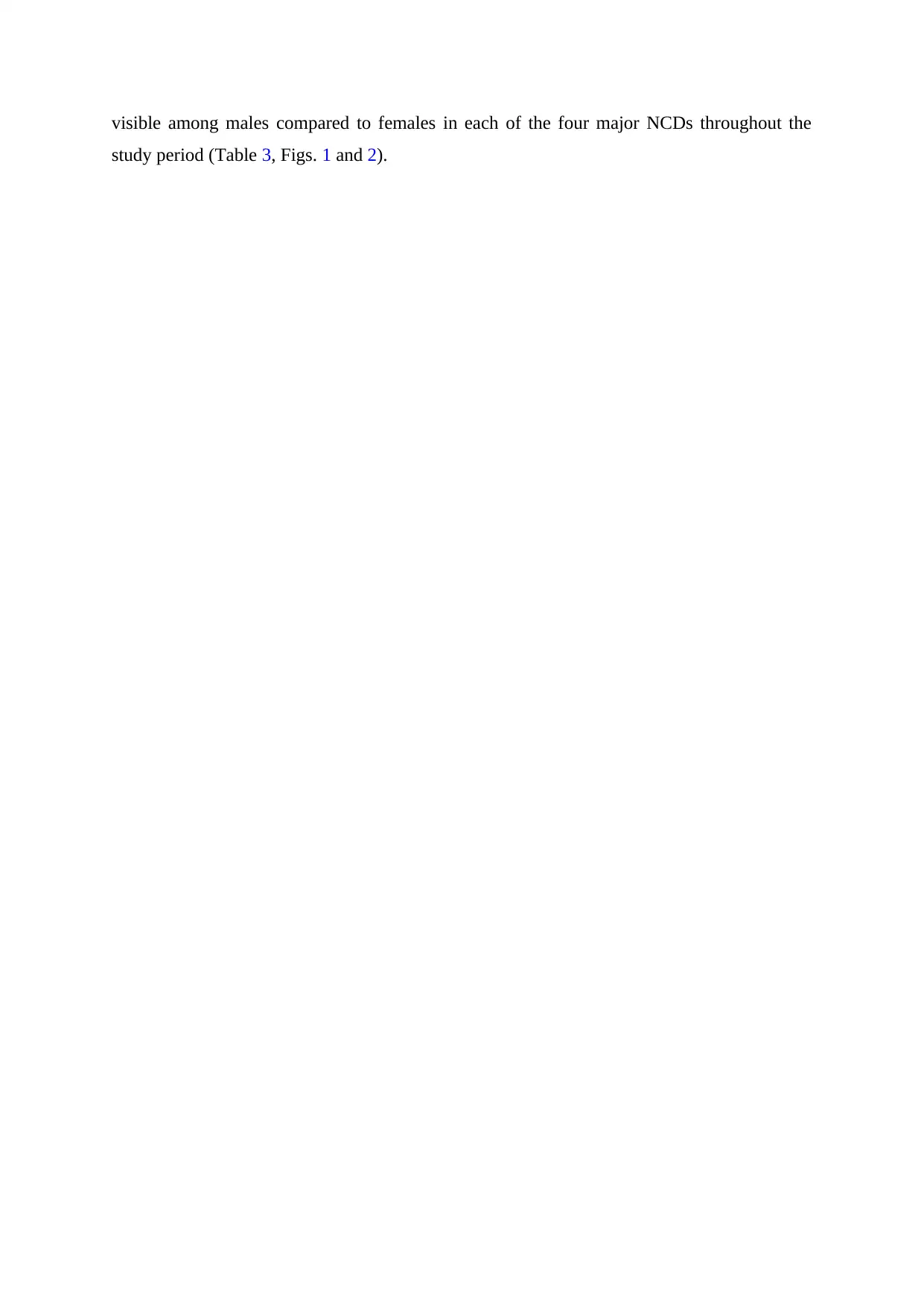
visible among males compared to females in each of the four major NCDs throughout the
study period (Table 3, Figs. 1 and 2).
study period (Table 3, Figs. 1 and 2).

Table 1 Population and non-communicable disease mortality statistics from 2001 to 2010
Both sexes - all age groups Males - all age groups Females - all age groups
Year Mid-year Total deaths Death ASMR Mid-year Total deaths Death ASMR Mid-year Total deaths
Death ASMR population from 4 NCDsa ratea populationfrom 4 NCDs rate populationfrom 4 NCDs
rate
2001 18,797,000b 41,808 2.2 2.1 9359,000b 25,526 2.7 4.8 9438,000b 16,282 1.7 3.7
2002 18,921,000 42,485 2.2 1.4 9,350,000 25,963 2.8 3.7 9,571,000 16,522 1.7 2.1
2003 19,173,083 45,350 2.4 1.5 9,475,000 27,358 2.9 3.9 9,698,083 17,992 1.8 2.3
2004 19,433,360 47,856 2.5 1.6 9,676,883 28,798 3.0 4.0 9,756,478 19,058 1.9 2.4
2005 19,643,474 49,013 2.5 1.6 9,782,497 29,488 3.0 4.0 9,860,977 19,525 1.9 2.4
2009 20,476,000 60,880 3.0 1.8 10,174,000 34,830 3.4 4.4 10,302,000 26,050 2.5 3.0
2010 20,675,000 62,565 3.0 1.8 10,273,000 35,584 3.5 4.4 10,402,000 26,981 2.6 3.0
ASMR Age standardized death rates
a b
Death rates per 1000 population Estimated mid-population (2001 census was done only in 18 districts out of 25)
Both sexes - all age groups Males - all age groups Females - all age groups
Year Mid-year Total deaths Death ASMR Mid-year Total deaths Death ASMR Mid-year Total deaths
Death ASMR population from 4 NCDsa ratea populationfrom 4 NCDs rate populationfrom 4 NCDs
rate
2001 18,797,000b 41,808 2.2 2.1 9359,000b 25,526 2.7 4.8 9438,000b 16,282 1.7 3.7
2002 18,921,000 42,485 2.2 1.4 9,350,000 25,963 2.8 3.7 9,571,000 16,522 1.7 2.1
2003 19,173,083 45,350 2.4 1.5 9,475,000 27,358 2.9 3.9 9,698,083 17,992 1.8 2.3
2004 19,433,360 47,856 2.5 1.6 9,676,883 28,798 3.0 4.0 9,756,478 19,058 1.9 2.4
2005 19,643,474 49,013 2.5 1.6 9,782,497 29,488 3.0 4.0 9,860,977 19,525 1.9 2.4
2009 20,476,000 60,880 3.0 1.8 10,174,000 34,830 3.4 4.4 10,302,000 26,050 2.5 3.0
2010 20,675,000 62,565 3.0 1.8 10,273,000 35,584 3.5 4.4 10,402,000 26,981 2.6 3.0
ASMR Age standardized death rates
a b
Death rates per 1000 population Estimated mid-population (2001 census was done only in 18 districts out of 25)
Paraphrase This Document
Need a fresh take? Get an instant paraphrase of this document with our AI Paraphraser
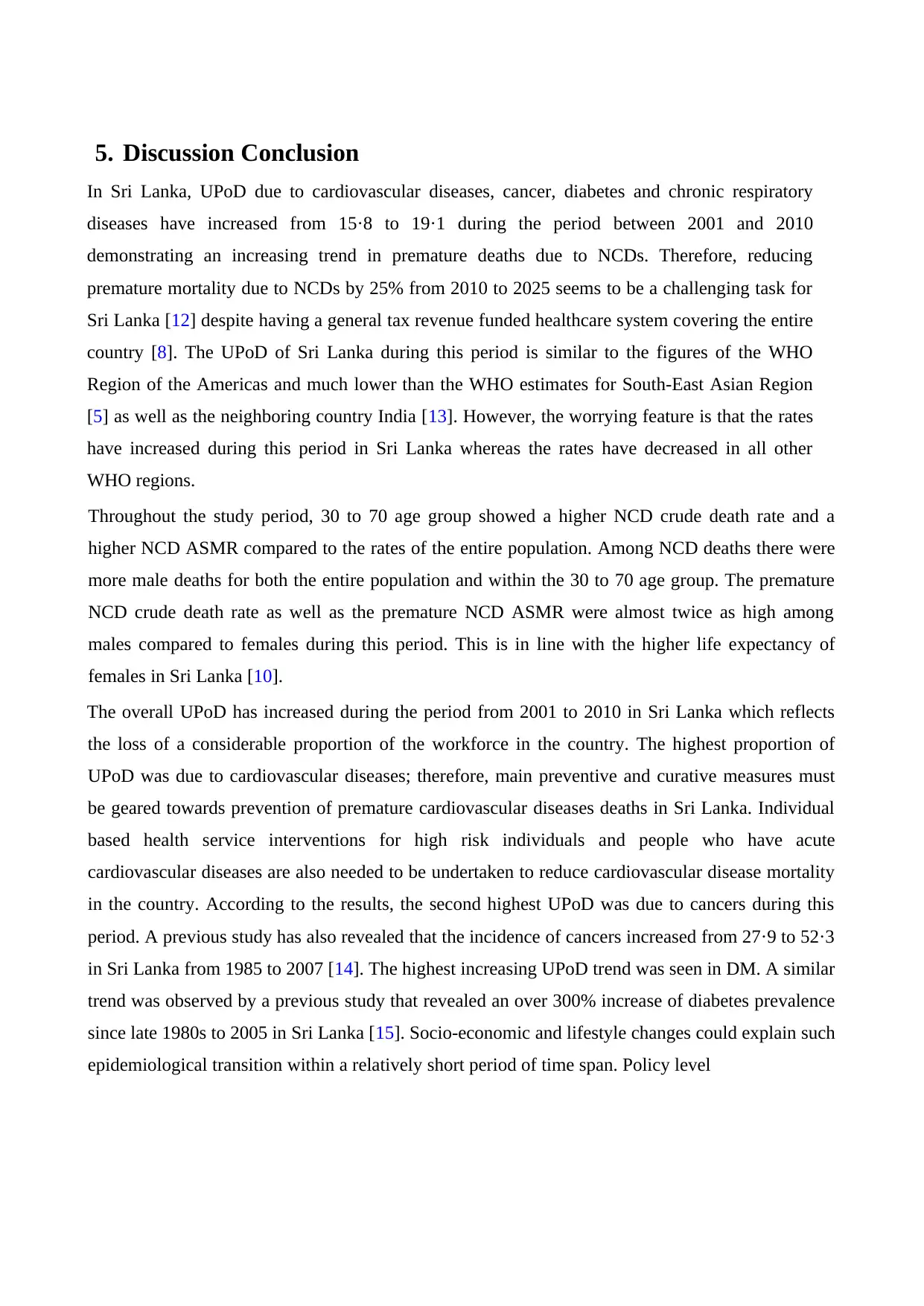
5. Discussion Conclusion
In Sri Lanka, UPoD due to cardiovascular diseases, cancer, diabetes and chronic respiratory
diseases have increased from 15·8 to 19·1 during the period between 2001 and 2010
demonstrating an increasing trend in premature deaths due to NCDs. Therefore, reducing
premature mortality due to NCDs by 25% from 2010 to 2025 seems to be a challenging task for
Sri Lanka [12] despite having a general tax revenue funded healthcare system covering the entire
country [8]. The UPoD of Sri Lanka during this period is similar to the figures of the WHO
Region of the Americas and much lower than the WHO estimates for South-East Asian Region
[5] as well as the neighboring country India [13]. However, the worrying feature is that the rates
have increased during this period in Sri Lanka whereas the rates have decreased in all other
WHO regions.
Throughout the study period, 30 to 70 age group showed a higher NCD crude death rate and a
higher NCD ASMR compared to the rates of the entire population. Among NCD deaths there were
more male deaths for both the entire population and within the 30 to 70 age group. The premature
NCD crude death rate as well as the premature NCD ASMR were almost twice as high among
males compared to females during this period. This is in line with the higher life expectancy of
females in Sri Lanka [10].
The overall UPoD has increased during the period from 2001 to 2010 in Sri Lanka which reflects
the loss of a considerable proportion of the workforce in the country. The highest proportion of
UPoD was due to cardiovascular diseases; therefore, main preventive and curative measures must
be geared towards prevention of premature cardiovascular diseases deaths in Sri Lanka. Individual
based health service interventions for high risk individuals and people who have acute
cardiovascular diseases are also needed to be undertaken to reduce cardiovascular disease mortality
in the country. According to the results, the second highest UPoD was due to cancers during this
period. A previous study has also revealed that the incidence of cancers increased from 27·9 to 52·3
in Sri Lanka from 1985 to 2007 [14]. The highest increasing UPoD trend was seen in DM. A similar
trend was observed by a previous study that revealed an over 300% increase of diabetes prevalence
since late 1980s to 2005 in Sri Lanka [15]. Socio-economic and lifestyle changes could explain such
epidemiological transition within a relatively short period of time span. Policy level
In Sri Lanka, UPoD due to cardiovascular diseases, cancer, diabetes and chronic respiratory
diseases have increased from 15·8 to 19·1 during the period between 2001 and 2010
demonstrating an increasing trend in premature deaths due to NCDs. Therefore, reducing
premature mortality due to NCDs by 25% from 2010 to 2025 seems to be a challenging task for
Sri Lanka [12] despite having a general tax revenue funded healthcare system covering the entire
country [8]. The UPoD of Sri Lanka during this period is similar to the figures of the WHO
Region of the Americas and much lower than the WHO estimates for South-East Asian Region
[5] as well as the neighboring country India [13]. However, the worrying feature is that the rates
have increased during this period in Sri Lanka whereas the rates have decreased in all other
WHO regions.
Throughout the study period, 30 to 70 age group showed a higher NCD crude death rate and a
higher NCD ASMR compared to the rates of the entire population. Among NCD deaths there were
more male deaths for both the entire population and within the 30 to 70 age group. The premature
NCD crude death rate as well as the premature NCD ASMR were almost twice as high among
males compared to females during this period. This is in line with the higher life expectancy of
females in Sri Lanka [10].
The overall UPoD has increased during the period from 2001 to 2010 in Sri Lanka which reflects
the loss of a considerable proportion of the workforce in the country. The highest proportion of
UPoD was due to cardiovascular diseases; therefore, main preventive and curative measures must
be geared towards prevention of premature cardiovascular diseases deaths in Sri Lanka. Individual
based health service interventions for high risk individuals and people who have acute
cardiovascular diseases are also needed to be undertaken to reduce cardiovascular disease mortality
in the country. According to the results, the second highest UPoD was due to cancers during this
period. A previous study has also revealed that the incidence of cancers increased from 27·9 to 52·3
in Sri Lanka from 1985 to 2007 [14]. The highest increasing UPoD trend was seen in DM. A similar
trend was observed by a previous study that revealed an over 300% increase of diabetes prevalence
since late 1980s to 2005 in Sri Lanka [15]. Socio-economic and lifestyle changes could explain such
epidemiological transition within a relatively short period of time span. Policy level

Both sexes 30–70 age groups Males - 30 – 70 age groups Females - 30 – 70 age groups
Year Mid-year Total deaths Death ASMR Mid-year Total deaths Death ASMR Mid-year Total deaths
Death ASMR population from 4 NCDs ratea populationfrom 4 NCDs ratea populationfrom 4 NCDs
ratea
2001 8037,000b 22,864 2.8 3.1 3950,000b 14,810 3.7 7.8 4087,000b 8054 2.0 4.8
2002 8,070,000 22,779 2.8 1.7 3,927,000 14,870 3.8 4.7 4,143,000 7909 1.9 2.2
2003 8,179,297 23,995 2.9 1.7 3,980,000 15,546 3.9 4.8 4,199,297 8449 2.0 2.3
2004 8,309,920 25,321 3.0 1.8 4,086,766 16,431 4.0 4.9 4,223,153 8890 2.1 2.4
2005 8,399,848 25,410 3.0 1.8 4,132,031 16,307 3.9 4.7 4,267,817 9103 2.1 2.4
2009 8,755,000 29,659 3.4 1.9 4,296,000 18,631 4.3 5.1 4,459,000 11,028 2.5 2.7
2010 8,842,000 29,933 3.4 1.9 4,339,000 18,846 4.3 5.0 4,503,000 11,087 2.5 2.6
ASMR Age standardized death rates
a b
Death rates per 1000 population Estimated mid-population (2001 census was done only in 18 districts out of 25)
Table 3 Unconditional probability of dying (%) due to four non-communicable diseases between ages 30 to 70 from 2001 to 2010
Year Overall Males Females Overall Males Female
s
Overall Males Females Overall Males Female
s
Overall Males Females
2001 15.8 20.5 11.1 9.3 13.0 5.7 1.1 1.3 0.9 3.7 4.1 3.3 2.5 3.5 1.6
2002 15.3 20.1 10.6 9.3 13.1 5.7 1.0 1.2 0.8 3.5 4.0 3.1 2.2 3.1 1.3
2003 15.9 20.8 11.3 9.4 13.1 5.9 1.2 1.3 1.0 3.7 4.3 3.2 2.5 3.5 1.6
2004 16.9 21.9 11.9 9.7 13.5 6.0 1.4 1.6 1.2 4.1 4.7 3.6 2.7 3.7 1.7
2005 16.8 21.7 12.0 9.6 13.5 5.9 1.8 2.1 1.5 4.1 4.5 3.6 2.3 3.2 1.5
2009 19.0 24.1 14.1 10.0 13.6 6.5 3.2 3.7 2.7 4.8 5.4 4.2 2.4 3.4 1.5
2010 19.1 24.3 14.1 10.1 13.8 6.5 3.1 3.7 2.6 5.0 5.8 4.3 2.3 3.2 1.4
All four major Non-communicable
Diseases
CardiovascularDiseases Diabetes Mellitus Cancer Chronic RespiratoryDiseases
Year Mid-year Total deaths Death ASMR Mid-year Total deaths Death ASMR Mid-year Total deaths
Death ASMR population from 4 NCDs ratea populationfrom 4 NCDs ratea populationfrom 4 NCDs
ratea
2001 8037,000b 22,864 2.8 3.1 3950,000b 14,810 3.7 7.8 4087,000b 8054 2.0 4.8
2002 8,070,000 22,779 2.8 1.7 3,927,000 14,870 3.8 4.7 4,143,000 7909 1.9 2.2
2003 8,179,297 23,995 2.9 1.7 3,980,000 15,546 3.9 4.8 4,199,297 8449 2.0 2.3
2004 8,309,920 25,321 3.0 1.8 4,086,766 16,431 4.0 4.9 4,223,153 8890 2.1 2.4
2005 8,399,848 25,410 3.0 1.8 4,132,031 16,307 3.9 4.7 4,267,817 9103 2.1 2.4
2009 8,755,000 29,659 3.4 1.9 4,296,000 18,631 4.3 5.1 4,459,000 11,028 2.5 2.7
2010 8,842,000 29,933 3.4 1.9 4,339,000 18,846 4.3 5.0 4,503,000 11,087 2.5 2.6
ASMR Age standardized death rates
a b
Death rates per 1000 population Estimated mid-population (2001 census was done only in 18 districts out of 25)
Table 3 Unconditional probability of dying (%) due to four non-communicable diseases between ages 30 to 70 from 2001 to 2010
Year Overall Males Females Overall Males Female
s
Overall Males Females Overall Males Female
s
Overall Males Females
2001 15.8 20.5 11.1 9.3 13.0 5.7 1.1 1.3 0.9 3.7 4.1 3.3 2.5 3.5 1.6
2002 15.3 20.1 10.6 9.3 13.1 5.7 1.0 1.2 0.8 3.5 4.0 3.1 2.2 3.1 1.3
2003 15.9 20.8 11.3 9.4 13.1 5.9 1.2 1.3 1.0 3.7 4.3 3.2 2.5 3.5 1.6
2004 16.9 21.9 11.9 9.7 13.5 6.0 1.4 1.6 1.2 4.1 4.7 3.6 2.7 3.7 1.7
2005 16.8 21.7 12.0 9.6 13.5 5.9 1.8 2.1 1.5 4.1 4.5 3.6 2.3 3.2 1.5
2009 19.0 24.1 14.1 10.0 13.6 6.5 3.2 3.7 2.7 4.8 5.4 4.2 2.4 3.4 1.5
2010 19.1 24.3 14.1 10.1 13.8 6.5 3.1 3.7 2.6 5.0 5.8 4.3 2.3 3.2 1.4
All four major Non-communicable
Diseases
CardiovascularDiseases Diabetes Mellitus Cancer Chronic RespiratoryDiseases
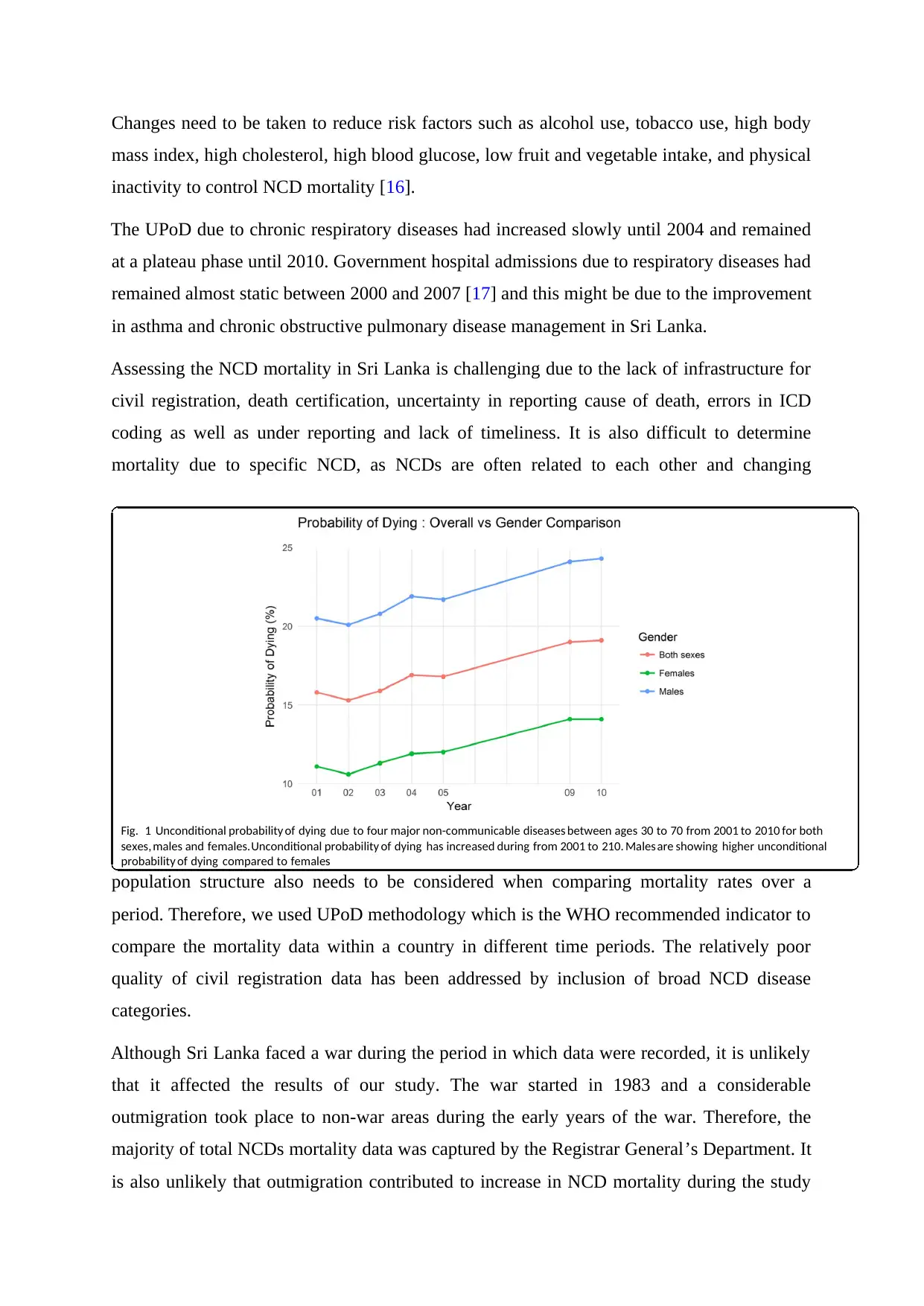
Changes need to be taken to reduce risk factors such as alcohol use, tobacco use, high body
mass index, high cholesterol, high blood glucose, low fruit and vegetable intake, and physical
inactivity to control NCD mortality [16].
The UPoD due to chronic respiratory diseases had increased slowly until 2004 and remained
at a plateau phase until 2010. Government hospital admissions due to respiratory diseases had
remained almost static between 2000 and 2007 [17] and this might be due to the improvement
in asthma and chronic obstructive pulmonary disease management in Sri Lanka.
Assessing the NCD mortality in Sri Lanka is challenging due to the lack of infrastructure for
civil registration, death certification, uncertainty in reporting cause of death, errors in ICD
coding as well as under reporting and lack of timeliness. It is also difficult to determine
mortality due to specific NCD, as NCDs are often related to each other and changing
population structure also needs to be considered when comparing mortality rates over a
period. Therefore, we used UPoD methodology which is the WHO recommended indicator to
compare the mortality data within a country in different time periods. The relatively poor
quality of civil registration data has been addressed by inclusion of broad NCD disease
categories.
Although Sri Lanka faced a war during the period in which data were recorded, it is unlikely
that it affected the results of our study. The war started in 1983 and a considerable
outmigration took place to non-war areas during the early years of the war. Therefore, the
majority of total NCDs mortality data was captured by the Registrar General’s Department. It
is also unlikely that outmigration contributed to increase in NCD mortality during the study
Fig. 1 Unconditional probability of dying due to four major non-communicable diseases between ages 30 to 70 from 2001 to 2010 for both
sexes, males and females.Unconditional probability of dying has increased during from 2001 to 210. Males are showing higher unconditional
probability of dying compared to females
mass index, high cholesterol, high blood glucose, low fruit and vegetable intake, and physical
inactivity to control NCD mortality [16].
The UPoD due to chronic respiratory diseases had increased slowly until 2004 and remained
at a plateau phase until 2010. Government hospital admissions due to respiratory diseases had
remained almost static between 2000 and 2007 [17] and this might be due to the improvement
in asthma and chronic obstructive pulmonary disease management in Sri Lanka.
Assessing the NCD mortality in Sri Lanka is challenging due to the lack of infrastructure for
civil registration, death certification, uncertainty in reporting cause of death, errors in ICD
coding as well as under reporting and lack of timeliness. It is also difficult to determine
mortality due to specific NCD, as NCDs are often related to each other and changing
population structure also needs to be considered when comparing mortality rates over a
period. Therefore, we used UPoD methodology which is the WHO recommended indicator to
compare the mortality data within a country in different time periods. The relatively poor
quality of civil registration data has been addressed by inclusion of broad NCD disease
categories.
Although Sri Lanka faced a war during the period in which data were recorded, it is unlikely
that it affected the results of our study. The war started in 1983 and a considerable
outmigration took place to non-war areas during the early years of the war. Therefore, the
majority of total NCDs mortality data was captured by the Registrar General’s Department. It
is also unlikely that outmigration contributed to increase in NCD mortality during the study
Fig. 1 Unconditional probability of dying due to four major non-communicable diseases between ages 30 to 70 from 2001 to 2010 for both
sexes, males and females.Unconditional probability of dying has increased during from 2001 to 210. Males are showing higher unconditional
probability of dying compared to females
Secure Best Marks with AI Grader
Need help grading? Try our AI Grader for instant feedback on your assignments.
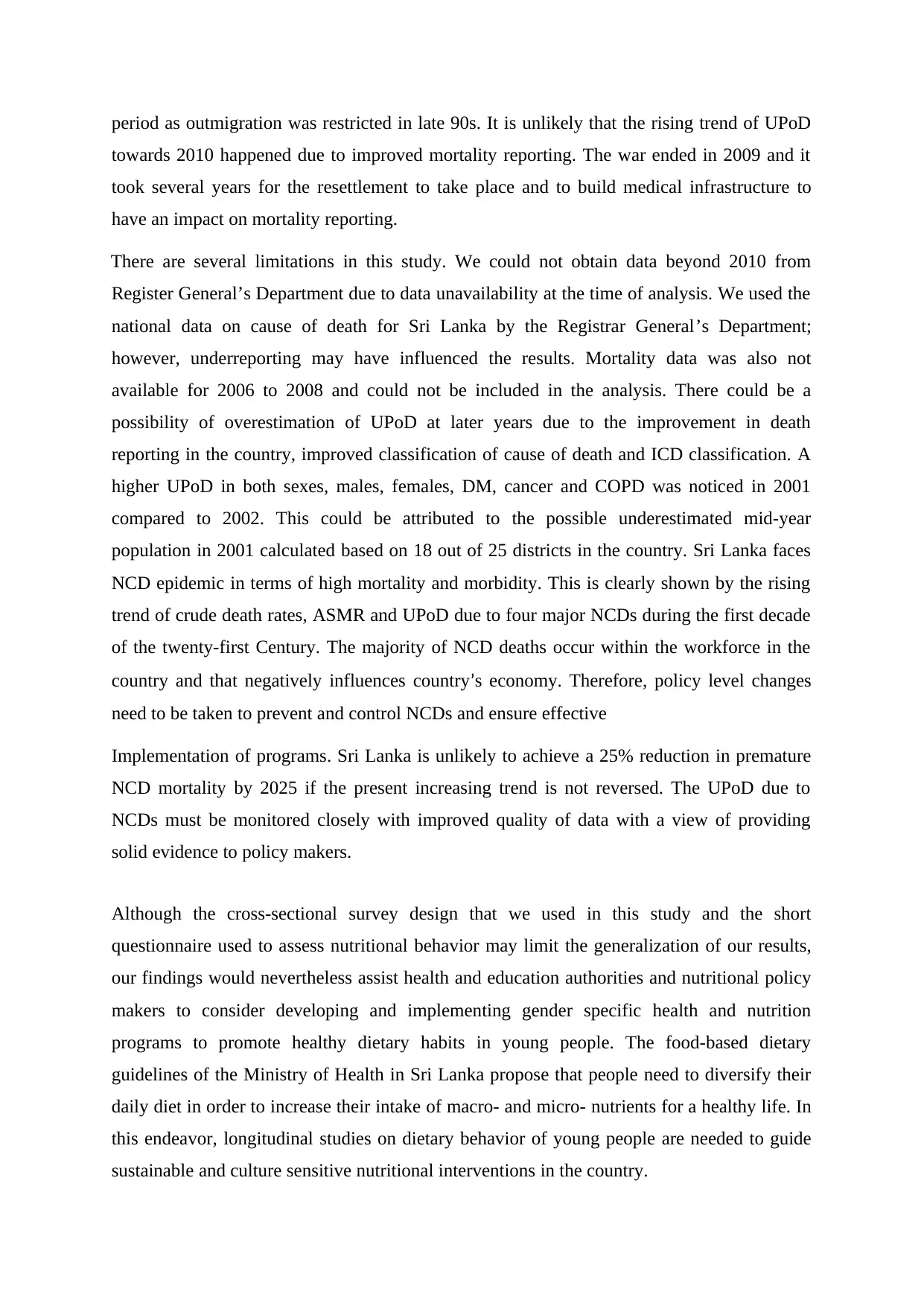
period as outmigration was restricted in late 90s. It is unlikely that the rising trend of UPoD
towards 2010 happened due to improved mortality reporting. The war ended in 2009 and it
took several years for the resettlement to take place and to build medical infrastructure to
have an impact on mortality reporting.
There are several limitations in this study. We could not obtain data beyond 2010 from
Register General’s Department due to data unavailability at the time of analysis. We used the
national data on cause of death for Sri Lanka by the Registrar General’s Department;
however, underreporting may have influenced the results. Mortality data was also not
available for 2006 to 2008 and could not be included in the analysis. There could be a
possibility of overestimation of UPoD at later years due to the improvement in death
reporting in the country, improved classification of cause of death and ICD classification. A
higher UPoD in both sexes, males, females, DM, cancer and COPD was noticed in 2001
compared to 2002. This could be attributed to the possible underestimated mid-year
population in 2001 calculated based on 18 out of 25 districts in the country. Sri Lanka faces
NCD epidemic in terms of high mortality and morbidity. This is clearly shown by the rising
trend of crude death rates, ASMR and UPoD due to four major NCDs during the first decade
of the twenty-first Century. The majority of NCD deaths occur within the workforce in the
country and that negatively influences country’s economy. Therefore, policy level changes
need to be taken to prevent and control NCDs and ensure effective
Implementation of programs. Sri Lanka is unlikely to achieve a 25% reduction in premature
NCD mortality by 2025 if the present increasing trend is not reversed. The UPoD due to
NCDs must be monitored closely with improved quality of data with a view of providing
solid evidence to policy makers.
Although the cross-sectional survey design that we used in this study and the short
questionnaire used to assess nutritional behavior may limit the generalization of our results,
our findings would nevertheless assist health and education authorities and nutritional policy
makers to consider developing and implementing gender specific health and nutrition
programs to promote healthy dietary habits in young people. The food‐based dietary
guidelines of the Ministry of Health in Sri Lanka propose that people need to diversify their
daily diet in order to increase their intake of macro‐ and micro‐ nutrients for a healthy life. In
this endeavor, longitudinal studies on dietary behavior of young people are needed to guide
sustainable and culture sensitive nutritional interventions in the country.
towards 2010 happened due to improved mortality reporting. The war ended in 2009 and it
took several years for the resettlement to take place and to build medical infrastructure to
have an impact on mortality reporting.
There are several limitations in this study. We could not obtain data beyond 2010 from
Register General’s Department due to data unavailability at the time of analysis. We used the
national data on cause of death for Sri Lanka by the Registrar General’s Department;
however, underreporting may have influenced the results. Mortality data was also not
available for 2006 to 2008 and could not be included in the analysis. There could be a
possibility of overestimation of UPoD at later years due to the improvement in death
reporting in the country, improved classification of cause of death and ICD classification. A
higher UPoD in both sexes, males, females, DM, cancer and COPD was noticed in 2001
compared to 2002. This could be attributed to the possible underestimated mid-year
population in 2001 calculated based on 18 out of 25 districts in the country. Sri Lanka faces
NCD epidemic in terms of high mortality and morbidity. This is clearly shown by the rising
trend of crude death rates, ASMR and UPoD due to four major NCDs during the first decade
of the twenty-first Century. The majority of NCD deaths occur within the workforce in the
country and that negatively influences country’s economy. Therefore, policy level changes
need to be taken to prevent and control NCDs and ensure effective
Implementation of programs. Sri Lanka is unlikely to achieve a 25% reduction in premature
NCD mortality by 2025 if the present increasing trend is not reversed. The UPoD due to
NCDs must be monitored closely with improved quality of data with a view of providing
solid evidence to policy makers.
Although the cross-sectional survey design that we used in this study and the short
questionnaire used to assess nutritional behavior may limit the generalization of our results,
our findings would nevertheless assist health and education authorities and nutritional policy
makers to consider developing and implementing gender specific health and nutrition
programs to promote healthy dietary habits in young people. The food‐based dietary
guidelines of the Ministry of Health in Sri Lanka propose that people need to diversify their
daily diet in order to increase their intake of macro‐ and micro‐ nutrients for a healthy life. In
this endeavor, longitudinal studies on dietary behavior of young people are needed to guide
sustainable and culture sensitive nutritional interventions in the country.
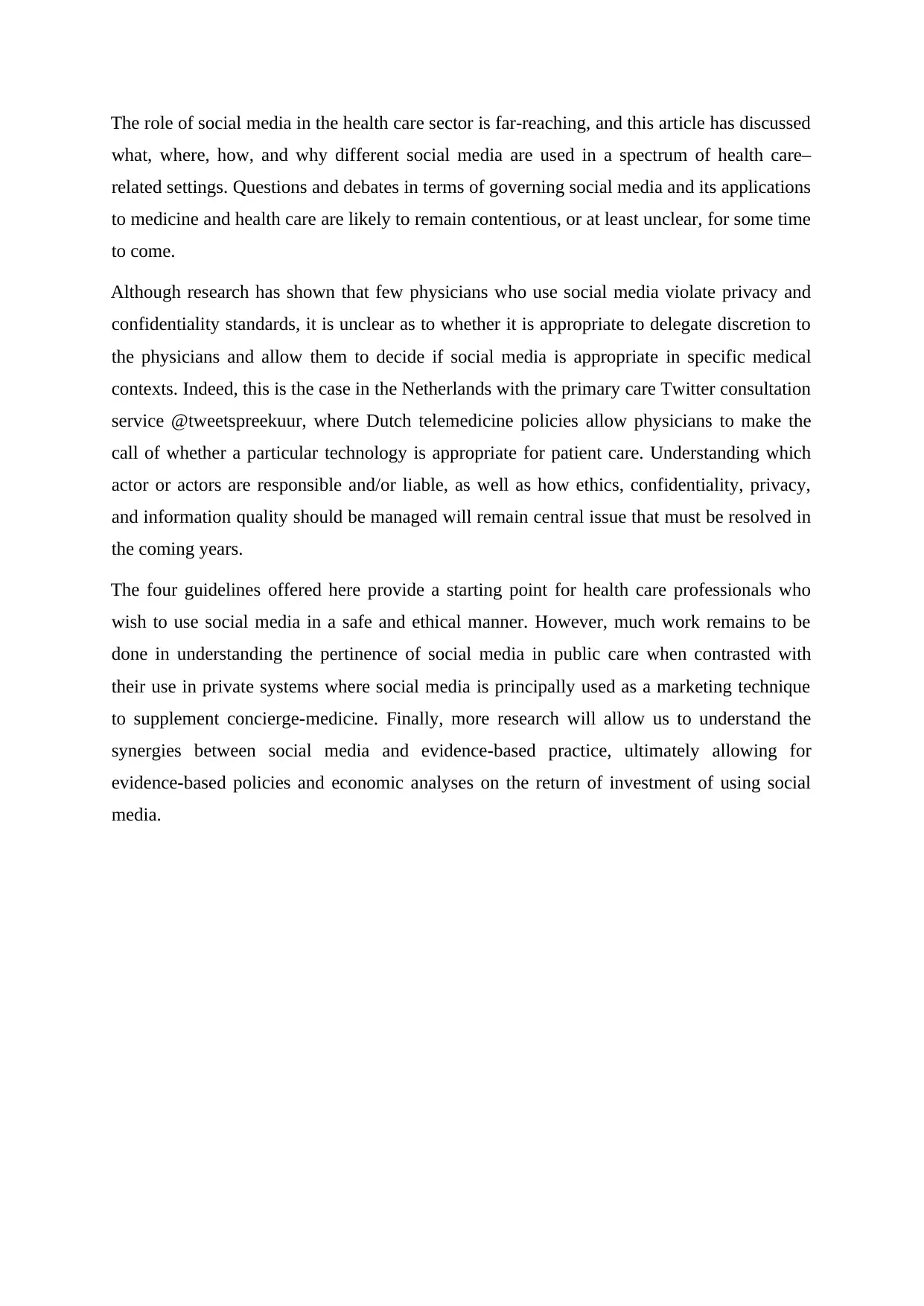
The role of social media in the health care sector is far-reaching, and this article has discussed
what, where, how, and why different social media are used in a spectrum of health care–
related settings. Questions and debates in terms of governing social media and its applications
to medicine and health care are likely to remain contentious, or at least unclear, for some time
to come.
Although research has shown that few physicians who use social media violate privacy and
confidentiality standards, it is unclear as to whether it is appropriate to delegate discretion to
the physicians and allow them to decide if social media is appropriate in specific medical
contexts. Indeed, this is the case in the Netherlands with the primary care Twitter consultation
service @tweetspreekuur, where Dutch telemedicine policies allow physicians to make the
call of whether a particular technology is appropriate for patient care. Understanding which
actor or actors are responsible and/or liable, as well as how ethics, confidentiality, privacy,
and information quality should be managed will remain central issue that must be resolved in
the coming years.
The four guidelines offered here provide a starting point for health care professionals who
wish to use social media in a safe and ethical manner. However, much work remains to be
done in understanding the pertinence of social media in public care when contrasted with
their use in private systems where social media is principally used as a marketing technique
to supplement concierge-medicine. Finally, more research will allow us to understand the
synergies between social media and evidence-based practice, ultimately allowing for
evidence-based policies and economic analyses on the return of investment of using social
media.
what, where, how, and why different social media are used in a spectrum of health care–
related settings. Questions and debates in terms of governing social media and its applications
to medicine and health care are likely to remain contentious, or at least unclear, for some time
to come.
Although research has shown that few physicians who use social media violate privacy and
confidentiality standards, it is unclear as to whether it is appropriate to delegate discretion to
the physicians and allow them to decide if social media is appropriate in specific medical
contexts. Indeed, this is the case in the Netherlands with the primary care Twitter consultation
service @tweetspreekuur, where Dutch telemedicine policies allow physicians to make the
call of whether a particular technology is appropriate for patient care. Understanding which
actor or actors are responsible and/or liable, as well as how ethics, confidentiality, privacy,
and information quality should be managed will remain central issue that must be resolved in
the coming years.
The four guidelines offered here provide a starting point for health care professionals who
wish to use social media in a safe and ethical manner. However, much work remains to be
done in understanding the pertinence of social media in public care when contrasted with
their use in private systems where social media is principally used as a marketing technique
to supplement concierge-medicine. Finally, more research will allow us to understand the
synergies between social media and evidence-based practice, ultimately allowing for
evidence-based policies and economic analyses on the return of investment of using social
media.
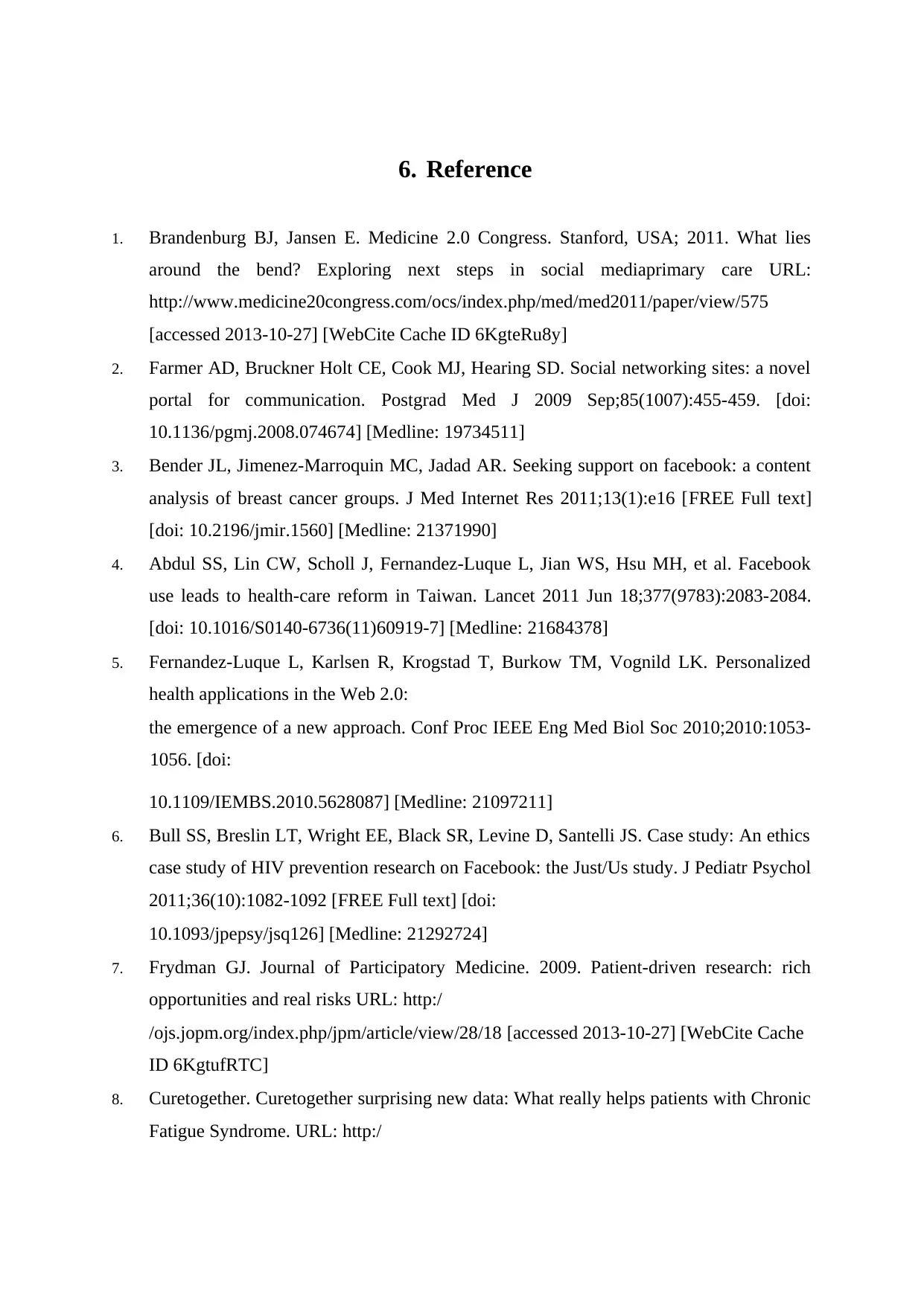
6. Reference
1. Brandenburg BJ, Jansen E. Medicine 2.0 Congress. Stanford, USA; 2011. What lies
around the bend? Exploring next steps in social mediaprimary care URL:
http://www.medicine20congress.com/ocs/index.php/med/med2011/paper/view/575
[accessed 2013-10-27] [WebCite Cache ID 6KgteRu8y]
2. Farmer AD, Bruckner Holt CE, Cook MJ, Hearing SD. Social networking sites: a novel
portal for communication. Postgrad Med J 2009 Sep;85(1007):455-459. [doi:
10.1136/pgmj.2008.074674] [Medline: 19734511]
3. Bender JL, Jimenez-Marroquin MC, Jadad AR. Seeking support on facebook: a content
analysis of breast cancer groups. J Med Internet Res 2011;13(1):e16 [FREE Full text]
[doi: 10.2196/jmir.1560] [Medline: 21371990]
4. Abdul SS, Lin CW, Scholl J, Fernandez-Luque L, Jian WS, Hsu MH, et al. Facebook
use leads to health-care reform in Taiwan. Lancet 2011 Jun 18;377(9783):2083-2084.
[doi: 10.1016/S0140-6736(11)60919-7] [Medline: 21684378]
5. Fernandez-Luque L, Karlsen R, Krogstad T, Burkow TM, Vognild LK. Personalized
health applications in the Web 2.0:
the emergence of a new approach. Conf Proc IEEE Eng Med Biol Soc 2010;2010:1053-
1056. [doi:
10.1109/IEMBS.2010.5628087] [Medline: 21097211]
6. Bull SS, Breslin LT, Wright EE, Black SR, Levine D, Santelli JS. Case study: An ethics
case study of HIV prevention research on Facebook: the Just/Us study. J Pediatr Psychol
2011;36(10):1082-1092 [FREE Full text] [doi:
10.1093/jpepsy/jsq126] [Medline: 21292724]
7. Frydman GJ. Journal of Participatory Medicine. 2009. Patient-driven research: rich
opportunities and real risks URL: http:/
/ojs.jopm.org/index.php/jpm/article/view/28/18 [accessed 2013-10-27] [WebCite Cache
ID 6KgtufRTC]
8. Curetogether. Curetogether surprising new data: What really helps patients with Chronic
Fatigue Syndrome. URL: http:/
1. Brandenburg BJ, Jansen E. Medicine 2.0 Congress. Stanford, USA; 2011. What lies
around the bend? Exploring next steps in social mediaprimary care URL:
http://www.medicine20congress.com/ocs/index.php/med/med2011/paper/view/575
[accessed 2013-10-27] [WebCite Cache ID 6KgteRu8y]
2. Farmer AD, Bruckner Holt CE, Cook MJ, Hearing SD. Social networking sites: a novel
portal for communication. Postgrad Med J 2009 Sep;85(1007):455-459. [doi:
10.1136/pgmj.2008.074674] [Medline: 19734511]
3. Bender JL, Jimenez-Marroquin MC, Jadad AR. Seeking support on facebook: a content
analysis of breast cancer groups. J Med Internet Res 2011;13(1):e16 [FREE Full text]
[doi: 10.2196/jmir.1560] [Medline: 21371990]
4. Abdul SS, Lin CW, Scholl J, Fernandez-Luque L, Jian WS, Hsu MH, et al. Facebook
use leads to health-care reform in Taiwan. Lancet 2011 Jun 18;377(9783):2083-2084.
[doi: 10.1016/S0140-6736(11)60919-7] [Medline: 21684378]
5. Fernandez-Luque L, Karlsen R, Krogstad T, Burkow TM, Vognild LK. Personalized
health applications in the Web 2.0:
the emergence of a new approach. Conf Proc IEEE Eng Med Biol Soc 2010;2010:1053-
1056. [doi:
10.1109/IEMBS.2010.5628087] [Medline: 21097211]
6. Bull SS, Breslin LT, Wright EE, Black SR, Levine D, Santelli JS. Case study: An ethics
case study of HIV prevention research on Facebook: the Just/Us study. J Pediatr Psychol
2011;36(10):1082-1092 [FREE Full text] [doi:
10.1093/jpepsy/jsq126] [Medline: 21292724]
7. Frydman GJ. Journal of Participatory Medicine. 2009. Patient-driven research: rich
opportunities and real risks URL: http:/
/ojs.jopm.org/index.php/jpm/article/view/28/18 [accessed 2013-10-27] [WebCite Cache
ID 6KgtufRTC]
8. Curetogether. Curetogether surprising new data: What really helps patients with Chronic
Fatigue Syndrome. URL: http:/
Paraphrase This Document
Need a fresh take? Get an instant paraphrase of this document with our AI Paraphraser
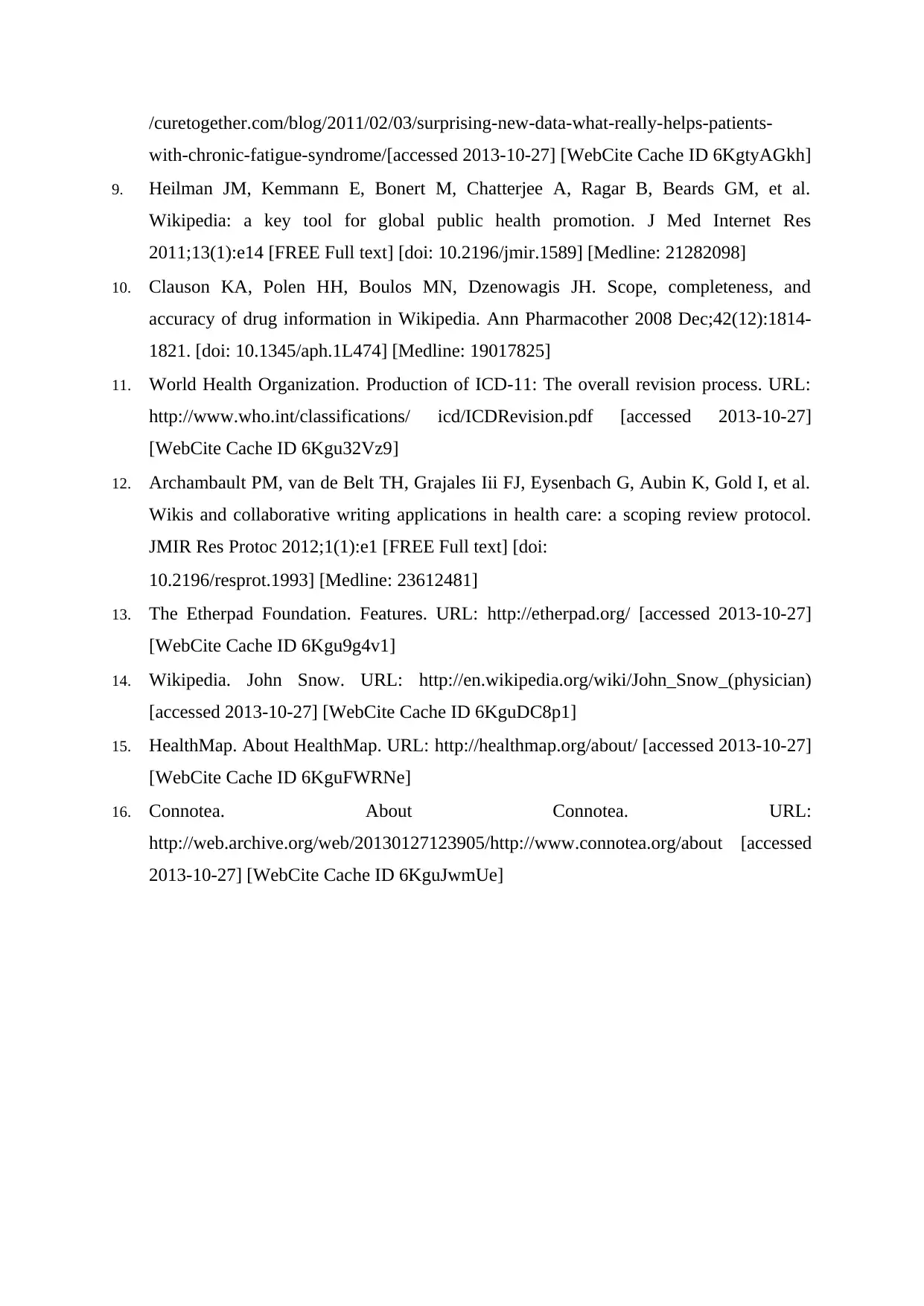
/curetogether.com/blog/2011/02/03/surprising-new-data-what-really-helps-patients-
with-chronic-fatigue-syndrome/[accessed 2013-10-27] [WebCite Cache ID 6KgtyAGkh]
9. Heilman JM, Kemmann E, Bonert M, Chatterjee A, Ragar B, Beards GM, et al.
Wikipedia: a key tool for global public health promotion. J Med Internet Res
2011;13(1):e14 [FREE Full text] [doi: 10.2196/jmir.1589] [Medline: 21282098]
10. Clauson KA, Polen HH, Boulos MN, Dzenowagis JH. Scope, completeness, and
accuracy of drug information in Wikipedia. Ann Pharmacother 2008 Dec;42(12):1814-
1821. [doi: 10.1345/aph.1L474] [Medline: 19017825]
11. World Health Organization. Production of ICD-11: The overall revision process. URL:
http://www.who.int/classifications/ icd/ICDRevision.pdf [accessed 2013-10-27]
[WebCite Cache ID 6Kgu32Vz9]
12. Archambault PM, van de Belt TH, Grajales Iii FJ, Eysenbach G, Aubin K, Gold I, et al.
Wikis and collaborative writing applications in health care: a scoping review protocol.
JMIR Res Protoc 2012;1(1):e1 [FREE Full text] [doi:
10.2196/resprot.1993] [Medline: 23612481]
13. The Etherpad Foundation. Features. URL: http://etherpad.org/ [accessed 2013-10-27]
[WebCite Cache ID 6Kgu9g4v1]
14. Wikipedia. John Snow. URL: http://en.wikipedia.org/wiki/John_Snow_(physician)
[accessed 2013-10-27] [WebCite Cache ID 6KguDC8p1]
15. HealthMap. About HealthMap. URL: http://healthmap.org/about/ [accessed 2013-10-27]
[WebCite Cache ID 6KguFWRNe]
16. Connotea. About Connotea. URL:
http://web.archive.org/web/20130127123905/http://www.connotea.org/about [accessed
2013-10-27] [WebCite Cache ID 6KguJwmUe]
with-chronic-fatigue-syndrome/[accessed 2013-10-27] [WebCite Cache ID 6KgtyAGkh]
9. Heilman JM, Kemmann E, Bonert M, Chatterjee A, Ragar B, Beards GM, et al.
Wikipedia: a key tool for global public health promotion. J Med Internet Res
2011;13(1):e14 [FREE Full text] [doi: 10.2196/jmir.1589] [Medline: 21282098]
10. Clauson KA, Polen HH, Boulos MN, Dzenowagis JH. Scope, completeness, and
accuracy of drug information in Wikipedia. Ann Pharmacother 2008 Dec;42(12):1814-
1821. [doi: 10.1345/aph.1L474] [Medline: 19017825]
11. World Health Organization. Production of ICD-11: The overall revision process. URL:
http://www.who.int/classifications/ icd/ICDRevision.pdf [accessed 2013-10-27]
[WebCite Cache ID 6Kgu32Vz9]
12. Archambault PM, van de Belt TH, Grajales Iii FJ, Eysenbach G, Aubin K, Gold I, et al.
Wikis and collaborative writing applications in health care: a scoping review protocol.
JMIR Res Protoc 2012;1(1):e1 [FREE Full text] [doi:
10.2196/resprot.1993] [Medline: 23612481]
13. The Etherpad Foundation. Features. URL: http://etherpad.org/ [accessed 2013-10-27]
[WebCite Cache ID 6Kgu9g4v1]
14. Wikipedia. John Snow. URL: http://en.wikipedia.org/wiki/John_Snow_(physician)
[accessed 2013-10-27] [WebCite Cache ID 6KguDC8p1]
15. HealthMap. About HealthMap. URL: http://healthmap.org/about/ [accessed 2013-10-27]
[WebCite Cache ID 6KguFWRNe]
16. Connotea. About Connotea. URL:
http://web.archive.org/web/20130127123905/http://www.connotea.org/about [accessed
2013-10-27] [WebCite Cache ID 6KguJwmUe]
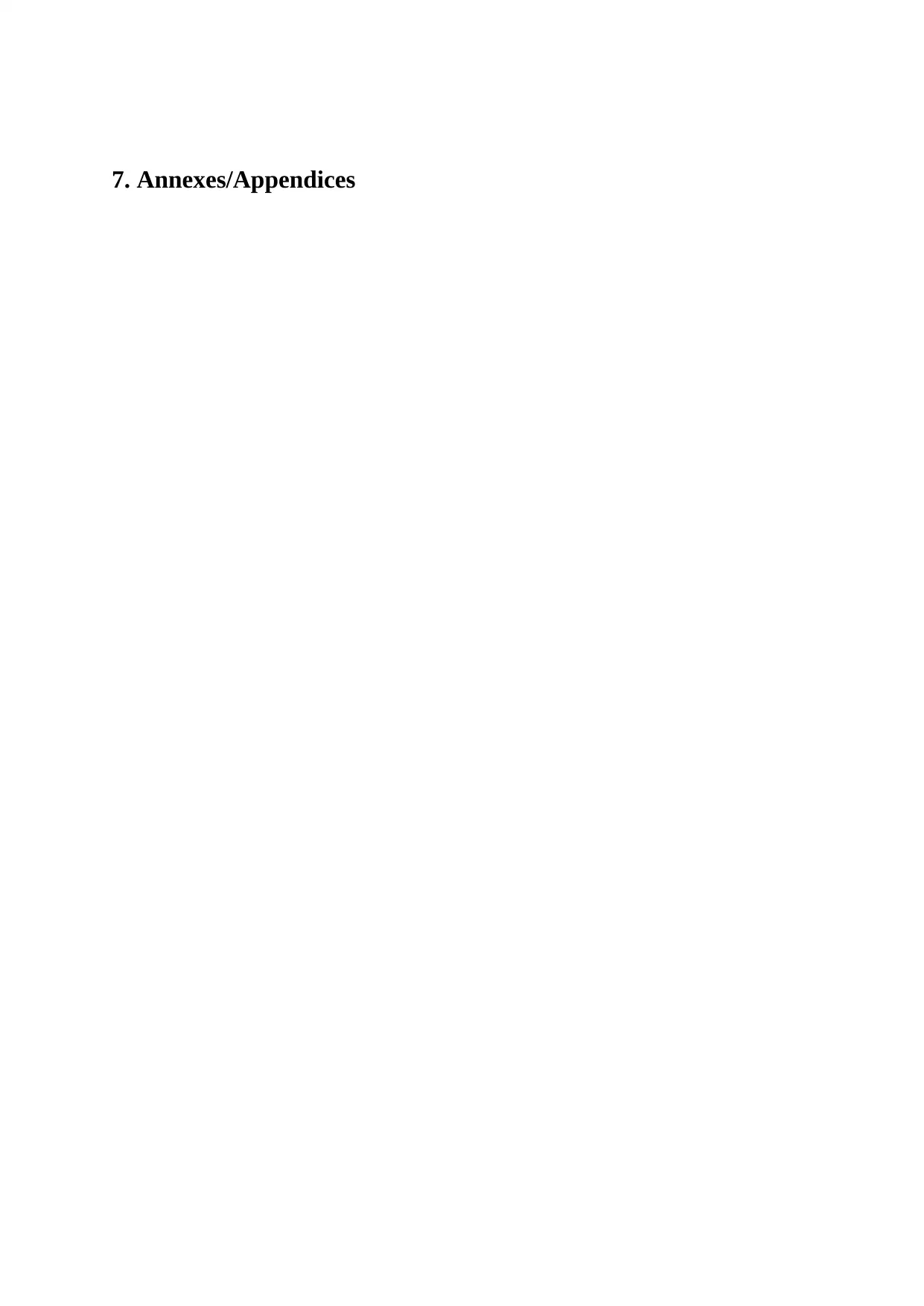
7. Annexes/Appendices
1 out of 33
Related Documents
Your All-in-One AI-Powered Toolkit for Academic Success.
+13062052269
info@desklib.com
Available 24*7 on WhatsApp / Email
![[object Object]](/_next/static/media/star-bottom.7253800d.svg)
Unlock your academic potential
© 2024 | Zucol Services PVT LTD | All rights reserved.





